Night's Black Agents by ProfessorProf
INTRODUCTION
Original SA post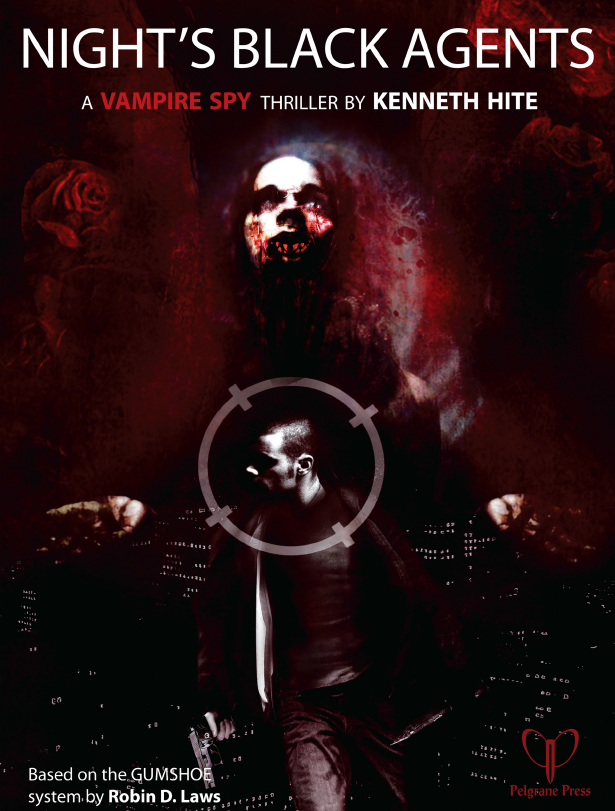
Night's Black Agents! A 2012 game for use with the GUMSHOE engine, to be used for telling spy thriller stories in the style of Bourne Identity or the James Bond films. The hook: Vampires.
My plan here is to walk through the system itself, assuming no knowledge of GUMSHOE, then do a less comprehensive overview of its massive, amazing new campaign book, Dracula Unredacted .
INTRODUCTION
The book kicks off with the setting premise and an overview of what kinds of things the
The general expected flow of a campaign goes like this:
-
Agents discover that vampires are real
-
Agents begin trying to uncover the extent of the/a vampire conspiracy
-
Vampires try to kill agents
-
Agents figure out how to kill vampires
-
Agents start cutting off the branches of the vampire conspiracy
-
Final confrontation
What are the vampires up to? What powers do they have? What do you need to do to kill them? That's all up to the
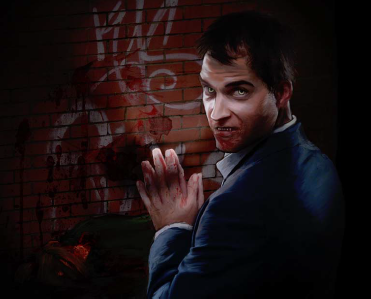
Skipping over a bit of high-level new-players stuff, we get to an overview of the book structure. Chapters waiting for us:
-
Characters:
Chargen.
-
Rules:
How GUMSHOE works, plus all the new stuff NBA adds on top of it. The meat of the book.
-
Tools:
Gear, vehicles.
-
Vampires:
Designing your campaign's vampire menace. It's modular!
-
Cities:
General design notes, plus three quick sample cities (Bucharest, London, Tunis) and one more elaborately detailed city overview (Marseille).
-
Stories:
How to run a game.
-
(S)Entries:
A sample
adventureoperation for a new group to run.
Modes
In case you thought that "vampire spy thriller" was an awfully specific niche, NBA is here to narrow it down even more, to four sub-genres of vampire spy thrillers! Each has extra rules to support its flow, each has extra advice and content scattered throughout the book, and it's possible to combine them willy-nilly for your own particular style of game.
In a Burn game, war is hell, and the emphasis is on the psychological toll it takes on the heroes. Stability (the SAN equivalent of the day) can't go above 12, and there are a hell of a lot more ways to lose it.
In a Dust game, high-octane action takes a backseat to espionage and intrigue. Agents are smart and resourceful, but have less tools for fighting vampires head-on. Most abilities don't give extra bonuses at 8+, Health can't go above 10, most fancy combat rules are out.
In a Mirror game, your allies are as big a danger as your enemies. Everyone's true motives are obscured by a labyrinth of shifting allegiances and hidden agendas. Players track Trust and Betrayal against each other as the game unfolds.
In a Stakes game, you're not just trying to survive or complete the job - this time, it's personal. Characters have Drives that push them forward, rewarding risky or self-sacrificial behavior to serve a higher purpose.
As the book does, I'll highlight where these four Modes touch the rules of the game, or inform the kind of things the Director might throw at you.
Next: Chargen, and some of those keywords start to actually mean something.
CHARACTERS
Original SA post
CHARACTERS
Chargen is broken down into four steps:
-
Pick Backgrounds, get Cover and Network
-
Pick Investigative Abilities
-
Pick General Abilities
-
Dossier
Backgrounds are the closest thing Gumshoe has to character classes/archetypes/templates. They're theoretically optional - each one is just a bit of backstory attached to 6 points of Investigative Abilities and 18 points of General Abilities. For example!
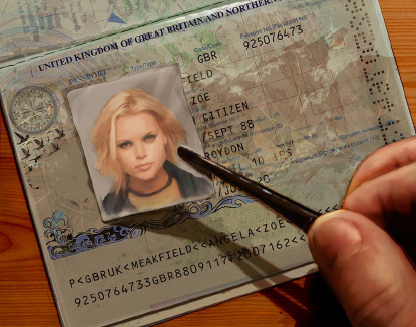
Cobbler is British spy lingo for someone who assembles fake passports, visas, and other bits of image manipulation and document forgery. If an agent picks the Cobbler background, they get:
Investigative Abilities: Forgery 4, Bureaucracy 1, Photography 1
General Abilities: Cover 6, Digital Intrusion 4, Infiltration 4, Disguise 2, Mechanics 2
You can take as many as you want, but you buy them with your general character building points, so they're not free - they're just an easier way to springboard into picking skills off of big lists.
Investigative Abilities are the meat of GUMSHOE. Unlike skill contests in most games, Investigative Ability checks always succeed . If you have points in Accounting, you'll always find the clue you need from searching through a company's financial records. There's some rolling and uncertainty involved, but it's only for getting extra spicy benefits from the investigation; you're guaranteed to get the minimum you need as long as you have the skill written down. Your final rating in each investigative ability is actuall a pool of points - if you have Traffic Analysis 3, then you have 3 points you can spend during an operation to gain extra benefit from using the ability, which refresh under certain circumstances. More on that later.
Each agent gets a pile of investigative build points which can be spent 1-for-1 to increase Investigative Abilities. One point in an ability means you're already a badass expert in that field, two or three mean you're one of the top agents in the world in that field. The number of points you get varies based on the size of the party from 32 points at 2 players to 20 points at 5+ players - this is so that the party will generally have most or all investigative abilities covered between them, meaning that a key clue is seldom locked behind a skill that nobody has.
Non-comprehensive notes on a few of the investigative abilities:
Bullshit Detector
You can tell not only when someone is lying, but also when someone is projecting a false impression or hiding information. Works best on the nervous or the guilty, may not be as much of a guarantee against lifelong con men or the undead.
Data Recovery
Most of what people do with computers in modern crime shows. There's a specific usage listed for being the implausible "Stop! Zoom! Enhance!" guy, with an attached note that you can't do that in a Dust game.
Forgery
What it says on the tin - mainly used as an investigative version of Disguise. You don't need to stop and create your forgeries in advance; you can use the ability to reveal in the heat of the moment that you had a stash of Romanian Foreign Ministry stationery handy all along. In addition to forging things and spotting forgeries, for each point you put into the skill, you can declare yourself 'untouchable' in one narrow field - American passports, Turkish entry visas, et cetera. When making those, your forgeries are absolutely perfect, and can't be seen thruogh by any means short of your own confession.
Languages
If you have Languages 1, you can speak and write fluently in two languages other than your native tongue. A second point gives you three more languages, and each point after that gives you four more languages - so, if you have Langauges 4, you could be fluent in English, French, Spanish, Portuguese, German, Italian, Turkish, Romanian, Russian, Arabic, Japanese, Mandarin, and Hindi. You can also use individual language slots for lip-reading, ASL + other common sign languages, or multiple related languages in one slot (for example, Norwegian and Swedish). Everyone gets English With A Bad Accent for free if they don't speak English, to ensure the party has a common language.
Vampirology
Knowing about both fictional vampires and real vampires, and being able to tell the differences between the two. Depending on the game, this ability may not be allowed at chargen.
General Abilities are everything other than investigation - fighting, driving, anything you need to be good at that doesn't relate directly to uncovering clues. Unlike investigative abilities, you DO roll to succeed on general abilities, and they can fail completely. When you use a general ability, you roll a six-sided die and may add points to the roll from that skill's point pool. The higher the number, the better you do.
The scale is different for general abilities - everyone gets 70 points (65 in Mirror , 55 in Dust ) to buy general abilities. Unlike investigative abilities, there's no real upper limit to how many points you can shove into something before it stops being useful, so it might be a good idea to focus more on a smaller number of general abilities instead of dropping 1-2 points onto everything. The only capping rule is that the highest ability on your sheet can't be more than double the rating of the second-highest ability - So, if you want to have 20 Health, you must have 10 in something else. As a new agent, you get four skills for free - Health 4, Stablity 4, Cover 10, Network 15. These don't count towards the second-highest ability rule.
When picking your general abilities, you can designate one as your MOS - Military Occupational Specialty. The name is just a cooler way of saying Schtick, it doesn't require an actual military background. Once per session, you can invoke your MOS to automatically succeed at using a general ability. Invoke MOS Driving to automatically intercept another car. Invoke MOS Shooting to automatically shoot and kill a human target. It can only fail if your task is actually impossible or if you're up against a major supernatural threat - even in the case of the latter, you could use an MOS to guarantee a direct hit on a vampire, just not also guarantee that it dies. You don't get an MOS in Dust .
Most general abilities have a cherry - a special ability that kicks in once you reach a rating of 8 or higher in it. A Director who wants a slightly less ridiculous game can push the cherry perimeter up to 12. You don't get these at all in Dust , with a few exceptions.
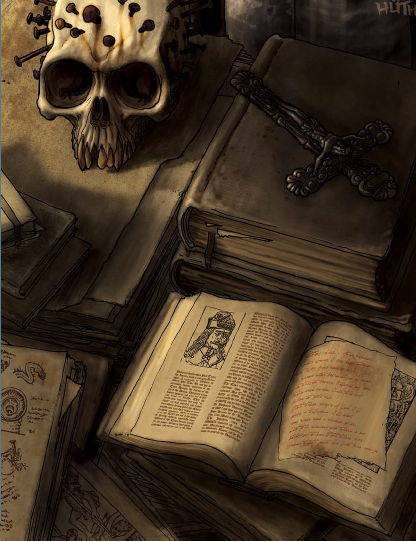
Some general abilities:
Athletics
Any physical activity not covered by another skill. At 8+, you get the cherry Hard to Hit , which raises the difficulty of rolls to hit you in combat by 1, and also gain access to a few extra rules and options in combat, like Parkour (more on that later). The first half of that is available even in Dust games.
Cover
Your stash of false identities. Everyone gets this skill for free at 10. At any time during play, you can reveal the existence of another cover identity - to do so, you split a number of points off of your Cover pool into a new pool of points specifically for that identity. Those are the points you spend when you want to lean on that identity to get things done or stay incognito - when it runs out of points, that identity has been compromised and won't protect you any more. Unlike most skills, the Cover pool can't be refreshed after or during operations.
Disguise
What it says on the tin. At 8+, you get the cherry Connected Cover , which lets you spend your Cover points to create a more targeted identity - instead of your identiy being "Joe the Generic Engineer", your cover identity can now be "Suslov, who did the Trieste Job with Arpad 5 years ago", well enough to help you get close to Arpad.
Hand-to-Hand
Fighting unarmed, be it martial arts or bar brawling. Can also be used as an Investigative ability to determine where a fighter trained, et cetera. At 8+, you get the cherry Eye of the Tiger , which lets you spend a point of Hand-to-Hand to measure up the skill of an opponent - the Director will tell you whether his Hand-to-Hand rating is within 1 point of yours, higher, or lower. This cherry is available evenin Dust games.
Health
Ability to not die - your Health pool is functionally your HP. It's different from other ability pools in that it can go negative. You get 4 points for free, and it caps at 10 in Dust games.
Network
Your web of contacts. This ability works like Cover - when you declare a new contact, you split off points from your Network pool to be that contact's pool of points. Once the run out of points, they are found by your enemies, and probably either killed or turned against you. In Mirror games, once per session, the Director picks one of the party's contacts, and secretly rolls a die. If the result is higher than the number of points in that contact's pool, he flips the contact - either they've been recruited by the enemy, or they were a double agent all along. In Burn games, your starting Network is reduced - from 12 for 2 players, down to 4 for 5+ players - and you lose 1 Stability every time you lose a contact.
Stability
Health, but for your brain. It can also go negative. You get 4 for free, and in Burn games it caps out at 12.
There's a lot more general abilities - Filch, Mechanics, Piloting, Sense Trouble, Weapons, etc - but you get the idea, probably.
Personality and Dossier
For the most part, this is fluff, but not all of it. At the top of this section is Sources of Stability , a special rule for Burn , Mirror or Stakes games. What keeps your agent sane? Why do they keep struggling against the darkness? This is why - an agent's source of strength, but also a potentialy vulnerability.
Symbol
A crucifix, your father's dog tag, something physical you can carry with you that reminds you why you fight. Once per session, you can use it for a few minutes of quiet meditation or reverence, and refresh 1 point of Stability. However, if you permanently lose it, your Stability rating drops by 1.
Solace
A person, unconnected to your ongoing battles, who you turn to for quiet human contact. Could be a romantic partner, could be something else. Once per session, if you can spend six hours off the job with your Solace, you refresh 2 points of Stability. If you spend a full day with your Solace between operations, you refresh all Stability. In a Burn or Mirror game, betrayal by your Solace drops your Stability rating by 2. If your Solace is killed or turned into a vampire in a Burn game, you lose 3 Stability rating.
Safety
The one place where you feel truly safe, a personal refuge against the world. If you reach it and rest there, you can refresh three General ability pools, and you can make Preparedness tests at lower difficulties. If you get there unobserved by enemies, you can refresh your whole Stability pool. If your place of Safety has an owner or caretaker, you can activate them once, in your character's lifetime, as a free contact with rating 6. They cannot be rebuilt with points from Network or character advancement, period. In a Mirror game, your Stability drops by 3 points if your place of Safety turns you out or its owner betrays you. In a Burn game, the same thing happens if your place of Safety is destroyed.
Next, Drives are the core of any Stakes game. A character's chosen Drive is their motivation, the reason they keep going. They function sort of like Aspects in Fate - they don't force you to do things, but the reward behaviors in line with your character. If you act dramatically and at great risk because your Drive compels it, you can refresh 1-2 points to one of your general ability pools. If you stubbornly work against your Drive, you become stressed, raising the cost of all Investigative Ability spends by 1 point and the difficulty of all General Ability tests by 1 until you return to form.
There's a long list of Drives - Altruism, Atonement, Nowhere Else to Go, Revenge, et cetera. Some have extra details suggested for different game modes, but they're mostly self-explanatory.
As another optional step, Mirror games require an extra section on your sheet: Trust . You get 5 points of Trust to start, spread between your other party members: 3 with the one you trust the most, 0 with the one you trust the least, and 1 trust each for up to two others. For extra hardcore Mirror play, record these values in secret.
Trust, like all other ratings, is a point pool. You can spend points of your Trust pool for another agent to help them out, effectively acting as if they spend that point themselves on one of their own abilities. On the flip side, if you betray another agent, you can spend their trust against them - each point spent blocks one use of an investigative ability, or redues a general ability roll by 3. You can also do this to gain +2 per point on a roll of your own, but only if that roll hampers the agent who trusts you. The more you trust someone, the easier it is for them to hurt you.
Everything past that is the fluff of backstory. When did you become an agent? Where did you learn your skillset? What kinds of missions have you gone on in your vampir-free past? Why did you retire from that life? Sort out the details, and the character is done.
Next: The actual rules.
RULES, PART 1
Original SA post
RULES, PART 1
As established, NBA is a GUMSHOE game, so the first part of this is about the GUMSHOE engine and how to use it. The first and most important part of this is Clues . You're solving a mystery and unraveling a conspiracy, so you need to find a lot of clues. However, the book puts this in big, bold letters at the top of this section:
quote:
Intelligence operations are not about finding clues. They are about interpreting the clues you find.
This is sort of the core idea of GUMSHOE. Think of it like a Sherlock Holmes mystery: Holmes never accidentally overlooks clues. The clue-finding isn't the meat of the story, it's the setup. The fun part, the interesting part, is putting the clues together to uncover the truth. So, in GUMSHOE, uncovering clues isn't a matter of 'if', but of 'how'.
So, to get a clue, you must do three things: Get into a scene where there are clues, have the ability needed to find a clue, and use the ability. It is never dependent on the die roll. If I say "I use Chemistry to test the blood sample for silver", I get that information. If I use Notice to search the alley for hidden objects, and the killer discarded his knife in the alley, now I have the murder weapon. It's that simple.
Okay, maybe not exactly that simple. Depending on the level of desired player skill necessary, the Director may offer some clues automatically via 'passive' use of investigative abilities. There's a lot of guidance about how to rework all of this to avoid having to call attention to the game rules by saying specific ability names during play. Some clues can be found without using abilities, if all that's needed is a simple search.
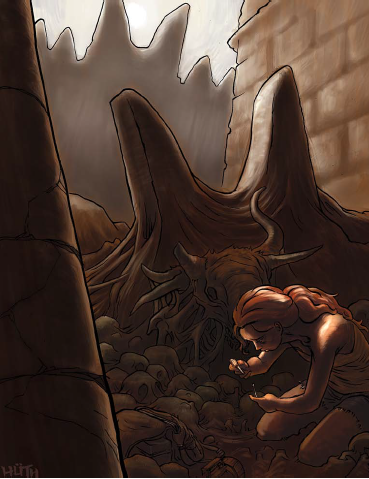
As mentioned before, every ability is a pool of points. With investigative abilities, these points are spent to get further information, beyond the main clue, effectively giving your character a brief moment in the spotlight. The more points you spend, the more details you get. Even if you spend all the points in your pool, you still have the ability, so you can still get basic clues for it.
The book gives this nice example:
quote:
“What do I know about Montreuil?” you ask. “I have 3 points in History.”
The Director answers: “It began as a monastic settlement around 780 A.D. The monastery was the main draw here until the French Revolution, when it was shut down — this is probably one of the old monastery complex buildings. Plus, it’s where the French film industry began in the 1890s.”
“That seems pretty sketchy. I’ll bet there’s more going on here, if only because this was once consecrated ground. Ideal vampire turf... I want a full information dump on this place; can I spend 2 points of History to get it?”
“Uh, sure,” the Director says. She actually has two pieces of information, labeled as 1-point spends for Occult and Architecture, but History works, too, with a bigger spend. She gives the Architecture spend first: “One of the designers of Notre Dame was Pierre du Montreuil; he may have built other works of sacred architecture in his home town for the monks.” Which leads into the Occult information: “Certainly a dissident sect of Freemasons thought so when they took over a 12th-century building in Montreuil as their cult center in 1791. The Ordo Sola Obscura, the Order of the Obscured Sun. They vanished during the Occupation.”
“Wait,” you say: “Obscured Sun? That’s got to tie into the camera obscura, which means that film thing probably leads somewhere too. Plus, who likes an obscured sun more than vampires?”
Now you have three more leads to follow: the career of Pierre du Montreuil, who may have built sorcerous or ritual crypts; the Sola Obscura and their possible heirs in modern France; and any vampiric involvement in the film industry in Paris. Plus, you’re pretty sure there’s a medieval crypt under here just boiling with dark ritual power: “Everybody get those sun lamps out; when we find it, we’re going into that crypt on full UV.”
The Director says “That’s going to take a lot of power,” as she adjusts her notes to reflect that the sorcerous darkness in the crypt has lost the element of surprise.
So, having the ability at all means that you can get all the floor-level clues, but putting more points into it means that you get more time in the spotlight as your specific expertise extracts more clues out of the situation. Ideall, these bonus clues won't be necessary to finish the operation, but will give you an advantage down the line.
Now, not everything you do in the game is clue gathering - most of the rest is Tests . These are more like traditional skill checks, with a random chance of failure. Every roll in GUMSHOE is of the form 1d6+X, trying to match or beat difficulty number Y. X is the number of points spent on the test - you can always roll a flat 1d6, but if you're doing a Driving test, you could spend 2 points from your Driving pool before rolling to instead roll 1d6+2. Doing so would reduce your Driving pool, but not your Rating in the ability - if you get a chance to Refresh the skill, you would regain the 2 lost points.
Failure, as in any good storygame, doesn't necessarily mean failure. It may mean success, but with a cost - you fail your Digital Intrusion test, and you still get the data, but one of the enemy hackers managed to pinpoint your safehouse location before you could disconnect. If you really do fail, though, then it's sometimes possible to retry - but only if you spend more points on the second attempt than you spent on the first.
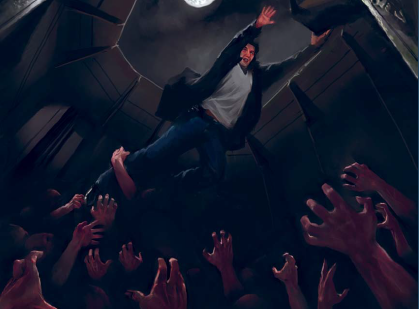
The game is nice enough to offer multiple distinct forms of teamwork rules, depending on the kind of action. If two people are working together on something, they can Cooperate . One is designated as the leader, and spends points on the roll as normal. The other is designated as the assistant, and spends points in his relevant ability as well - however, his benefit is reduced by one. So, if the assistant spends 3 points, he increases the roll by 2, not 3.
If a bunch of people are doing something difficult together - the classic example being sneaking into a building - they can do it via Piggybacking , where one character acts and multiple characters benefit from it. Each person trying to ride on the leader's roll pays 1 point from a relevant ability pool, then the leader rolls as normal - if they succeed, everyone gets to ride that success together. If someone doesn't have the ability, or is out of points, they can still piggyback, but it increases the leader's difficulty target by 2.
If it's not a Clue, and it's not a Test, it's probably a Contest! That means two people are acting in opposition to each other. If one of them is an NPC, the simplest way to do it is just as another Test - if they beat Difficulty X, then they reach the detonator first. More cunning or powerful enemies can be represented by higher difficulties to overcome.
For more important or nuanced conflict, though, you want a Full Contest. In this, each character acts in turn, rolling the relevant ability against a difficulty number of (usually) 4. The contestants keep rolling in turn until one fails the roll, at which point the other wins. If the situation is unbalanced, one may have a higher target number than the other. It's an unusual system, having both sides rolling against the same flat difficulty, but because it always costs points to boost a roll above 1d6, neither side can hold out forever.
There's one kind of contest, very common in the genre, that NBA goes to great lengths to lovingly recrate: The Thriller Chase. Car chases! Parkour pursuit through crowded streets! Knocking over fruit carts!
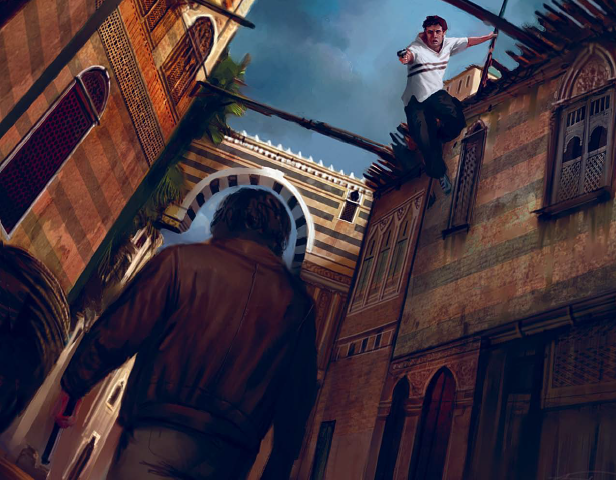
Chases work a little different from Full Contests. First change: Point expenditure is done in secret and revealed simultaneously. Once both sides have revealed their points spent, both roll as normal. Then, instead of ending if somebody failed, the results are applied to the runner's Lead. Lead usually starts at 5 - if it reaches 0, the runner is caught. If it reaches 10, the runner escapes.
Each turn, the rolls made by the runner and the pursuer affect the Lead. If runner succeeds and pursuer fails, Lead goes up by 2. If pursuer succeeds and runner fails, Lead drops by 2. If both succeed or fail, you compare the margins of success. If the pursuer won by more or lost by less, Lead goes down by 1. Otherwise, it goes up by 1. Repeat, with gradually escalating flavor elements (catwalks, conveyor belts, open-air fish markets, pairs of oblivious people carrying huge sheets of glass across the street), until the runner escapes or is caught.
At the start of a round, the runner can try to escalate the chaos of the chase - charging into oncoming traffic, jumping a fence into a railway yard as trains barrel by, anything that makes everything scarier. This raises the difficulty of everyone's next roll by 1; if they fail, the chase difficulty drops back down to its original level next turn. Otherwise, it stays where it is, and the runner could choose to raise it again. If both succeed at the raised roll, then the runner can choose to lower the difficulty, but only if the pursuer agrees.
Attacking is possible during a chase - the most obvious case for this is the passengers in a car chase shooting at the other car. I won't go over all the details of it yet since we haven't even hit the combat chapter, but there are rules for jumping from car to car, shooting out tires, using investigative abilities creatively to influence the chase, ramming other cars... there's even rules for passing the wheel to an NPC so that you can jump onto another car or steady your rocket launcher through the sun roof. This shit is thorough.
A couple abilities have extra cool cherries based on lavish description during action. Athletics 8+ gives you the "Parkour" cherry, which lets you refresh 3 points of Athletics once per chase by throwing out some kind of lavish description of the moves involved, like "With a flowing passe muraille, I step up off the fire escape, grab the parapet, and flip myself onto the roof." There's a similar rule for Driving/Piloting ("The characteristic stiff suspension of my Jaguar XKE keeps the center of gravity low, putting all the torque into cornering."), and later for Clancy-esque gun porn monologues ("As I fire one of its trademark bursts from the HK UMP, I take a deadened, existential solace from the soulless blankness of its polymer casing.").
If multiple pursuers are chasing one runner, they can Cooperate on the rolls (this is the only circumstance when more than two people can use Cooperation rules). If the multiple pursuers are a swarm of mooks, instead just give them more points in their ability pools to represent the added manpower. If the police crash a chase between two other parties, it becomes two chases at once - the pursuers in the original chase are now also the runners in a second chase where the police are the pursuers. You should probably try to avoid this scenario unless you like some complicated bookkeeping.
Next: Violence.
RULES, PART 2
Original SA post
RULES, PART 2
COMBAT
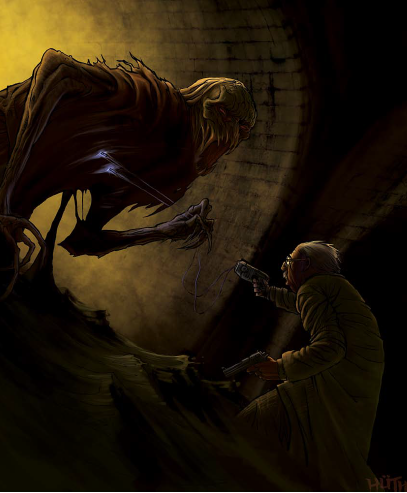
So, a lot of this will look familiar if you've played a couple different systmes before. Combat rolls are made with the abilities Hand-to-hand, Weapons, and Shooting - whoever has the highest skill rating gains the initiative. The agents can try to get the jump on the enemy (usually Difficulty 4) - Surprised characters go to the end of the initiative, and have +2 to Difficulty on all rolls they make that round.
Attack rolls are made by rolling combat abilities against a character's Hit Threshold - 3 by default, or 4 if their Athletics rating is 8 or higher. Enemies may have Hit Thresholds that are as low as 2 (for huge creatures or hapless civilians) or as high as 5 and beyond (for deadly supernatural threats). If you match or beat their Hit Threshold with a combat skill, you roll a die and do that much damage. The damage gets a modifier based on your weapons, ranging from -2 (fists) to +2 (assault rifle). Guns do extra damage at point blank range, especially shotguns. Armor can reduce damage from attacks.
If you take damage, you lose that many points from your Health pool. If the pool empties, that means you drop from exhaustion or blood loss... usually. Health is an ability, and this is when it's used. When you drop to 0 or less Health, make a Consciousness Roll - if the result beats the absolute value of your negative Health, you remain conscious, and can still act. This is an ability roll, so you can spend Health to increase your chances of passing the roll - even if it would push you into the negatives (the difficulty is based on your health before spending any on this roll).
Book example:
quote:
Ghouls are chasing you through a burned-out church in Norway, after a surveillance attempt that did not go your way. They hit you with a harpoon, dropping your Health pool to –3. You would really rather not gather first-hand intel on ghoul feeding habits, so you must remain conscious. The absolute value of –3 is 3, so this is the Difficulty of your Consciousness roll. You spend another 2 Health points you don’t have, pushing yourself on toward the sunlight outside where you left the car.
That spend gives you a bonus of 2 to your roll. You roll a 4, for a final result of 6. You remain conscious and get away, but now your Health pool is down to –5.
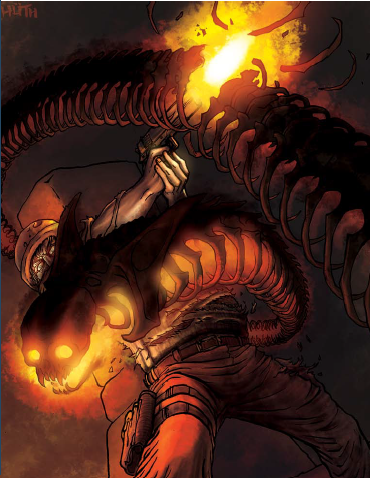
Whenever your Health pool is between 0 and -5, you are Hurt. All rolls you make have a Difficulty that's 1 higher. A Consciousness Roll is required to use any investigative abilities. From -6 to -11, you're Seriously Wounded. You can't fight, and lose an additional point of Health every half hour unless stabilized by a character with the medic ability (Difficulty 3). A serious injury can only be fully restored by spending days equal to your negative health hospitalized and inactive. On the day of discharge, your Health pool refreshes to half its rating. The next day, it refreshes to full.
-12 or below, and you're dead. Roll up a new character.
There's a lot of things that can affect combat to make things even more complicated, of course:
-
Armor
reduces the damage you take from attacks, potentially down to 0. For example, light tactical body armor reduces damage from bullets by 2 points and from stabbing or cutting weapons by 1 point.
-
Cover
is an assumption in gunfights. If you're fully exposed, your Hit Threshold is 1 lower against firearms; Full Cover increases it by 1 instead.
-
Range:
Range goes by categories - Point Blank (hand-to-hand fighting range, guns do extra damage), Close (same room, shotguns do extra damage), Near (across the street, outer range of thrown weapons), Long (100 meters, only rifles are effective).
-
Explosions:
An explosion has three ranges - damage range (you take a lot of damage), debris range (Athletics check to not take extra damage), annihilation range (send in a Cleaner to get your DNA off of the walls, better luck next time). Don't be at ground zero when a rocket hits.
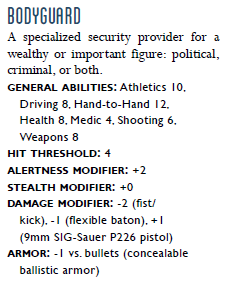
The book goes on to give a nice list of generic enemy statblocks. A sidebar earlier mentions that any of these can be adjusted to be a generic mook by dropping the Health to about 2, and their Hit Threshold to 3. Mooks always drop at Health 0, and are encouraged to be placed where they can be shot off of balconies or taken out from behind with a karate chop. In Dust games, there are no mooks, only real threats.
So far, this has all been fairly standard GUMSHOE combat. However, NBA offers a whole second layer to its combat system, called Thriller Combat .

Thriller Combat is a collection of special combat mechanics that make things more exciting and fast-paced. The Director is encouraged to pick and choose which ones they want or don't want the party to have access to, based on the kind of game they're after. If they want some special abilities to be more common, they can even reduce the requirements for them.
Most Thriller Combat options are not available in Dust games.
Autofire
Machine guns in action movies are way less dangerous than in reality - Autofire rules make them much more dangerous. If you score a hit with an automatic weapon, you can spend 3 Shooting points to do your damage twice, or 6 points to do it three times, et cetera. So, if I hit an enemy with a machine gun, I could do 1d6 damage, or I could spend 9 Shooting to bump it up to 4d6 damage. If multiple unimportant enemies are clustered, each die of damage can be applied to a different target.
Called Shots
For when hitting the center of mass just isn't enough. You name a specific part of the enemy target, the Director raises the Hit Threshold for the attack by 1 (Large carried object) to 4 (Eye). If you hit, you can damage a held object, knock a weapon out of someone's hand, or do +2 to +3 damage for hitting vital areas. This is allowed in Dust , but only for certain targets - you can't shoot a gun out of someone's hand without hurting him.
Disarm
Speaking of which, Disarm is a special kind of Called Shot made against an enemy's weapon. If you make the hit with Shooting, you knock the weapon out of their hand and probably damage it. If you make it with Weapons, you disarm the enemy, but only if your weapon is heavier or you rolled an unmodified 6. If you make it with Hand-to-Hand, then you're struggling over grip of the weapon with the other guy until next turn - and you can spend 3 Weapons or Filch to steal their weapon for yourself, if it's light enough.
Critical Hits
When you roll an unmodified 6, and beat the enemy Hit Threshold by 5 or more, you crit, rolling damage twice and adding the results together.
Evasive Maneuvers
Available in Dust games. At the beginning of a round, you can Go Evasive, spending up to six Athletics points - for each 2 points you spend, your Hit Threshold is 1 higher that round.
Extra Attacks
If you have 8+ rating in the combat skill you're using, and have a lighter weapom, you can push yourself to go for extra attacks. If you hit with a melee attack, you can spend 3 Hand-to-hand/Weapons and 2 Health to immediately make a second attack. You can do the same thing with a gun attack, but the cost is 4 Shooting and 1 Stability. The cost for a third attack is doubled, and a fourth attack is tripled. If your second attack is against a different target, their Hit Threshold is 2 higher.
Two-Fisted Firearms
If you have a pistol in each hand, you can spend 3 Shooting and 2 Athletics to fire both. If the shots are at different targets, the second one's Hit Threshold is 2 higher. If you want to combine this with Extra Attacks, the second attack also uses both guns, but costs 9 Shooting and 6 Athletics.
Feints
When using Hand-to-Hand or Weapons, you can forego your attack on a turn and spend up to 3 points from the relevant skill to do a feint attack. Doing so lowers their Hit Threshold by 1 per point spent until the end of your next round. Multiple Feints can't stack.
Jumping In
Called out in the book as one of the most important reasons to invest in a lot of Athletics. As long as you haven't acted yet during the current round, you can spend 4 Athletics or 3 Shooting/Weapons/Hand-to-Hand to Jump In - you take your next action immediately, instead of whenever your turn was going to be. If multiple characters tr to Jump In at the same time, PCs get priority over NPCs. At the end of a round, you can Jump In to go first in the following round.
Martial Arts
Like the previously-mentioned Parkour skill - once per fight, embellish an attack with a lavish martial arts description ("With a flowing Kata Gurama, I try to sweep him up onto my shoulder and down to the pavement") for a free Refresh of 3 points for Weapons or Hand-to-hand.
Mook Shield
If you have 8+ points in Hand-to-Hand, you can spend 3 points of it to make an attack against an enemy mook. On a success, you pull them into a hold that uses them as a human shield. You get full cover, and any attacks that miss you hit the mook instead. Furthermore, the mook provides 4 Armor against incoming bullets, losing 4 Health for each bullet they obligingly absorb for you. Firing a weapon requires you to either drop the mook or spend 3 Shooting points.
Reckless Attacks
By spending 1 Athletics, you can abandon all defense to go all out, lowering your enemy's Hit Threshold by up to 3 against attacks from you. However, your own Hit Threshold drops by the same amount - and does so against all attacks.
Smashes and Throws
Available in Dust games. You can spend 2 Hand-to-Hand points to do a special attack against a nearby enemy. You can Smash them into something hard and painful, increasing the -2 damage of an unarmed attack to -1 or +0, or you can Throw them, launching them to Close range and to the end of the turn order. If you throw someone at a window, the Hit Threshold is 2 higher, and if the window isn't broken they'll only go through on an unmodified 6. Agents and named NPCs can roll Athletics (Difficulty 5) to grab the frame and not fall to their doom.
Special Weapons Training
If you have 8+ in Shooting or Weapons, you can spend build 6 points to grant yourself Special Weapons Training in one specific weapon: A Walther PPK, a DV-2 Spetsnaz combat knife, et cetera. In your hands, this weapon does 1 extra damage on every hit.
Support Moves
If you have 8+ in Athletics, you can use your action on a turn to do an acrobatic stunt of some sort to aid an ally. The Difficulty on the roll is usually 4; on a success, you add your success margin to a Shooting, Weapons, or Hand-to-Hand roll made by an ally against the designated target.
Suppressive Fire
Available in Dust games. If you have 8+ in Shooting and an automatic weapon, you can lay down suppressive fire, drawing a metaphorical line in the sand that your enemies can't cross. Roll Shooting based on the area being covered, Difficulty 3 (doorway) to 6 (3-lane road). Once you've established the line, you can maintain it for up to 2 rounds with a pistol, or 5 rounds with an assault rifle or submachine gun. If an enemy tries to cross the line, they must make an Athletics check with difficulty equal to what you rolled while laying down the line, or take damage and be forced back. If they succeed by 0-4 points, they take damage and cross the line. If they succeed by more, they get past safely.
NEXT: More things that can kill you.
RULES, PART 3
Original SA post
RULES, PART 3
In NBA, even aside from enemy bullets and claws, there's a hell of a lot of things that can kill you. Thus, Hazards!
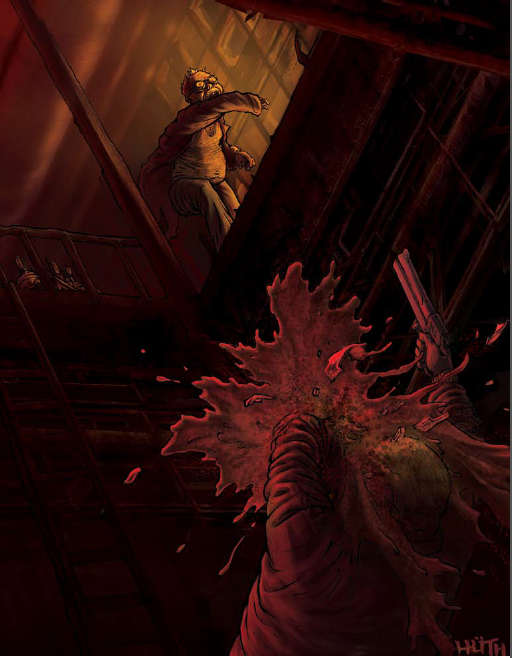
Acid
A staple of both monster blood/saliva and industrial complex fight scenes. When exposed to acid, it does continuous damage each round, until the effect wears off or an ally with the proper materials spends a point of Chemistry or Diagnosis. Damage is rolled once and that number is used for each round:
-
Minor Exposure: Extremity of a small splash. 1d6-2 damage, 2 rounds. If it does no damage, it just smolders away at your clothing or possessions.
-
Partial Exposure: A bucket of acid thrown at you. 1d6-1 damage, 4 rounds.
-
Extensive Exposure: Submerged or consumed. 1d6+1 damage, 6 rounds. If swallowed, it does damage every three rounds instead of every round, lasting a total of 18 rounds.
Crashes
If a car is poised to hit an agent, they need to roll Sense Danger or Athletics to get out of the way in time (default difficulty 5), or take damage equal to the roll difficulty. Damage is further modified by car speed (up to +4 for highway speeds) and car size (-3 for a motorcycle, +4 for an APC). The people in a car that crashes all take damage calculated the same way, but the speed modifier is halved, and they subtract the size modifier for their own vehicle. -2 damage if you're wearing a seatbelt.
Drowning and Suffocation
Agents have improbable breath-holding abilities - 5 rounds for free, after which you start losing 1 Athletics every round. When you run out of Athletics, you start losing 1 Health every round, until you die. Someone else can spend 1 point of Medic if you are rescued and resucitated to restore half your lost Health immediately. You can't resucitate yourself.
Electricity
Similar to acid, shocks are split into three classes:
-
Mild Shock: Touching an ungrounded wire. Lose 1 Health and get blown back.
-
Moderate Shock: Stun gun. You lose 2 Health and can't act for the next four rounds. You can buy off up to three of those lost turns by paying 3 Athletics each.
-
Extreme Shock: Lightning strike. 1d6+4 damage. It doesn't
say
that the effects from Moderate Shock apply here, but I'd guess they do.
Falling
As per crashes, when you fall, you roll Athletics to avoid damage - if you fail, damage taken equals the difficulty of the test. Various circumstances can modify the damage, such as falling through branches (-2 damage) or falling extra far (+1 per 3m of height). If you reach Hurt status from falling damage, you automatically break a limb. If you have Athletics or Hand-to-Hand at 8+ and aren't playing a Dust game, you can hit the ground with a flowing tuck and roll to reduce the damage by a quarter of your rating.
Fire
Also like acid! Fire does damage each round as long as you remain exposed to it.
-
Minor Exposure: Extremity burn. 1d6-2 damage.
-
Partial Exposure: Face, or a lot of surface area. 1d6 damage.
-
Extensive Exposure: Over half of your body is on fire. 1d6+2 damage.
Temperature Extremes
If you're in intense heat or intense cold, you treat it as if you're Hurt - all difficulty numbers raised by 1, must make a Consciousness Roll to spend on Investigative abilities.
Toxins
Varying widely in lethality, Toxins range from household cleaners (-2 damage) to sophisticated nerve gas (up to +16 damage). Once exposed, you have a chance to make a Health test - success nets you the Minor Effect, failure nets you the Severe Effect.
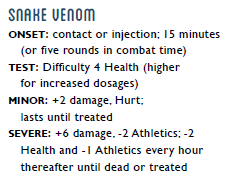
The book lists a bunch of different toxins, up to and including Anthrax and Heroin.
That about wraps up physical hazards, but what about mental hazards? Time for a new section!
Shock and Awe
Stability functions a lot like Health. When something challenges your grip on reality, you make a Stability test, Difficulty 4. You can spend Stability, even going as low as -11, to make the test - if you fail, you might lose a whole lot of Stability, so it can be worth spending a little to offset it. Alternately, you might suffer severe mental conditions based on your failure.
Certain events - witnessing a fresh corpse, killing another human in a fight - don't require Stability tests if you have experience with the violent life, such as a military background. Unless you're in a Burn game. More universally damaging events vary from 3 Stability damage (Witnessing an unnatural occurrence) to 8 (Forced to kill a loved one).
If your Stability is in the range of 0 to -5, you are Shaken - you can't use Investigative Abilities, and General Ability difficulties are all 1 higher. From -6 to -11, you are Shattered - you acquire a mental illness or disorder, and permanently lose 1 point from your Stability rating. At -12, you're incurably insane - you can take one last action, as long as it's self-destructively heroic or explosive. After that, it's time to stat a new agent.
This means it's time for that thing that always weirds me out a bit: Mechanically-enforced real-world mental illnesses!

The first time your Stability drops below -5, you gain either PTSD or an Addictive Disorder. The second time, you acquire Obsession or Paranoia. Furthermore, if you previously had PTSD, and if the second triggering event is broadly similar to the second, you have to roll Stability (Difficulty 4) or your PTSD returns. Addictions can resurface under similar conditions.
Time for another list. As expected, these all do extra things in Burn games.
Post-Traumatic Stress Disorder (PTSD)
Whenever you witness anything that triggers memories of your trauma, you must roll Stability (Difficulty 4) or freeze up, being unable to act meaningfully for 15 minutes, and remain Shaken for another 24 hours. In Burn games, you also must spend 2 Stability to take your first action in combat.
Addictive Disorder
You're now addicted to something! Whenever your supply of whatever you're addicted to dries up, you must make a Stability roll (Difficulty 4) to continue with the operation, rather than chase your fix. Same roll applies to immediate opportunities made to tempt your addiction. In Burn games, indulging in your addiction between operations Refreshes 2 Stability, but you also must spend 1 Stability to do any Investigative spend.
Obsession
You now have an obsessive-compulsive disorder, a phobia, or some other sort of obsession. Functions similarly to Addictive Disorder, in terms of Difficulty 4 Stability Tests. Furthermore, you must take 6 points out of your other General Abilities and put them into a new Obsession pools, which functions in different ways based on the nature of your disorder:
-
Obsessive-Compulsive Disorder: Spend Obsession points on Conceal, Preparedness, or Notice. You must roll Stability to resist cleaning or ordering your surroundings.
-
Phobia: Spend Obsession points only to run away or hide from the thing you fear. If your phobia is a class of people, you must spend 1 Stability to use any Interpersonal ability with them.
-
Mania: Spend Obsession only to study or acquire the object of your mania.
-
Berserk Mania: Spend Obsession to Jump In or Reckless Attack. Not compatible with PTSD, Surveilance and Infiltration Difficulties are all 1 higher.
Paranoia
Stability tests to resist taking over-the-top measures to protect yourself from Them. The Director can call for a test at any moment - as can your fellow players. In Burn games, add 1 to the cost of all Interpersonal and Academic spends, and you can't spend experience to increase your Network or existing Contacts. In Burn/Mirror games, you lose all Trust with all but one of your allies.
The other conditions listed are alternate conditions to replace some of the above, optionally. They're also generally things historically tied to vampire fiction and gothic horror.
Amnesia
Suited best for Mirror games. Realizing you have event-localized amnesia risks a 3-point Stability loss, or worse if it's something central to your life. The details are largely left to the player, but you can't recall anything from the missing time - this includes spending unspent build points to reveal known languages you would have learned at that time, or adding familiar cities with the Urban Survival ability. You gain Mystery as a new Drive. In Burn games, you must make a Stability test to act first in any contest with someone you don't recognize.
Borderline Personality Disorder
When you percieve any sort of personal attack, physical or emotional, Stability test 4 to restrain yourself from lashing out at the attacker. In Burn games, your interpersonal skillset is limited to Bullshit Detector, Interrogation, Streetwise, and Tradecraft - all other abilities are locked, and can't be used or increased with experience points. It's easier for your contacts to be flipped by the enemy.
Depressive Disorder
Available in Dust games. Whenever a life-threatening situation occurs, Stability test 4 to avoid throwing yourself into it without regard for self-preservation. In Burn games, your Hit Threshold is 1 lower. In Burn/Mirror , the amount of Trust other players can assign to you is limited.
Multiple Personality/DID
Dubiously real in our world, but right at home in the world of supernatural spy thrillers, notably Mirror games. You create one or more Alters - different characters, with different sheets, who are also you. Whenever under stress, Stability test 5 to stop one of the Alters from taking control for 1-6 hours, effectively swapping out your character sheet. If this is also a Burn game, one of your Alters must be an 'innocent', who doesn't kill and has never killed - switching away from that Alter drains 2 Stability. Really hardcore Mirror Directors should have the player questioning which one of the Alters might actually be the real you.
Schizophrenia
Hallucinations! Delusions! Strange social affects! I dunno, using real-world mental illnesses as game mechanics has always seemed kind of weird to me, I think I've known people with some of these. Anyway, +2 cost to all Interpersonal spends, +2 Difficulty to all long-term General tasks other than combat or chases. In Burn games, when you invoke Network to create a contact, there's a 1-in-3 chance that they don't exist - the Director may not tell you this at first.
Next: Heat!
RULES, PART 4
Original SA post
RULES, PART 4
When you're having as many car chases and attempted assassinations as an NBA party is likely to get tangled with, people start to notice. Attention is bad, and it's called Heat!
All Agents start with 1 Heat, indicating that the authorities are at least nebulously aware of their existence. As they do dramatic, high-profile things, their Heat increases, from +1 (Car chase) to +5 (Assassinating a head of state). As they take precautions to keep a low profile and leave no evidence behind, Heat increases are minimized. If the enemy conspiracy has fingers in local law enforcement, Heat increases are amplified. Any incident that gets the attention of national Media gives +1 Heat. There's no upper limit to Heat, but only one event per session will result in Heat.
Once peroperation, one player rolls against current Heat, using General Abilities as they can justify it. This roll can be at the beginning of the operation (if the Director is nice) or at critical moments of failure in the middle of it (if the Director is an asshole). If the roll fails, then the authorities will, at some point during the operation, try to interfere with the agents. SWAT raids, attempted arrests, unexpected fleets of cop cars; the actual shape of the interference is up to the Director.
Ambitious Directors can track Heat per-location; a crew may have Heat 5 in Dublin, but Heat 2 in Moscow. In Burn or Dust games, Heat rolls happen once per session, not once per operation. In Mirror games, the authorities you have Heat with may be passing their information on to a vampire conspiracy behind the scenes.
In areas where the crew has had bad run-ins with the authorities, Heat can make their lives harder in more direct ways. When working in such a place, any relevant General test (sneak past cops, break into government computers, arrange illegal activities) has its Difficulty set to the higher of the base Difficulty and your current Heat. If your roll is above the normal difficulty but below the inflated difficulty, you might still succeed, but with the cops hot on your tail. High Heat can also complicate black market sales, resulting in attempted double-crosses from your dealers.
Losing Heat
There are four ways to dial back the heat - waiting, changing jurisdictions, protection, and shifting blame.
The cops will only stay on your tail for so long, before burnout and retasking takes over. If you manage to avoid police contact for 72 hours, Heat drops by 1. Another week, -1. Another three months, -1 again.
If things get really bad, you could always just leave the country! -1 from moving between closely-associated countries or agencies (UK to Ireland), -2 for fellow EU or NATO nations, -3 for other countries, -4 for going halfway around the planet.
If running away isn't a practical solution to your problem, maybe you can try to make a deal! Use Network points to build a new Contact with the right kind of influence, then use them to make a Contact roll against current Heat. On a success, Heat drops by the margin of success. If you don't have a Contact for this, you can make a deal with an unsavory NPC instead. This often involves doing bad things that the government needs done, and if you cross these NPCs, they can raise your Heat instead. In Burn or Dust games, Contact points spent to reduce Heat are spent at 2 per 1 point of roll modifier.
If all of those things fail, you could always shift the blame to someone else! Criminology to find a suitable fall guy, Digital Intrusion to edit surveillance footage, Infiltration to plant false evidence. A frame job could be a full adventure, and the outcome is largely up to the Director - the Heat lost could vary based on the thoroughness of the frame and the integrity of the investigators.
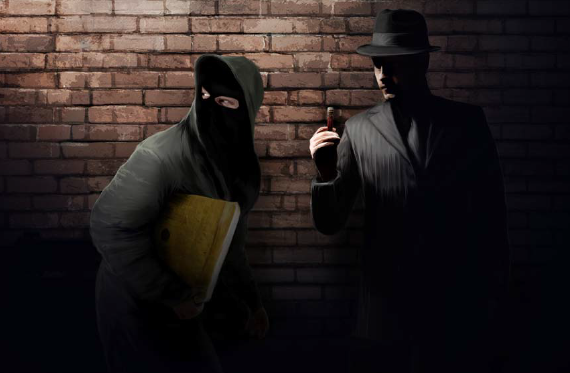
Extended Chases
The basic chase rules are for a car chase or parkour hunt through city streets. An extended chase is one that takes place over days and crosses national borders, instead of being a matter of minutes and meters. One of these can be an entire operation.
Extended Chases combine Lead from the chase rules and Heat from the above section, into a single value Hot Lead - it starts at 7, minus their initial heat. Hot Lead increases by 1 whenever the team crosses a border undetected, or 2 if they do so in an unexpected way that throws their pursuers off their scent. If the team thrwarts their enemy in a scene - escaping in a chase, taking out a group of enemies in a combat scene, et cetera - Hot Lead increases by 1. If they're forced to change their plan by enemy action or lost assets, or if they leave too much evidence behind, Hot Lead drops by 1.
Whenever the team enters a new region, they make a Hot Lead test against a Difficulty varying by enemy influence in the new area. If they succeed, they're still one step ahead; if they fail, they're walking into an ambush, and escape routes are already being cut off. Like an ability, Hot Lead is a point pool - the party can spend their Hot Lead to improve this roll, in the process letting the enemy draw ever closer. 1 point of Hot Lead can also be spent to stop to rest and recover - you can establish a haven in the area, do some research, healing a hurt character, what have you. In Dust games, healing more than 3 Health at once costs 2 Hot Lead.
If Hot Lead reaches zero, you've been caught. The enemy knows exactly where you are, and can bring their full power to bear against you. If they manage to escape the massive gunfight that no doubt ensues, either they get +2 Hot Lead and keep running, or they get +2 Heat and the chase is over. On the other hand, if Hot Lead reaches 10, the enemy has completely lost track of their movements, and they can act freely once more.
Recovery and Improvement
Thanks to how abilities work, agents are gradually, relentlessly getting worn down over the course of an operation. Once it's over, you need to take some time to get back into fighting shape. This means different things for different circumstances.
Investigative ability pools are fully refreshed at the end of every operation, no questions asked. If an operation runs really long, major climactic moments during it may act as soft operation ends, letting you refresh as if the operation was over. General abilities are a bit more forgiving - Athletics, Driving, Hand-to-Hand, Piloting, Shooting and Weapons refresh whenever you go 24 hours without spending them. Some other abilities have special ways to refresh, like the Parkour cherry for Athletics, and they also all refresh at the end of an operation. Cover and Network never refresh.
Whenever the party manages to reach a safe haven, where they can be totally safe from peril for an hour or more, each agent and pick three general abilities (not Health or Stability) to fully refresh. If the haven is compromised, the refreshed points are lost, and this can only happen once per session.
Health and Stability refresh a bit differently. As long as you aren't seriously wounded, Health recovers at a rate of 2 points per restful day, and more can be recovered using Medic. Stability can be refreshed by 1d6 points whenever you do a particularly impressive and successful Spend, thanks to regained confidence. Further Stability can be healed with the Shrink ability, and in some games it may refresh after each Operation - but certainly not in Burn games. If not, you have your Sources of Stability to cover that.
At the end of each operation, you get 2 Experience Points per session the operation took. You can spend them as raw build points, increasing your Investigative or General abilities as normal - this is the only way to get back Cover and Network points. In Mirror games, you can also spend these points to gain Trust.
That finally wraps up the Rules chapter. Next: Items!
TOOLS, PART 1
Original SA post
TOOLS, PART 1
This chapter is about not only the physical items a team needs to complete an operation, but also the immaterial tools - tactics, special techniques, player strategies.
Acquisition
The answer to "where are we getting all this sweet gear" should be short, interesting, or both. Since NBA doesn't track money, the game has a few suggestions about how to sort that out:
Handwaving
You're seasoned agents. You have all the sweet gear you need. If it seems implausible, make it a Preparedness test.
Caches
On a Preparedness test of Difficulty 4 (or 6 if it's an unfamiliar city), you can find a dead drop where your agency used to put unregistered guns or other gear. It's possible that it's guarded, but once you get in, each player can spend 1 Preparedness to name one piece of equipment you find stashed there. A cache can have 1 vehicle, but if you roll a 1 when finding it, be ready for the chance that some of it will break or jam at an inopportune moment.
Crafting
If you don't have it, make it yourself! By default, this is a Mechanics test, but some items may require spends from other pools, such as Shooting to mod guns or Chemistry to macguyver some nasty chemicals. Making things takes time, but it's a lot cheaper than buying them yourself.
Sourcing
Use Network to build a Contact who has the things you need. Your Contact needs to make a test to come through for you - and in a Mirror game, you need to worry about your Contact having been turned.
Stealing
Find someone who has the thing you want, and take it from them. This effectively becomes an op-within-an-op, cracking security to lift the things you want, and risking a Heat increase if things go south.
Buying Things
Legal gear can just be purchased - high-power UV lamps, car batteries, the checmicals that go into napalm. For sketchier gear, a roll in Chemistry, Electronic Surveilance, Pharmacy, etc. may help you find what you need, and Disguise can be used to purchase it without attracting attention to yourself. For straight-up illegal items, spend Streetwise for a gray or black market trade, which might involve an ambush, a cheat, or a double-cross. The higher your Heat, the less likely a black market trade is to go down smoothly.
A party can have three levels of funding, based on the campaign:
-
Insufficient Funds: The norm in
Dust
games. Anything beyond cheap, standard gear, you have to find in Caches, steal, build yourself, or source from Contacts. You can't afford more than one or two standard-issue weapons, even via the blackmarket. If you want silver bullets, you can only afford enough silver for 1d6 of them before you have to knock over a jewelry store. Fake passports, same-day plane tickets, cool cars, and other luxuries are beyond your reach.
-
Steady Funds: The default in other games. Your spending is a bit more free, you can afford guns for everyone and a full magazine of silver bullets each. Money isn't a constant specter looming over your operations. In
Burn
games, the agents may have to sometimes do deniable outside jobs with shady motivations to keep their funds steady. In
Mirror
games, your cash flow may come from an external sponsor who only one of you knows the identity of.
-
Excessive Funds: James Bond. You can get all the custom electronics and top-of-the-line gear you want. Rocket launchers and radioactive material for everyone. Four star hotels, chartered planes, luxury cars. Still, if you spend too dramatically, you're bound to attract some Heat.
Spytech
Actual gear time! In contests where you can bring gear to bear, a gulf in gear quality - military-grade against civilian-grade - the difficulty numbers for the better-equipped side are all 1 lower. If you instead have a one-shot awesome item or a single piece of cutting-edge gear, it gives you a pool of 4 or more points that anyone can tap into when using the item.
The items actually listed in each section are things that the party needs to worry about how to acquire - anything less fancy can be handwaved or easily bought.
Communications
Most communcation gear is easy enough to use that no rolls are required. Communication jamming gear is much harder to obtain than the communication gear itself.
Comms Laser
Uses a modulated tight-beam laser to send messages. Very difficult to jam or intercept, but requires line of sight to send messages.
Satellite Phone
Cellphone, but it uses overhead satellites independent of local cell networks.
Tactical Earbud
INCOMING CALL - PRESS SELECT
Voice Stress Analyzer
Reads subtle modulation in voices - lets you use Bullshit Detector against recordings.
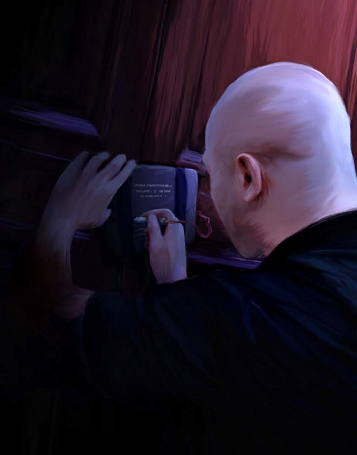
Explosives
Press button, cause boom. This stuff is tough to acquire openly, requiring Streetwise, Network, or a Cache if you want more than a little. Once you have a source, any agent with Explosive Devices can always be assumed to have at least a bit of explosives on hand.
Det Cord
Cable of high explosive under a fiber/plastic sheath. Can be used to connect multiple larger charges, cut through girders, or create powerful booby traps.
Flash-Bang Grenade
Nonlethal light/sound weapon. When it goes off, anyone who isn't protected makes a Health test at Difficulty 8 or be blinded and deafened for 1 round per point they missed the roll by. May be ineffective against some kinds of vampires.
Foam Explosive
Looks like shaving cream, goes off like a weak plastic explosive.
Simulators
Devices that simulate bomb explosions or gunshot sounds, without all the actual mayhem and destruction. Useful for trolling your enemies.
Infiltration
You probably can't get plastic counterfeit fingertips that can fool a fingerprint scanner, but still, even biometrics systems are never perfect. Generally speaking, these are tools that help with Infiltration tests, although some of it (grappling hooks) is helpful for Athletics checks as well.
Climbing Hoist
Ascend a rope at a speed of one story per round. Mechanics test to set up, Shooting test to anchor at the top if it's the kickass version that has a built in grapple gun.
Document Scanning Bar
Half-inch wide cylinder that scans a document while passing over it. Looks cool, but couldn't you just take a photo?
Human Fly Cups
Vacuum cups to let you scale sheer glass without a rope. Difficulty 6 Athletics, ata minimum.
Lockpick Gun
Also called a Snap Gun , this is a cool and real thing that you poke into a lock and it picks it for you. Ineffective against high-grade locks, unnecessary for Agents with 8+ in Infiltration.
Rebreather
Device you put on your face and it lets you breathe underwater for up to 4 hours with no telltale bubbles. Increases Athletics difficulty for swimming tests by 2.
Signaling-Targeting Laser
Signal a target for an air strike or drone attack. 15km range, Shooting test to pinpoint a remote target.
Surveilance
Generally requires the Mechanics or Electronic Surveilance skills to use, although planting one only requires Conceal. Some items in the list require no test at all. A lot of this stuff needs to be built or sourced, and isn't available otherwise.
Acousting Gunshot Sensor
A box that fits on your shoulder and listens for gunshots, and locates the shooter, passing the info to you one round later. Adds +3 to Sense Trouble rolls to locate an enemy sniper. Larger models are easier to kitbash.
Fiberoptic Scope
A tiny cable connected to a tiny camera. Snake it under a door or into a safe/briefcase, or otherwise be clever.
Fume Sponge
Absorbs chemicals, odors, and contaminants in the room. May require Chemistry, Criminology or Forensic Pathology to analyze.
Laser Microphone
Reads vibrations of window glass, converts back into the sounds from inside that caused them. Can't be detected by bug detectors, but heavy curtains will block it.
Night Vision Optics
Lowers difficulty for Surveillance and Sense Trouble at night. Available for scopes on rifles and pistols.
Penetrating Radar
Imaging radar used to detect undergroudn spaces, landminds, hidden artifacts, vampires in coffins, etc. Can't see through metal.
Tempest Monitor
Intercepts radio waves broadcast by computer monitors. Can read and parse any screen within 300 meters.
Wolf's Ears
Headphones that amplify distant noises and deafens nearby sounds. Used by hunters, legal to buy. May lower difficulty on Sense Trouble and Surveillance tests. Sonic attacks such as flash-bangs or banshee wails have difficulty set 1 or 2 points lower.
Vehicles

Acquiring civilian ground or water vehicles isn't too tough, relatively speaking - but doing so illegally can boost heat. If you get one from your network, it may be on loan. Stealing an air vehicle is almost always its own operation.
Each Vehicle has a Speed and a Maneuverability rating. Speed ranks which one is generally always faster than which, and maneuverability... isn't actually explained on this page? Maybe it affects difficulty numbers while driving it. Vehicles also get armor ratings, and can be used to provide cover/armor.
If a team has access to both Driving and Mechanics, they can spend a dai souping up a vehicle. This is a Mechanics test with difficulty 4 - success lets the vehicle count as higher speed or higher maneuverability against vehicles of the same speed/maneuverability rating. You can also add all sorts of crazy hacks to it that provide a free Swerve - a Chase maneuver where you double all Lead gains/losses for a round, normally costing 3 points of Driving/Piloting.
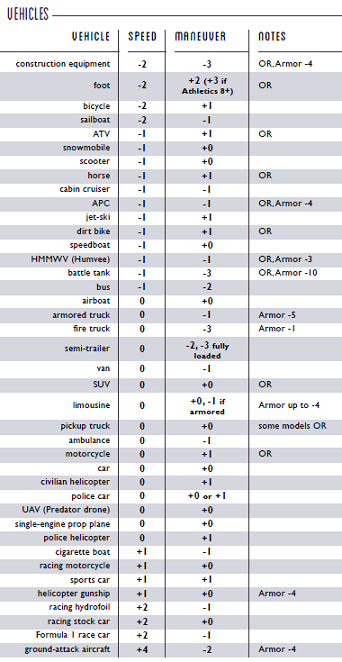
Have a nice big table of vehicles. OR = off-road. NEXT: Guns.
TOOLS, PART 2
Original SA post
TOOLS, PART 2
Last time: Acquisition rules, communications/infiltration gear, vehicles. This time: Devices for killing bad guys.
Special Weapons
The section starts out with a note that if you want to use any gun that uses special ammunition in Europe, meaning anything other than .22LR hunting ammo, you're stuck with Streetwise to get it.
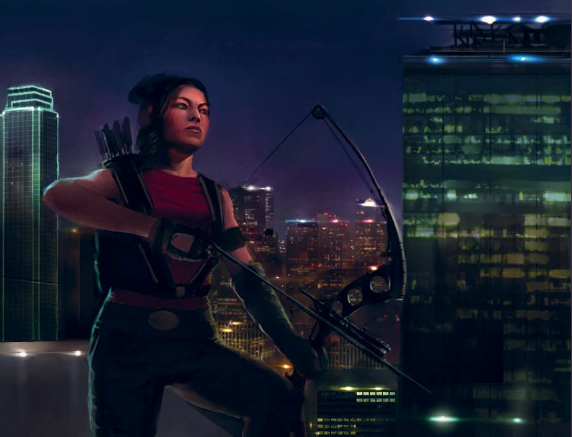
Bows
Effectively a rifle, but Armor reduces damage by an extra -1. Kind of disappointing that this doesn't have any further mechanics for this - I guess the advantage is not drawing attention with gunshot noises.
Dazzle Laser
Shoot a blinding laser into people's eyes from Long range. On a hit, Health or Athletics test (Difficulty 8) or blinded for the rest of the scene. NVO goggles drops the difficulty to 4.
Laser Sight
Ominous red dot on the forehead! Targets up to 250 meters away during the day and 750 at night. Within that range, Extended Range attacks only cost 1, and the enemy Hit Threshold drops by 1. If you're in fog or smoke, the laser is visible, outing your position and dropping your own Hit Threshold by 1. The most fun part about these: If your target can see the red dot, you lose surprise, but any partners you have talking to them in person get a free point or two to spend on Intimidation.
Scope
Decreases cost of Extended Range by 1. While sniping, decreases cost of Extended Range to 0.
Silencer
Illegal in most countries, lets you shoot without ruining your Infiltration test. In a Dust game, this will still make enough noise to be heard easily from the next room over, because silencers aren't magic.
Slingshot
Throw a ball bearing (-1 damage) at a target up to Near range. Completely silent.
Special Ammo
The book lists a bunch of these.
-
Armor Piercing: Reduce armor ratings by half, round down.
-
Depleted Uranium: +1 damage to armor -2 or worse, Incendiary against armor -3 or better.
-
Dragon's Breath: Incendiary shotgun ammo, fires a gout of flame for 2 rounds. On a Shooting roll of 1, the gun jams unless you spend Shooting 2, hard as hell to load safely.
-
Hollow-Point: +1 damage to unarmored targets, armor ratings are boosted by 1 against it. Can carry poison, mercury, silver, garlic oil, holy water...
-
Incendiary: Blows up flammables on a hit. Firing leaves a bright streak that drops Hit Threshold for you and your target both by 1 for the next 2 rounds.
-
Rubber: Armor ratings doubled, can't drop a target below Hurt.
-
Shotgun Slug: Change shotgun range to Long and do +1 damage, but lose the advantage shotguns have at Close range.
Very Special Weapons
The above gear can have its uses in various spy scenarios, but you're not just fighting terrorists and spies. You're fighting vampires.
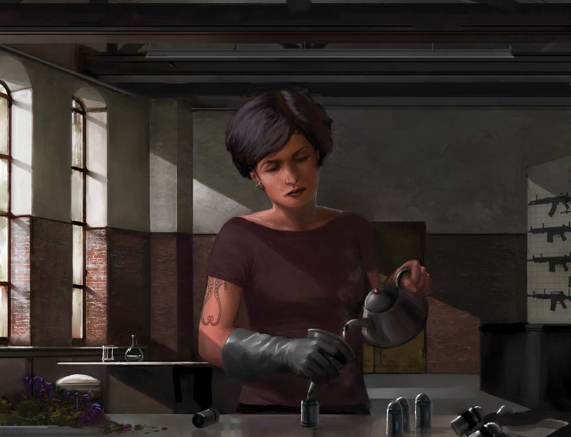
Flamethrower
Very hard to find, you're probably better off just building one (Difficulty 5 Mechanics test). +0 damage on a hit, -2 damage on a miss by 1. A second consecutive hit does +2 damage from extended exposure. Using at point-blank range is a great way to blow yourself up.
Flare Gun
+0 damage on impact, burns for -2 damage for 1d6 rounds. Very short range compared to other firearms, but it also functions as a flare gun. When a flare is burning, darkness penalties are removed for 2 rounds, then lowered to Night for the next 3.
Hairspray and Lighter
The classic. +0 damage, fizzles or explodes on a roll of 1.
Thermite
Cuts through steel, burns underwater, handle with extreme caution.
UV Light
Does sunlight hurt vampires? Then this might hurt vampires. Can be kitbashed, range and damage vary from how the light is delivered - Close and -1 damage for a flashlight, Long and +2 damage for a floodlight.
Meteoric Iron
Another possible obscure vampire weakness. Makes for brittle weapons, breaking on a roll of 1. Getting your hands on it almost certainly requires an awesome museum heist, which may tip off the vampires.
Silver
Creating silver weapons/ammo or coating weapons in silver requires a lot of time and access to the Mechanics ability. How much damage it does is up to the campaign.
Gartot Wire
Requires a surprise attack from behind, which requires an Infiltration test. Make a Called Shot to the throat, dealing +3 damage on a hit. Once you hit once, consecutive hits can auto-succeed if nothing interrupts you. With a really good wire, can be used for beheadings, the only way to kill some kinds of vampires.
Holy Water
Can be acquired from any Catholic or Orthodox church, or for free if one of your agents is a priest. For this reason, be careful about letting someone play a priest if your vampires are vulnerable to holy water.
Paintball Gun
Can be filled with holy water, garlic oil, or luminous paint - the latter reduces the target's Hit Threshold by 1.
Tranquilizer Gun
Shorter range than bullet-shooty guns by one range category. Apply liquid anesthetic or something else via gunshot. May not work on vampires.
Garlic
The core compound that creates Garlic's smell is Allicin. Isolating a supply takes a 2-point Chemistry spend and a hell of a lot of garlic. Effects to be covered in the Vampires chapter.
Stakes
Stabbing someone with a wood stake does -1 damage; pounding it in with a hammer does +1 damage. A grenade launcher or smoothbore antique gun can fire a wooden stake, but takes a round to reload. Effects to be covered later.
Tactical Fact-Finding Benefits
TFFBs are ways to use Investigative skills around or during combat for special perks. Use Cryptography to decrypt encoded enemy communications. Urban Survival to spot dead ends or escape routes. Architecture to discover unguarded entry points. Each has four steps:
-
Use an Investigative ability.
-
Perform an action.
-
Be in the right circumstances.
-
Get benefit.
Benefits can include pool refreshes, special pools of points the whole team can dip into, difficulty reductions, draining enemy point pools, or surprise. Some possible examples:
-
Use
Data Recovery
to locate the railroad car where a vampire is sleeping. Use
Digital Intrusion
(5) or
Mechanics
(4) to switch junctions and tracks to send the car off on a remote siding. Gain a pool of 12 points to use during the assault on the mobile vampire lair.
-
Assess a vampire cult center site using
Archaeology
to discover the signs of a Roman catacomb underneath.
Explosive Devices
to infiltrate from below and blow up the floor under their feat. The targets' Health pools are each reduced by 4 points.
-
Use
Streetwise
to mingle your way into a Corsican drug ring to identify the group's leader. When killing him, each agent gets a 4-point combat ability refresh as the enemy force is demoralized.
-
Use
Electronic Surveillance
to covertly scout out possible locations for the monster preying on the docks, along with possible weaknesses. Now prepared, the team goes after the monster and gets a team pool of 8 points for any General abilities, and also know its Athletics and Hand-to-Hand ratings.
Tag-Team Tactical Benefits
Similar, but specifically for two people working together with different skills. One agent, the winger , makes an Investigative Spend. Another, the striker , gains a temporary pool of extra points to spend for a given General ability - 3 points per point the winger spent. Usually the winger's spend represents work done in advance of the striker's action. For example:
-
The winger spends
Architecture
points to aid the striker's
Explosive Devices
check to take down a building.
-
The winger spends
Electronic Surveillance
points to map a building's security systems, helping the striker use
Infiltration
to break in.
-
The winger spends
Urban Survival
to plot out a route for a stalking striker to use
Surveillance
to drive a target into a choke point or dead end.
Tradecraft
A really broad investigative ability, that comes down to "knowing how to do cool spy shit". Here, we get some specific ways to use it - like all investigative abilities, these are free if they provide core clues, or spendy if you want extras.
Covert Communication
Sending a message in a way that's hard or impossible to pick up. Carry a copy of the Financial Times to work if you're interested, and someone will anonymously text you the meeting location.
Brush Passes
Two people brush past each other, and one discreetly passes some object to the other. Noticing the enemy doing this is also Tradecraft.
Dead Drops
Party A stashes something at hidden location X, then tells location X to party B, who retrieves it. Thusly do A and B exchange an item without ever meeting face to face. In the modern world, there are also digital dead drops - drop some info on a fan forum for Peruvian pop starlets. Setting up and concealing a digital dead drop is a Digital Intrusion test, retrieving it is free once you know where it is. Finding an enemy dead drop requires a lot of tools and information.
Steganography
Embedding hidden info into written text - Trithemius concealed his work on codes in a book about performing magic. Modern spycraft gives us digital stenography, where sensitive data can be encoded into apparently-innocent data. Cracking it requires Cryptography, Data Recovery, or both.
Cuckoo's Eggs
A wide variety of skills are needed to infiltrate an enemy network. This is usually spread across a full operation, and the benefits may not reveal themselves until much later.
Asset Handling
Instead of inserting yourself into the enemy organization, find someone alread there who you can convert to your side. Three steps:
-
Identify: Find a good candidate. Human Society, Streetwise, High Society.
-
Contact: Get in touch when the asset is extra vulnerable or extra comfortable.
-
Flip: Get them onto your side. The best ways to get them to convert are MICE: Money, Ideology, Coercion, or Ego. Coercion is the most common, but a
Stakes
game makes Ego or Ideology more viable. Money flips are usually only possible if you have excessive funding.
Asset Running
You've flipped an enemy, time to act. You can spend 1 of a relevant Interpersonal ability to get some info from them, or 2 to get them to do something for you. You can use Tradecraft to do this all covertly. They're like really unreliable Contacts, who don't cost Network points to build.
Adversary Mapping
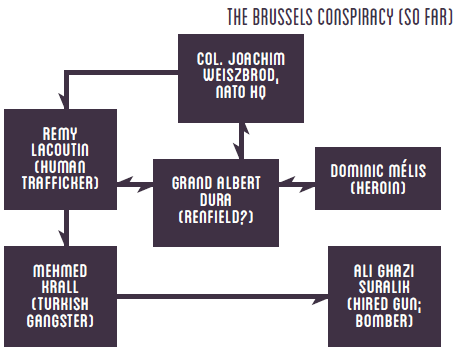
The main goal of most intelligence operations: Uncover the nature of the enemy conspiracy. The general structure can be uncovered with Human Terrain and Traffic Analysis. Further spends can confirm the place of targets on the map, and who they're connected to. The Director and the players collaborate to create a visual map like the above.
Once the players have mapped out part of the adversary map, they get a team pool of 2 points for each target in that section (or thereabouts). This is also a good framework for planning TFFBs.
Pressure
Make the enemy sweat. Either a direct attack on the network, or an attack ont heir allies or resources, forcing them to act. Or, do the same by providing a target to tempting for them to pass up.
Capture and Interrogation
Abduct an enemy and pump them for information. You need a target (Human Terrain, Streetwise, Surveillance, Traffic Analysis), an extraction plan (a whole operation), and a secure location (Network, Urban Survival). You can use Interrogation to automatically extract a core clue, or get more data/get data faster with further tests or spends.
Truth Serum
In the real world, "truth serums" are about as effective as getting the target really, really drunk. But hey, this isn't reality, this is a spy thriller! If you have access to this stuff, it's Stability (Difficulty 6) to resist - whether or not the target cracks and talks, they're Shaken for 1d6 hours. Even the slightest tinge of vampiric power blocks truth serums.
Advice to Players
Reality has the Moscow Rules , a set of rules of thumb for agents working in Moscow during the Cold War. In this vein, NBA gives the Bucharest Rules - rules for how to keep the game moving and maximally fun for everyone, and how to succeed in the face of great adversity.
-
You can win.
If you do something, you might win or might lose. If you do nothing, you'll definitely lose. So, take the initiative and do something. A good Director won't shut down a sufficiently awesome plan completely.
-
Put it in Drive.
When you're not sure how to justify something risky, look at your Drive. It may spur your agent into action.
-
With great ability scores comes great responsibility.
Look at your best ability scores and your MOS. What are you good at? How can you use it to your advantage? Do what you do best, and do it at the right time.
-
When stuck, get more intel.
If you really have no idea what to do, don't putter in circles. Go out, get more information. If you don't have enough info to make a plan, fix that.
-
Follow the money.
Nobody works for vampires for free. They don't cast shadows, but their cash does.
-
Humint is key.
Don't shy away from using interpersonal abilities. If you're in a pinch, create a new contact with Networking to get you out. People are your strongest assets.
-
Build your own network.
Who could help you out here? Build, buy, or break that person. Strength in numbers.
-
Keep moving forward.
Expect to find one major clue per scene. Once you do, don't dwell too long scraping more info out of the scene or the witness. The clues will lead you to new places. Go to those places, find more clues.
-
Leave room to maneuver.
Don't plan out every aspect of your op in advance. The Preparedness ability is there to let you retcon the off-screen parts of the plan, take advantage of it. It'll make you look better, and irritate your Director less.
-
Remember, you're the badass here.
Keep your characters proactive, don't shrink away from danger. Value interesting decisions over realistic reactions.
-
Always know where the exit is.
You don't get extra EXP for finishing the dungeon. When things heat up, be ready to cut your losses, grab what you can, and get out.
In a sidebar, an alternate set of rules devised by one of the playtesters - the Clapham Rules:
quote:
1. Run. Fast. In the opposite direction from any supernatural creature the Director decides to throw at you. Even if it looks dead, or worse, harmless.
2. Learn how to kill the bastards properly, but always refer to Rule 1.
3. Work together as a team, not as the typical group of roleplayers. Going solo will get you killed, or worse.
3a. If you find your self alone, always refer to Rule 1.
3b. Don’t try to be the hero and finish off a beastie by yourself — irrespective of how much C4/white phosphorus, etc., you have. See Rule 1.
4. Planning, planning, planning, then see Rule 1 regarding an exit strategy.
5. The adversary map is your friend. Refer to it often, but always expect it to lead you into trouble rather than provide you with answers. See Rule 1.
NEXT: Finally, vampires.
VAMPIRES, PART 1
Original SA post
VAMPIRES, PART 1
NBA doesn't have a single 'canon' definition of what vampires are and what they're capable of. Where did they come from? How are they created? How are the destroyed? What can they do? This chapter lays out not the answer, but a whole big pile of possible answers.
As there are four game modes, so are there four general vampire types:
Supernatural
Vampires are caused by magical activity here on Earth - necromancy, witchcraft, what have you. Most vampires from old folklore fall into this category.
Damned
Vampires are caused by activity down in actual, literal hell. They seduce, they're repelled by the power of God. Most literary vampires from the 17th century onwards are this, including Stoker's Dracula.
Alien
Vampires are alien invaders, psychic entities, or human corpses reanimated by extraterrestrial science. H.G. Wells pioneered this category of vampire.
Mutant
Vampires are a parabiological threat caused by black program genetic testing or viral outbreak. They spread like a disease. This idea has its roots in Enlightenment skeptics tying vampire myths to tuberculosis.
It's possible to mix and match these types at will - supernatural phenomena may be the result of alien science. A biological vampire disease could have come forth from the pits of hell. It's worth talking to your players about what kind of vampires they want to fight - if they want to kill Edward Cullen, let them kill Edward Cullan.
Vampires and Game Mode
How your vampires function - and which kind you use - should vary based on the kind of game you want to run.
-
In
Burn
games, emphasize the agony of staking someone you know and trusted. Vampires should still retain some facets of their old humanity. Damned and Supernatural vampires hit this the best.
-
In
Dust
games, you want a bit of 'realism' to the setting - keep their numbers minimal so that the conspiracy is more believable (and also because even a single vampire is a serious threat to a Dust party). Mutant vampires work well, as do the grimier sort of supernatural vampires.
-
In
Burn
and
Dust
games, vampirism should be incurable, to emphasize the loss and/or powerlessness of the human side.
-
In
Mirror
games, the important thing is that vampires
must
be able to pass as human - keep the party guessing on who they can or can't trust. Alien vampires fit well, as do any vampires who choose their own fate.
-
In
Stakes
games, you get the most mileage out of vampires motivated by an ideology - so, damned vampires are your best bet.
How Vampirism Works
The first question to ask is: Where to vampires come from? How are they created? Why are they a menace now, in the 21st century? The answer depends on the vampire type.
-
Supernatural vampires could be reintroduced to the world as a menace by grave robbers. The genocides of the 20th century could have roiled up the spirit world.
-
Damned vampires could return as part of a prophecy, or as a result of the work of over-ambitious agents with ties to the world of black magic and satanic cults (Aleister Crowley, Heinrich Himmler, etc). Or, they could have started with a specific historical figure and spread from there through their influence - Vlad Tepes, Elizabeth Bathory, Gilles de Rais, Judas Iscariot.
-
Alien vampires come, obviously, from space. Maybe they've been here for a long time, and were just reawakened by some kind of recent phenomenon. Maybe they were in Roswell since 1956.
-
Mutant vampires could be the result of an obscure, latent genetic pattern, or a mutation of another disease epidoemic. Alternately, they may have been created by Nazi, Soviet, or CIA secret experiments.
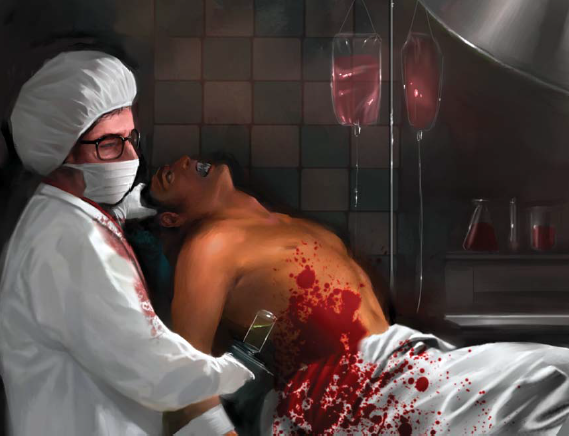
Spread
How do vampires spread? Why haven't they taken over the world?
-
Supernatural vampires exist in folklores across the world - Europe, Japan, Mexica, China, West Africa, the Caribbean. Is each its own vampire conspiracy, or is there a global alliance? If the former, all it takes to throw everything into chaos is the SS bringing one jiangshi into Berlin to cause a turf war.
-
Damned vampires generally must choose to convert a victim, so the spread is relatively slow. The conspiracy's spread will follow the spread of Christianity.
-
Alien vampires may be blocked from conquering humanity by environmental concerns, star alignment, or genetic limitations. They likely use a lot of genetically-modified Renfields to do their field work for them.
-
Mutant vampires carry the biggest, scariest threat of global vampire pandemic. Look at how modern diseases spread - that's the kind of patterns you might see from mutant vampire epidemics.
Numbers
The more powerful vampires are, the less there should be. An absolute upper-limit on vampire count in a region would be 1 vampire per 2,000 humans, if virtually all missing persons and unsolved murders are vampire-inflicted. Looking at it from a perspective of predator patterns, equating vampires to wolves, a more likely number might look like 1 vampire per 60 square kilometers. That number would put a max of 40 vampires in London.
-
Supernatural vampires tend to stick to one town, one vampire (plus servants). If the vampire population in an area gets too active, vampire hunters move in.
-
Damned vampires fit into fancy, specific hierarchy rules. Six or thirteen are common numbers - 13 arch-vampires, each with 13 vampire vassals, each with 13 human servants.
-
Alien vampire numbers vary widely based on how they arrive. One ship/meteor might bring a few to a few hundred vampires. Was there just one such arrival, or have there been multiple over time? Have agents culled their numbers in between, or do they keep getting more and more populous?
-
Mutant vampires might be a one-in-a-billion mutation as the start of a strain, after which population can potentially explode. If they were built by a black ops program, they would have probably built a small, round number - 100, tops.
Variations and Divisions
Are all vampires united by a common bloodline, or are there rival 'species' of vampires, competing for a single resource (human blood)? The more kinds of vampires you have, the more complex the game gets - more than three vampire bloodlines is probably too much for one setting.
-
Supernatural and Damned vampires potentially vary by folklore, legend, or tradition, so there could be a wide variety of different types. Vampire literature usually sticks to one type, usually drawn from multiple different folklore traditions. If there are different types, they vary by region, and may fall to infighting or may be united by their malice against humanity.
-
Alien and mutant vampires are more likely to stick to a single strain, since they all come from the same source within the setting. Alien vampires tend more towards monolithing, but mutants may split into different strains and competing alliances.
Life and Death
The unifying trait of most vampire legends is that they are creatures between life and death that feed on life. Usually life comes from blood, but it can also be breath, emotion, memory, youth, or psychic energy. So, how dead are your vampires? How alive are they?
-
Supernatural and damned vampires cover a wide range here. Some are dry, walking corpses, some are lousy with lust and personality. Their connection to death is usually through some kind of magical spirit world.
-
Alien vampires may exist on some level outside of our life/death spectrum, due to psychic natures or extra-dimensional bodies. Humans can barely comprehend what makes them tick, or why they need to prey on humans.
-
Psychic vampires, whether alien or mutant, probably don't drink literal blood. They feed on psionic power, or emotions, or memories, or neural eletricity. They may actually inhabit human bodies, making them some of the most lifelike vampires there are.
Humanity
Were vampires once human? If so, how much of their humanity did they retain in their life after life? How hard are they to distinguish from living humans? These are important questions, since they dictate the motivations of the vampire conspiracy.
-
Supernatural vampires are often twisted parodies of their past selves. They're usually unpleasant creatures, with one or two distinct features marking them as the undead, such as red eyes or missing reflections.
-
True damned vampires have full memory of their human lives, but are still evil creatures, since they were evil humans. They'll target old enemies for revenge and old loved ones for corruption. Their unlife is fueled by a desire to revel in sin. This is where you usually find the most sexy vampires, possibly with succubus-like powers of seduction.
-
Alien vampires were never human. They may not understand us better than we understand ant colonies, and may accordingly be incapable of passing as human, instead using human agents to do their field work. Psychic vampires may instead act similar to damned vampires, arrogantly wielding human frailty as their weapons and using telepathic suggestion to make themselves irresistible to humans.
-
Mutant vampires have more often than not lost their humanity to madness and thirst. Rather than attraction, the standard reaction to these more monstrous vampires is fight or flight.
Cure
Can vampirism be cured? Once someone has been turned, is there any hope of turning them back?
-
Chinese esoteric medicine talks about obscure ways to draw out vampire poison. Supernatural vampires may have various spells or treatments to cure a vampire bite, especially if the victim hasn't yet died from the wound. If so, saving someone is a desperate race against time.
-
Damned vampires can sometimes be exorcised from the body they inhabit, but doing so seldom saves the victim - instead, thety just get to die with God's grace. Drinking from the Holy Grail might be a perfect vampire cure, or killing a vampire may lift the curse on his victims. Kill Dracula, save Lucy.
-
If alien vampires can convert humans in any capacity, they may be somehow combated by paranormal methods or radiation. If aliens create servants using genetic manipulation, there's probably no saving their victims.
-
Viral vampires create the simplest, most clear-cut solution: Vampires are a disease. Can medicine provide a cure?
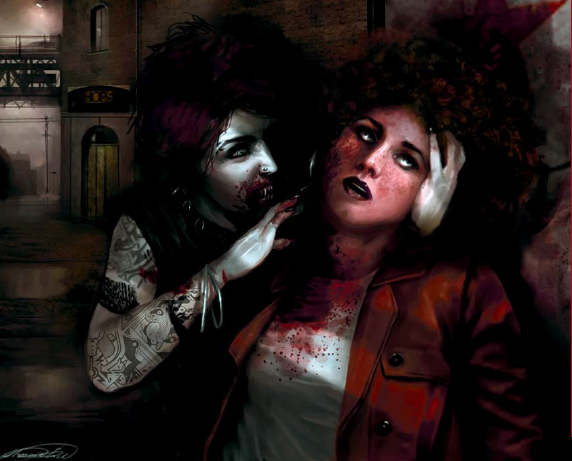
Building a Vampire
Enough fluff decisions! Time for numbers!
All vampires have three basic abilities - Health, Hand-to-Hand, and Abberance . Health functions like an agent's Health, but nothing but a Bane can reduce a vampire below -11. To make things harder, vampires may refresh Health rapidly, be very hard to reduce, or they may replenish it by drinking blood from their foes.
Hand-to-Hand is the go-to combat method for most vampires, but it's much more dangerous than the human equivalent. If a vampire is animalistic or brutalistic, it gets +1 damage. If it has claws or talens, +1 damage. If it has supernatural strength, +2 damage. They're likely to use the full range of Thriller Combat abilities available in the campaign, especially Called Shots, Critical Hits, Extra Attacks, Mook Shield, Reckless Attacks, and Throws.
Aberrance is the pool representing a vampire's supernatural powers. Most things that vampires do that are impossible require Aberrance spends. If a vampire has 8+ Aberance, it gets +1 to its Hit Threshold, same as Athletics.
Vampires may also have supernaturally strong skin, giving them always-on armor. This could vary from -1 to -6, depending on how thick and tough their skin is. Depending on the species, attacks of certain types, such as silver bullets, may bypass that armor or even do extra damage. Vampires are immune to inhaled toxins and suffocation. The book goes on to list a number of possible vampire body types:
-
Corpse: Never suffers from shock or blood loss. No armor, but all weapons do half damage. Firearms do 1 point of damage, shotguns firing shot do 2 points of damage. Called shots are only effective against one single weak point.
-
Fluid: Strange biotech, ideal for alien vampires. All physical wounds simply close after being inflicted. Fire, electricity and acid do full damage.
-
Immaterial: The vampire exists outside of the material plane. Physical attacks do no damage, fire does 1 point of damage. Electricity, magnetism, microwaves, radiation, or sonic attacks may disrupt it.
-
Rubbery: Abnormally resilient, clay-like flesh. -2 damage from melee weapons, firearms do half damage. Called Shots are effective against weak points. Car crashes and falls do 1 point of damage.
-
Stony: Like a walking statue. Any weapon with a damage modifier below +1 does no damage, heavier weapons do -2 damage. Immune to fire and electricity, vulnerable to acid. -5 damage from car crashes and falls.
-
Unfeeling: Cannot feel pain. Automatically passes all Consciousness rolls, can fight while Seriously Wounded. Physical attacks don't inflict Hurt, even if they push it below 0 Health.
Other Abilities
Some vampires may have the Weapons ability at very high ratings, due to centuries of practice and supernatural strength and speed. Very strong or supernaturally strong vampires can add their +1 or +2 damage bonus to weapon attacks, stacking with the weapon's power. Some more modern vampires may also take up Shooting. Vampire spies may take up skills like Conceal, Infiltration, or Surveilance, just like their human equivalents. If they have an unnatural edge in any of these abilities, they can spend Aberrance on such contests, in addition to the relevant ability pools.
Next: Vampire powers.
VAMPIRES, PART 2
Original SA post
VAMPIRES, PART 2
Vampire Powers
Vampires can do weird shit. The scope of strange powers has spread wide across overlapping folklore and horror writers, and you can take as little or as much as you want for your own vampire rules. So, the book just lists all of them, and lets you pick and choose - specific vampire types are listed for some, but that's just suggestions.
Unless otherwise stated, using a vampire power costs 2 Aberrance points. If it's a really impressive display of power, it costs 3. If it's a minor display of power, it costs 1. On to the list!
Awareness
During stealth scenes, enemy guards have an Alertness Modifier, which is added to all tests you make while infiltrating enemy territory. Your vampires have an Alertness Modifier ranging from +0 for a simple revived corpse to +3 for an apex predator. Using this modifier costs no points, but the vampire can spend Aberrance to raise the difficulty of an Infiltration or Surveillance test. Trying to hide or escape from vampires while bleeding raises difficulty by 2.
Animal Senses
Recommended for supernatural or alien vampires. The vampires has senses that humans don't, like vibration sense, detecting electrical fields, or using sonar to hunt in total darkness.
Clairvoyance
Supernatural vampires can see through the eyes of rats, owls, or other beats under their control. Damned vampires can see thruogh the eyes of those whose blood they have drunk. Psionic vampires can use ESP or remote viewing abilities.
Darkvision
At no cost, vampires can see perfectly in darkness, no matter how deep.
Infravision
Recommended for supernatural or mutant vampires. The monster can see into the infrared sepctrum, letting them spot living things in total darkness or through walls.
Drain
When a vampire drinks blood, they can drain Health from the victim's pool and add it to their own. Some vampires may have a hard Health cap, or maybe they can't more than double their current Health on a single drain.
This requires a willing victim or successful Hand-to-Hand bite attack. Once they bite once, the vampire can automatically succeed if they keep draining on the second turn. Alien vampires, or otherwise spectral creatures, may have to spend Aberration to materialize before feeding.
Addictive Bite
Recommended for damned and mutant vampires. The vampire's bite creates a physiological addiction - treat a bite like a dose of heroin. May be automatic or may be an active aberration.
Heat Drain
With a grasp like the chill of the grave, the vampire drains all body heat out of anyone they touch. A prolonged flesh-to-flesh touch does 1d6 damage to the victim's Athletics pool - once they run out of Athletics, it starts draining Health instead. This costs 2 Aberration per victim, not per attack.
Psychic Vampirism
Some vampires, often alien vampires, drain emotion, drive, or some other vital force. Instead of Health, they may drain Stability or Athletics, restoring their own Health with the points regardless of the pool drained. If you lose Stability to a vampire, it can't be regained until you use your Drive or finish the operation.
Remote Drain
Not all drains are literal biting and draining. The Aswang feeds on children sleeping under the roof it perches on. A fashion model vampire might feed on the lust of people looking at her. Mechanically, this could either be a Hand-to-Hand attack at range or a mental attack.
Field Effects
Just being near a powerful vampire can cause things to get weird. The strange, ominous changes in the environment surrounding a vampire can require a 2- or 3-point Stability test. Most of these are free powers, requiring no Aberrance to activate.
Blood Will Tell
If a wound draws blood in the vicinity of a monster, it never stops bleeding. Lose 1 Health every two rounds, Health test at difficulty 4 to stop it. May also manifest as fever, nosebleeds, or profuse sweating.
Memory Haze
Ideal for alien vampires. The vampire's image vanishes from human memory, a minute or an hour after the encounter ends, replaced with a hazy screen memory of owls and bushy-haired strangers. Causes a Stability test upon recalling, costs Aberration to use.
No Reflection
Vampires have no reflection in mirrors and maybe no shadow in sunlight. Such creatures may spend 2 Aberrance to project a reflection or shadow consciously.
Stifling Air
Being in the same room as a vampire causes you to slowly suffocate as the air turns sour.
Temporal Distortion
Good for damned or alien vampires. Time gets a little glitchy around the vampire, creating senses of deja vu or glitches in reality. The vampire's Hit Threshold increases by 1, and laser sights provide no bonus against it.
Infection
One of the signature powers of vampires is creating more vampires. There are a lot of details to sort out here. Maybe victims rise as vampires if a vampire drank their blood. Maybe they need to feed three days in a row to seal the deal. Maybe they need to die from the drinking. Maybe any fluid transmission is enough.
It's important to be careful as a Director if you go with "one bite, certain vampire transmission". If you don't give the party some way to quickly counteract the bite and aren't just very sparing with vampire enounters, you're going to go through a hell of a lot of dead agents.
Dominance
When the vampire bites someone, it turns them into a servant. NPCs are turned automatically, PCs get a Difficulty 8 Stability test to avoid gaining an Obsession with obeying the vampire. Any act to resist the vampire's orders requires a Difficulty 6 Stability test. If Stability drops to -12, you become an NPC servant of the vampire for all eternity.
Plague
The vampire infection spreads as a disease. Model it as something similar to anthrax, infected on a successful Hand-to-Hand attack.
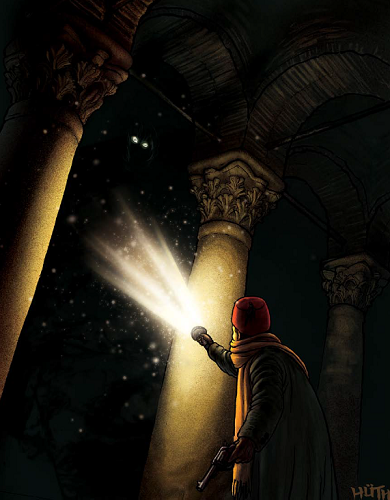
Invisibility
Detecting an invisible vampire is hard. It gains a bonus to difficulty of tests to pinpoint its location, ranging by circumstance from +1 to +5, and also gains a bonus to its Hit Threshold. Some vampires might have selective invisibility - maybe they can only be seen by one agent at a time, or only by children.
Cloak of Dakrness
Recommended for damned vampires. As an Abberation Spend, the vampire can increase darkness levels locally by two tiers - light becomes Dark, night becomes Pitch Black. Artificial lights cannot pierce these shadows, but sunlight can.
Cloud Men's Minds
Recommended for alien vampires. Psychic power lets the vampire convince witnesses that they don't see anything - however, cameras and mechanical detection systems can still spot them. For the most powerful vampires, this is an automatic power that affects anyone who has less Stability than they have Aberrance. If you have reason to suspect such a vampire is in the vicinity, Stability Difficulty 6 to see them.
Indescribably
A true form that cannot be comprehended by human eye. Functions similarly to Memory Haze.
Turn Invisible
The vampire van cause itself to fade from reality, either into some other dimension or into a spirit form, only visible to wild beasts.
Magic
Dracula could command waves, change in size, teleport from place to place, and conjure fog and storms. Maybe your vampires have such powers. Maybe they can do almost anything. Non-traditional vampire magic like this costs 3 Aberrance to use.
Supernatural vampires of folklore have many famous abilities, such as curses and blights, or the Evil Eye. Demonic vampires can fly, scry foes from afar, build unholy structures, and even perform dark rituals to mask their own weaknesses. Alien vampires may not have magic, but they certainly have sufficiently advanced technology at their disposal.
Mental Attacks
Rather than fighting with tooth and claw, some vampires may attack the mind directly, attacking an agent's Stability pool. To make such an attack, the vampire spends 2 or more Aberrance, then rolls 1d6+Spent points. If the total is greater than 4, the victim feels their mind come under attack, feeling their sanity slip away in any of a hundred ways. The stability test they must make has a difficulty equal to the attack roll.
Supernatural vampires may have the ability to enter a victim's dreams and influence their minds. To facilitate this, they may also be able to put people to sleep with hypnotic powers. Damned vampires may haunt a victim with illusions of temptation, instilling lust or gluttony or despair. Psionic vampires could read minds, disguise themselves psychically as humans, or alter memories. Mutant psionic vampires may be able to sense emotion, paralyze targets with pain or ecstasy, or more.
Send to Sleep
The vampire performs a special mental attack that causes the victim to fall into a deep trance-like slumber. If they also have Cloud Men's Minds, they may be able to knock out an entire room full of lesser minds at once.
Telekinesis
To attack with pure psychokinetic force, make a Weapons (to throw an item) or Shooting (to hit with pure force) attack against the target. It does 1d6 damage, +1 per 2 additional points of Aberrance spent on boosting the attack's damage.
Movement
Vampires have lots of ways of getting around that humans don't. Some have supernatural speed, some (such as those of Balkan and Chinese legend) move more slowly than humans.
Apportation
Teleportation, but extra Gothic. The vampire can materialize out of dust or blood in the room, or just uncoil into space as we understand it. Usually this is a short-range power, up to 40 meters, but some may be able to go much further, especially alien vampires.
Vampires may also only be able to apport if the target space has some special properties - holds their native earth, they've been invited into the room before, within the scope of a corpse's eyes, through mirrors.
Levitation
The vampire can float through the air at whatever speed the Director feels is appropriate.
Spider Climb
Dracula did this! Climb on any wall as if it were level floor. Vampires with this power like to cling to ceilings and drop on unsuspecting targets - Sense Trouble Difficulty 7 the first time, Difficulty 5 all other times.
Tunneling
Balkan vampires can dig out of or into graves with unnatural speed and silence. Other vampires may burrow through the ground like a worm. Same ambush rules as Spider Climb.
Vampiric Speed
Vampires that move too fast for humans to keep up have +1 or +2 to their Hit Threshold, either all the time or for an Aberrance spend (once per round or once per scene). Speedy vampires can do a lot of things by spending more Aberrance:
-
Move multiple range categories and attack in one turn.
-
Close a foot chase by 2 Lead without a test.
-
Make multiple attacks in one round.
-
Make a Called Shot with no increase in Hit Threshold.
-
Jump In or use a Mook Shield.
-
Attack every NPC in a scene at once.
-
Flawlessly parry away a Hand-to-Hand or Weapons attack before damage is rolled.
-
Catch a bullet in mid-air.
Wings
Sprouting wings capable of flight costs Aberrance. Generally, they're treated as a vehicle with Speed +0 and Maneuverability +2.
NEXT: Even more vampire powers.
VAMPIRES, PART 3
Original SA post
VAMPIRES, PART 3
Necromancy
Often an off-screen power, but the party might witness it once or twice. Supernatural/damned vampires may be able to speak with the dead or raise them as corpse servitors. Mutant or alien vampires may be able to gather information via psychometry, or eat the brain of the dead to obtain the secrets locked inside.
Possession
Maybe vampires can possess anyone if they make eye contact, or if they've fed from the person in the past. A possession attempt is a mental attack, and triggeres a 7-point Stability test - if you fail, the vampire can control your body and see through your eyes. The victim may gain all of the vampire's weaknesses, and in a Stakes game, you may be able to invoke your Drive for refresh during the contest. The book notes that some players hate losing control of their character, even temporarily, so be careful with this one.
Body Jumping
A spirit vampire may jump between bodies, gaining more power (and more weaknesses) the longer it stays in one body. Either it leaves empty corpses behind, or it keeps swapping bodies with its next victim.
Hive Mind
Possessed bodies get added to a greater mass consciousness. All bodies in the vampire's collective share knowledge and memory, and can coordinate perfectly. For each extra hive mind body in a combat, lower one enemy's Hit Threshold by one.
Regeneration
Vampires can have a wide variety of levels of health regeneration that make them even more of a pain in the ass to kill:
-
Spend Aberrance 1-for-1 to restore Health
-
All damage regenerates at sunset, or after a few minutes
-
A fixed amount of health regenerates each round
-
Half of all damage taken regenerates immediately or at the beginning of the next round
-
All damage from physical weapons regenerates immediately or at the beginning of the next round
-
All damage regenerates immediately or at the beginning of the next round
Resurrection Only
The vampire doesn't regenerate, but after being killed, if it wasn't killed in the right way, it can rise again later at full health.
Shapeshifting
General simple things like retracting claws or fangs is free. Unlike werewolves, narrative convention is for vampires to retain their clothing when they change their shape and then reform.
Distortion
Blurry, hard-to-pinpoint vampires, either due to being part ghost, part shadow, or quantum unstable. While distorted, Hit Threshold is 1-2 points higher, but sunlight or UV light may cancel it.
Mimic Form
After feeding from someone, the vampire can steal their form, indistinguishable from the original save perhaps for some vampire tells, such as not casting a shadow. Even more powerful vampires may be able to mimic the skills of their target - spend 2 Aberrance to shift, then spend more later to modify any roll at a general ability that the human was good at.
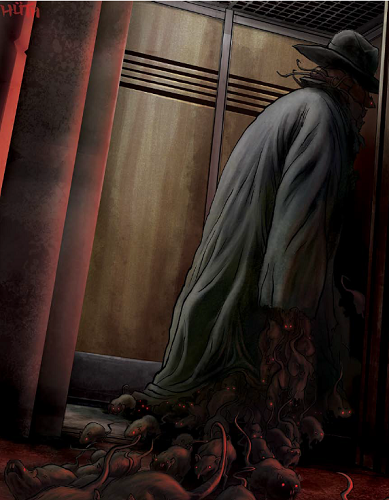
Turn into Creature
Become a bat, wolf, swarm of rats, or some other animal form. May heal all damage sustained before transforming. Witnessing the transformation is a 4-point Stability test.
Turn into Mist
May also be a swarm of flies or something. Become intangible, immune to all physical damage, and gain the ability to flow through tiny spaces. Aberrance test to move against the wind, +2 Stealth modifier, fire still does 1 damage.
Turn to Monstrous Form
The Castlevania Endboss Gambit. Pick a monster from this book or from Trail of Cthulhu for the monster form stats.
Stealth
Overlaps with invisibility. Sneaky vampires get up to +3 to Stealth Modifier for free. For further specific stealthy feats, spend Aberrance to raise difficulty on a Sense Trouble or Surveillance roll.
Strength
Vampires are physical powerhouses, much stronger than humans. When making a Hand-to-Hand attack, spend Aberrance 2-for-1 to increase inflicted damage. Beyond that, there's a whole table of Feats of Strength - each has a different Athletics difficulty for humans and strong vampires, and each costs 2 Aberrance to use. Throwing a person 3 meters is difficulty 4 for a vampire, but difficulty 12 for a human. Stopping an oncoming train is difficulty 20 for a vampire, but impossible for a human.
In combat, Throwing something freakishly heavy does a die of damage, plus half the difficulty of the roll to throw it.
Summoning
Vampires can summon things like swarms of rats or ghouls requires just a few seconds, summoning something more powerful - a demon lord, the mothership - requires several minutes and a complex ritual. Spending more Aberrance reduces the time needed. Vampires may be able to summon the dead as servitors, wild beasts, or anyone who shares their blood. Anything other than demons summoned by vampires must obey any commands it gives.
Venom
Big for mutant vampires - in addition to drinking blood, the bite injects poison. This could use either the toxin rules, or the mental attack rules, depending on the nature of the poison.
Anaesthetic
Instead of killing the victim or driving them insane, the bite injects a powerful anaesthetic. Possible effects:
-
No pain from the bite
-
No memory of the attack
-
Equivalent to Kolokol-1
-
Equivalent to truth serum
Spit venom
Like a snake. Range is Close, can obscure cameras or blind foes until treated with Medic.
Voice
Vocal attempts at manipulation can be modeled as mental attacks. For some more complex options:
Howl
A vampire howl that has the force tos mash windows or physically batter the listener. Treat as Telekinesis.
Infrasound
Secret communication that humans can't hear - or, it can be used to send messages that people can't consciously percieve as a mental attack. Infrasound in a room will put humans uncomfortably on edge.
Mimicry
Near-perfect imitation of any human voice - free or 2 points per scene. Listeners who have reason to suspect it might be a vampire can make a Stability test (Difficulty 4) to hear through the trick.
Ultrasonics
High-pitched noises that can communicate without humans hearing them, agitate dogs, or break glass.
Vampiric Weaknesses
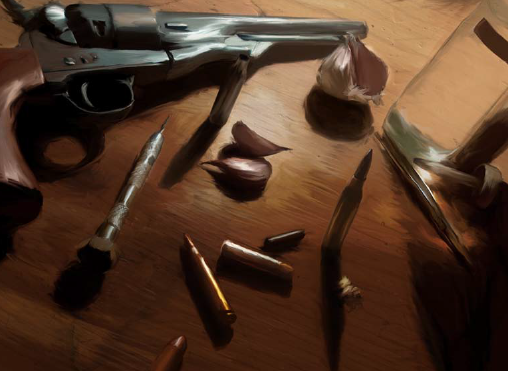
Vampires have an absurd number of unfair powers, but they make up for it with a vast array of possible weaknesses. Most of this is classified in NBA as Banes - special substances or techniques that can harm or destroy vampires. A list of possible Banes:
-
Beheading
-
Holy symbols - burns on contact for 1d6-1 damage, or 1d6 if applied to the face
-
The blood of a deadman, ingested (supernatural)
-
Death of the vampire's creator (supernatural, damned)
-
Drowning
-
Enchanted weapons (damned)
-
Exorcism (damned)
-
Fire
-
Wolves (supernatural)
-
Garlic
-
Holy water (damned)
-
Iron (meteoric iron, cold iron)
-
A specific bloodline of
Belmontsvampire slayers (supernatural)
-
Lightning
-
Spikes or impaling weapons
-
Sacred bullet, fired into the coffin (supernatural)
-
Severed spinal cord
-
Silver
-
Stake to the heart
-
Sunlight (damned, alien, mutant)
-
UV light (alien, mutant)
-
Blood thinner (mutant)
-
Wood (what kind?)
-
Does minimal damage, where other attacks do no damage
-
As per Hurt
-
Does normal damage
-
Does +1 or more extra damage
-
Ignores vampiric armor
-
Does double damage
-
Does damage, and turns the vampire to dust if it reduces them to -1/-12 Health
-
Damage done can't be regenerated (immediately, that scene, ever)
-
Instant destruction
Sunlight
Almost all vampires rule the night. For some, it's because that is when their powers are at their peak; for others, it's because the light of the sun will harm or destroy them. Sunlight acts as a special Bane that could do various things:
-
Disable all vampire powers
-
Prevent vampiric regeneration
-
Make it possible to kill the vampire
-
Hurt by exposure
-
Vampire becomes a corpse until removed from light
-
Damage as per fire while exposed
-
Damage dealt can't ever be regenerated
-
Vampire explodes
Holy Water
Vampire hunters are seldom seen carrying super soakers full of holy water, because that would be lame. To prevent this kind of cheesing: Holy water does damage on first contact, but then does none for the rest of the scene. The damage is caused by the holiness, and a larger volume doesn't make it any more holy.
Stakes and Beheading
A stake or beheading attack is a Called Shot to the heart or throat respectively, and requires an appropriate weapon. Such a called shot might be instantly fatal, or it might kill the vampire at -1 or -12 Health.
Staking or beheading an unconscious target is different - without your adrenaline doing the thinking for you, such a brutal execution may require a Stability test, especially if the vampire looks like someone you care about.
Blocks
Rather than causing damage, some soft Banes instead prevent the vampire from advancing. If it's not an absolute bar, it might instead be Aberrance difficulty 8 to cross. Even if they do cross, maybe it does damage.
Folklore and fiction give us lots of different vampire blocks:
-
Aloe vero
-
Blood of a black dog
-
Broom across or behind the door
-
Cigarette smoke
-
Holy symbols
-
Garlic, basil, hawthorn, holly, juniper
-
Incense
-
Neem-tree leaves
-
90-degree angles (???)
-
Entering a room without being invited
-
Peach-wood, rowan
-
Prayers written across the doorframe
-
Running water
-
Salt
-
Shoes turned backwards
-
Sticky rice
-
Wild rose
-
Wolfsbane
Compulsions
Mainly a thing for supernatural vampires, certain behaviors that vampires are required or compelled to always follow. Resisting a compulsion is a Difficulty 6 Health test.
-
Count spilled seeds
-
Drink blood if seen or smelled
-
Kill children
-
Sleep at sunrise
-
Solve riddles or puzzles
-
Untie knots
Dreads
Similar to blocks, there are Dreads - things vampires instinctively hate and fear. Advancing on or confronting one is Difficulty 6 Aberrance, taking any action other than trying to destroy it after confronting it is Difficulty 6 Health. Health lost this way cannot be regenerated until the next night.
-
Bright light
-
Cats, dogs
-
Consecrated ground
-
Holy symbols
-
Hemlock
-
Mirrors
-
The sound of bells
-
Wormwood
-
Pure white animals
Requirements
Vampires all have things they need to do to survive - most traditionally, drinking blood. Each day the vampire goes without its requirement, it loses 1 point of Health or Aberrance. When Aberrance reaches 0, the vampire is Hurt.
Requirements may be nightly, weekly, or monthly. Health or Aberrance lost this way cannot be regenerated until the requirement is fulfilled.
-
Cocktail of vampire drugs
-
Drinking blood
-
Exposure to moonlight
-
Possession of a certain artifact
-
Magic ritual
-
Return to place of origin
-
Sex
-
Sleeping in grave earth
-
Sleeping in native soil
Death and Resurrection
What happens when a vampire dies? Maybe it becomes a corpse, maybe it ages to the age its corpse would be if it had been dead all along, maybe it disintegrates into ash. This may happen at Health -1, the failure of a Consciousness roll, or at Health -12.
However, vampires can come back. In order to prevent a vampire's return, various precautions may be needed:
-
Soak the body in vinegar
-
Burn body to ashes and scatter them in running water
-
Bury body at a crossroads
-
Cut off head, fill mouth with garlic
-
Fire a sacred bullet into the coffin
-
Put brick on chest
-
Put sickle or nails in the coffin
-
Remove and burn the heart
-
Sprinkle poppy seeds over grave
-
Stake body into coffin and leave the stake in
-
Tie the coffen shut with knotted cords
-
Lay wild rose branches across the grave
Reversing some precautions may cause the vampire to come back the next night.
NEXT: Sample monsters.
VAMPIRES, PART 4
Original SA post
VAMPIRES, PART 4
Let's talk specifics! The book is nice to pre-build a bunch of generic vampires and monsters, just as it did human opposition earlier in the book. Here's what we've got:
Vukodlak
What you get when an evildoer dies unpunished and the body stays undiscovered for 40 days. They're pure evil and super ugly, and a bunch of them were raised during a solar eclipse over Bucharest in 1961.
During an eclipse, a Vukodlak's Aberrance and Health pools are doubled (partial eclipse) or quadrupled (total eclipse). It can drink Health from humans to recover up to twice its Health rating. Whatever Weapons and Shooting skill it has are from when it was alive, they don't improve after death. Vukodlak can be detected by pure white or black horses, have obvious eyes where one is far larger than the other, and cast no shadow. To kill it permanently, you must behead and hamstring the body or burn it to ash.
quote:
General Abilities: Aberrance 11, Hand-to-Hand 7, Health 7, Shooting 5, Weapons 5
Hit Threshold: 4
Alertness Modifier: +0
Stealth Modifier: +1 (lurks in ambush)
Damage Modifier: +1 (fangs or talons)
Armor: -1 (fur); weapons do halved damage, firearms only do 1 damage, shotguns only do 2.
Free Powers: Drain, Infravision
Other Powers: Astral Projection, Blight Crops (magic), Infection (those killed by vampire power), Mimicry (friendly voice calling target by name), Plague, Tunneling (in rat form), Turn to Creature (rat, black eagle)
Banes: Beheading, fire, silver, stake to the heart, wolfsbane
Compulsions: Astrally project during eclipse, count seeds
Dreads: Wolfsbane
Requirements: Drink blood
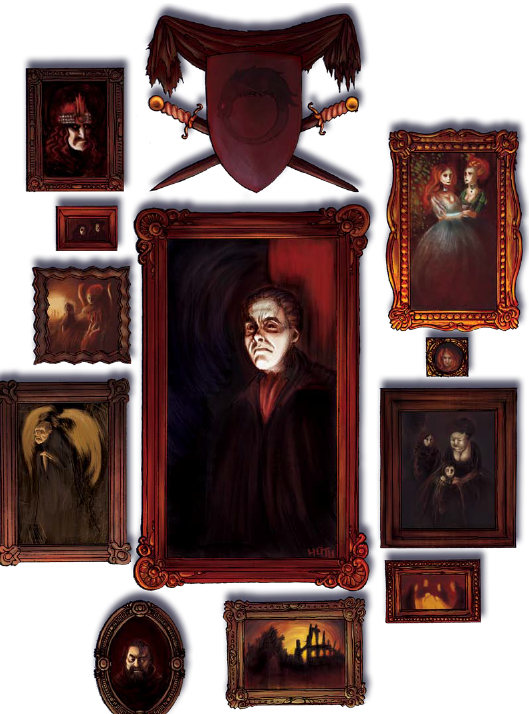
Children of the Dragon
The descendants of Vlad Tepes, the Impaler. Linea Dracula.
Vampires of this bloodline retain human hungers and sins, and can create new vampires - but the vampires they create are weaker than they are. By habit, they only turn their brides or most faithful retainers. By modern times, they've stopped having more children (children are just rivals when you're immortal) - there's only about 250 of them left in the world.
One faction of the Linea follows Vlad Tepes himself, the other follows Count John Dracula of the "Hungarian" line, born of Vlad's second wife. The only known cure for those turned by the Linea is to destroy their master. They cannot be seen in mirrors or on camera and cast no shadow. The only way to prevent their return is to separate the head from the body.
quote:
General Abilities: Aberrance 17, Hand-to-Hand 11, Health 11, Weapons 13
Hit Threshold: 7
Alertness Modifier: +3
Stealth Modifier: +3
Damage Modifier: +3 (sword)
Armor: -1 (tough skin); unfeeling
Free Powers: Drain, Infravision, Regeneration (all damage from physical weapons at sunset)
Other Powers: Addictive Bite, Apportation (when invited or to native earth), Clairvoyance (those he has bitten), Cloak of Darkness, Dominance, Infection (those who drink vampire blood), Magic, Mesmerism (eye contact or voice), Necromancer, Send to Sleep, Spider Climb, Strength, Summoning (rats, wolves), Turn to Creature (bat, wolf), Turn to Mist, Vampiric Speed
Banes: Beheading, stake to the heart, sunlight (prevents use of powers)
Blocks: Can't enter a room without being invited, holy symbols, running water, wild roses
Compulsions: Kill and drain a fallen enemy
Dreads: Holy symbols, garlic, mirrors
Requirements: Drink blood, must sleep in native soil each night
Add an extra +3 to Aberrance and +2 to Hand-to-Hand and Health for each 50 years of unlife. Vlad himself has been a vampire since 1466, I'll let you do the math on how scary he is by now.
Vampiric Assign
A spouse or servant of the Linea Dracula, turned into a vampire. +2 to Aberrance and +1 to Hand-to-Hand and Health for each 100 years of unlife. No shadow, but they do cast reflections - the reflection shows pain and torment. After being killed by a bane, they don't return.
quote:
General Abilities: Aberrance 11, Hand-to-Hand 5, Health 7, Weapons 7
Hit Threshold: 5
Alertness Modifier: +2
Stealth Modifier: +1
Damage Modifier: +0 (dagger), +0 (bite), -1 (fist, kick)
Armor: -1 (tough skin)
Free Powers: Drain, Infravision
Other Powers: Addictive Bite, Cloak of Darkness, Mesmerism (eye contact or voice), Spider Climb, Strength, Vampiric Speed
Banes: Beheading, holy symbols, stake to the heart, sunlight (prevents use of powers)
Blocks: Can't enter a room without being invited, holy symbols, running water, wild roses
Compulsions: Obey sire
Dreads: Holy symbols, garlic, mirrors
Requirements: Drink blood, must sleep in native soil each night
Alien Stone
Vampires are silicon-based alien extradimensional creatures that fell to Earth ten thousand years ago. They don't live in the sense that we understand it, but they warp time and causality around themselves even while living as huge, unmoving stone statues. Mirrors keep them dormant as they perceive their own perception in an infinite feedback loop.
Over millenia, the alien stones have become inert, and their bodies have broken apart and been separated. However, their immortal human servants still carry out their bidding on our plane, and advances in technology have uncovered new ways to revive the stones artificially.
When fully awakened, an alien stone is so powerful that defying it is virtually impossible. Just being perceived by one triggers a 5-poing Stability test. They exist outside of time as we understand it, allowing ther ability pools to refresh instantly, making their point pools functionally infinite. They can warp gravity and space-time for tens of miles in any direction. The only way to destroy them is to expose them to sunlight, or use powerful explosives to disrupt their impossible, alien geometry.
quote:
General Abilities: ?
Hit Threshold: ?
Alertness Modifier: -3 (looking in mirror) or +3 (in the presence of fresh blood)
Armor: -5 (stone)
Free Powers: Clairvoyance (through any part of their body, down to the molecule), Darkvision, Drain, Infection (those who ingest alien matter), Levitation, Mental Blast (damages Stability), Necromancy, Prophecy, Regeneration (all damage, instantly), Summoning (infected), Temporal Distortion, Time Warp (shift anything they perceive into another time when the stone exists)
Banes: Sunlight (explodes on the level of a nuclear device)
Blocks: Chaotic streams (running water, random charge fluctuations)
Compulsions: Answer questions after blood sacrifice
Perfectus Petri
The once-human servants of the alien stones. Their blood and flesh have been replaced with strange alien matter, and they have become immortal.
Perfecti cannot be seen in mirrors or on most cameras. The only way to permanently destroy them is to turn the body into dust and dump it in running water.
quote:
General Abilities: Aberrance 10, Hand-to-Hand 16, Health 20, Weapons 5
Hit Threshold: 5 (6 in darkness)
Alertness Modifier: +2 (+3 in presence of fresh blood)
Stealth Modifier: +1 (+2 in darkness)
Damage Modifier: +2 (fangs), +1 (claws)
Armor: -3 (alien flesh), unfeeling
Free Powers: Darkvision, Drain, Regeneration (all damage at beginning of next round), Temportal Distortion
Other Powers: Apportation, Cloud Men's Minds, Infection (those who ingest alien matter), Levitation, Mind Control (eye contact), Necromancy, Spider Climb, Strength, Turn Intangible, Vampiric Speed
Banes: Fire (damage does not regenerate), sunlight (explodes, but smaller)
Blocks: Chaotic streams
Dreads: Mirrors
Requirements: Drink blood
Marburg Vampire
Dr. Aleksei Valentinov of the VECTOR institute in Russia did work to weaponize the Marburg Virus . In 1988, Dr. Ustinov died from acciental exposure to a new strain called Marburg U, and Valentinov adapted his work with Western genetic engineering techniques to produce Marburg V, which reconfigures its host as a biological weapon.
Every human reacts to the virus differently - pick three of the Other Powers separately for each host. They can use biofeedback to transfer points between their general ability pools each round (but if they do, they have to act last that round). They have red eyes and elevated body temperature, but otherwise can pass for human.
quote:
General Abilities: Aberrance 9, Hand-to-Hand 5, Health 9, Shooting 5
Hit Threshold: 5 (hotwired reflexes)
Alertness Modifier: +1
Stealth Modifier: +0
Damage Modifier: -1 (fist, kick)
Armor: None
Free Powers: Drain, Infravision, Plague (body fluid contact), Unfeeling
Other Powers: Apportation, Blood Will Tell, Heightened Senses (smell blood, hear heartbeats), Memory Haze, Pheromone Control, Regeneration (2 per round), Send to Sleep, Spit Venom, Strength, Vampiric Speed (only for Extra Attacks, Jumping In, or Mook Shield, 2 Aberrance each)
Banes: Normally fatal attacks, garlic
Compulsions: Drink fresh blood, obey Valentinov
Dreads: Bright light (sunlight Hurts), garlic
Requirements: Cocktail of boosters and suppressants administered weekly
NEXT: Non-vampire monsters.
VAMPIRES, PART 5
Original SA post
VAMPIRES, PART 5
Just because this is a vampire game doesn't mean there aren't other kinds of monsters about! Maybe vampires can summon demons. Maybe Demons can summon vampires. Maybe some of these are just the true forms of your game's breed of vampires.
The book is clear that statblocks and abilities are suggestions - if you want winged ghouls or hardcore combat lamiae, go for it.
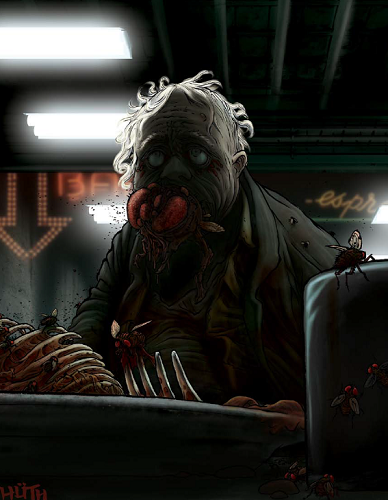
Adzeh
Awful insect demons that drink the life of men, beasts, and crops. Adzeh can take two main forms - a single insect commanding a swarm of blood-drinking flies or mosquitoes, or a 'brain bug' that infests a human host.
As a brain bug, an Azdeh increases the Athletics, Hand-to-Hand and Health of the host by +5. Turn to Creature is just the Adzeh leaving its host, and is accordingly free. Removing an Adzeh from a host drops them to -6 Health and immediately forces a Consciousness roll.
quote:
General Abilities: Aberrance 10, Hand-to-Hand 6, Health 6
Hit Threshold: 8 (4 if it's a worm), or 5 against an area effect weapon.
Alertness Modifier: +1
Stealth Modifier: +2 in insect form, +0 for a human host
Damage Modifier: -1 (for human host), +0 (bite for human, or attacks against helpless victims as an insect), -1 (face suck), -2 (bite as insect)
Armor: None as human, immune to physical attacks as an insect swarm, vulnerable to fire, as a single insect it dies from any damage
Free Powers: Drain, Infravision, Unfeeling (on possessed human)
Other Powers: Mesmerism (buzzing voice), Necromancy, Possession (brain bug), Regeneration (3 Health per hour as human, can resurrect itself once per Health drained as a bug), Spider Climb, Strength, Turn to Creature, Vampiric Speed, Wings (free in insect form)
Banes: Fire
Blocks: Per vampires in campaign
Compulsions: Obey creator
Dreads: Per vampires in campaign
Requirements: Drink blood, palm oil or coconut water
Bhuta
An Indian monster somewhere between a ghost, a demon and a vampire. Rakshasa may actually be Bhuta, or vice versa. They are skilled in magic and can possess humans and speak thruogh them.
NBA's Bhuta emphasizes the shadowy nature of the bhuta - it's more ghost than physical creature. Its Hit Threshold is cumulative with darkness penalties. For a full-on shadow vampire, add Infection, Mesmerism and Strength to its abilities, and increase Aberrance. Powerful Bhuta can freely move points between Aberrance and Health at the beginning of any round. You can identify someone possessed by a Bhuta because their feet don't touch the ground.
quote:
General Abilities: Aberrance 7, Hand-to-Hand 10, Health 11
Hit Threshold: 6 in darkness, 3 in light
Alertness Modifier: +1
Stealth Modifier: +3 in darkness, +1 in light
Damage Modifier: +0 (talens, fangs, heat drain)
Armor: Physical weapons do no damage, fire does 1 damage
Free Powers: Darkvision, Drain, Heat Drain (adds to Health pool), No Reflection, Spider Climb
Other Powers: Apportation (between shadows), Cloak of Darkness, Necromancy, Plague, Possession, Reassuring Illusion (disguise as a form drawn from the victim's mind), Turn to Bat, Wings
Banes: Consecrated arrow (also pins in place, lowering Hit Threshold to 3), sunlight (damages each round), UV light
Blocks: Per vampires in campaign
Compulsions: Obey creator
Dreads: Per vampires in campaign
Requirements: Drink blood, palm oil or coconut water
Camazotz
Part man, part bat, all beheading, blood-drinking murder monster. This is an ideal "true form" for a powerful vampire.
The Camazotz can behead a victim with a claw by making a Called Shot to the throat, generally sized against NPCs who die at Health 0. It can do a dive attack to attack and then fly off to Near range or a nearby rooftop on the same round. It can grab a target for half damage, then drill with its proboscis on the following round; escaping its grip is Difficulty 5 Athletics, increasable with Aberrance.
quote:
General Abilities: Aberrance 11, Hand-to-Hand 23, Health 14
Hit Threshold: 4
Alertness Modifier: +2 (+9 if it's tasted or smelled your blood before)
Stealth Modifier: +2 (in flight), +0 (on ground)
Damage Modifier: +2 (talons, fangs, grab), +3 (beheading claw), +5 (proboscis)
Armor: -2 (leathery skin), another -2 VS melee weapons, guns to half damage after armor
Free Powers: Dive Attack, Drain, Infravision, Regeneration, Wings
Other Powers: Cloak of Darkness, Levitation, Sonar, Spider Climb, Strength, Summoning (flock of bats), Tracking (follow blood it's tasted or smelled over any distance across land), Turn Invisible, Vampiric Speed
Banes: Per vampires in campaign
Blocks: Per vampires in campaign
Compulsions: Obey sire, return to lair by sunrise
Dreads: Per vampires in campaign
Requirements: Drink blood
Dhampir
From Romany lore, a half-human, half-vampire offspring. Often taking the role of a vampire slayer, the dhampir has no bones, allowing it to fit through tiny gaps, and can detect vampires with senses lost to humans.
Dhampirs may be immune to vampire bites as NPCs, or may take Vampire Resistance as a power for a PC dhampir (if the Director allows such a thing). As a foe, they're very powerful vampire vassals, capable of operating in direct sunlight and still using most of their powers. A more powerful version of the dhampir is the daywalker - a creature with all of a vampire's powers, and none of its weaknesses. However, such creatures don't rise from the dead after being slain.
quote:
General Abilities: Aberrance 12, Hand-to-Hand 6, Health 12, Shooting 6, Weapons 6
Hit Threshold: 5
Alertness Modifier: +2 (+4 to detect vampires)
Stealth Modifier: +1
Damage Modifier: +2 (sword), +0 (stake), +0 (bite), -1 (fist, kick)
Armor: -2 for physical attacks, immune to toxins
Free Powers: Infravision, No Shadow, Regeneration (half of all physical damage at start of next round
Other Powers: Boneless Flexibility, Detect Vampires, Spider Climb, Strength, Vampiric Speed
Banes: Beheading, fire, stake to heart
Blocks: Cannot cross a church threshold
Compulsions: Keep the Sabbath, obey/kill sire
Requirements: Drink blood (addictive disorder)
Feral Vampire
Like a vampire, but brand new, and still crazy with thirst and newfound power. They hunt in packs - if three ferals attack someone in the same round, the Hit Threshold is -1 against the third attack.
quote:
General Abilities: Aberrance 9, Hand-to-Hand 9, Health 9
Hit Threshold: 5
Alertness Modifier: +2
Stealth Modifier: +1
Damage Modifier: +1 (talons), +0 (bite), -1 (fist, kick)
Armor: -1 (tough skin), firearms do half damage
Free Powers: Drain (Health cap 18), Infravision, Regeneration (all damage at sunset), Unfeeling
Other Powers: Extra Attacks (first extra attack is free, furthers cost 2 Aberrance or Hand-to-Hand), Spider Climb, Strength, Vampiric Speed
Banes: Per vampires in campaign, sunlight may damage faster
Blocks: Per vampires in campaign, +2 to Aberrance test difficulty to override
Compulsions: Drink fresh blood, obey sire
Dreads: Per vampires in campaign
Ghoul
Pack-traveling dog-like corpse-eating cemetery monsters used as dumb muscle by vampires. The stat-block can also be used as a basis for werewolves, if they exist in your setting.
Ghouls get the same pack hunting ability as feral vampires, plus something called a "Worrying Bite" - if a ghoul hits with a bite, they can bite again next turn to do double damage. After that, all subsequent bites automatically hit, but the person it's latched onto can attack it at Hit Threshold 3.
quote:
General Abilities: Aberrance 9, Hand-to-Hand 9, Health 9
Hit Threshold: 4
Alertness Modifier: +2 (+0 in daylight)
Stealth Modifier: +1
Damage Modifier: +1 (talons), +0 (bite)
Armor: -1 (tough skin), firearms do half damage
Free Powers: Infravision, Regeneration (all damage next scene), Unfeeling
Other Powers: Extra Attacks (first extra attack is free, furthers cost 2 Aberrance or Hand-to-Hand), Heat Drain, Mimic Form, Plague, Spider Climb, Strength, Tunneling
Banes: Fire, sunlight (Hurt by exposure)
Blocks: Can't eat normal food, crimson thread, the name of God, Passover bread
Compulsions: Obey sire
Dreads: Bells and other loud noises
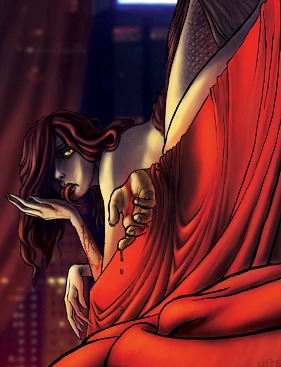
Lamia
Female vampires with serpentine features who seduce - literally or metaphorically - men for blood. Especially hates children. Human-shaped, but always with one weird feature - forked tongue, a second mouth under her hair, snake eyes. Either doesn't cast a shadow, or casts a snake's shadow.
A lamia can strangle with a Hand-to-Hand attack for +0 damage, either as a Called Shot or as a 2-Aberrance spend. After the first hit, she does +0 damage again each round, Athletics 5 to break free.
quote:
General Abilities: Aberrance 10, Hand-to-Hand 4, Health 10
Hit Threshold: 5
Alertness Modifier: +2
Stealth Modifier: +2
Damage Modifier: +0 (bite), +0 (strangling grasp)
Armor: -1 (scales or porcelain skin)
Free Powers: Anaesthetic bite (remembered as a sexual encounter), Darkvision, Drain, Psychic Vampirism, Regeneration, Remote Drain
Other Powers: Addictive Bite, Cloak of Darkness, Cloud Men's Minds, Enter Dreams, Infection, Levitation, Magic, Memory Wipe, Mesmerism (eye contact or voice), Mind Probe, Plague, Send to Sleep, Spider Climb, Spit Venom, Stifling Air, Turn to Deer/Mist/Snake/Statue, Vampiric Speed, Venom, Wings
Banes: Beheading, destruction of magic cauldron (loses all powers), iron, sunlight (blocks all powers)
Blocks: Can't enter a room without being invited, can't escape grave if stones are piled on it, moly flower
Compulsions: Attack childbearing women, dance to snake-charming music, gaze at own reflection, kill children
Dreads: Moly flower
Requirements: Drink blood, mate
Murony
A vampire from Romanian lore who astrally projects from the grave. In order to stop it, you have to find and destroy the corpse. May appear as a spectral vampire, an animal, a glowing blob or something else.
When a murony drains Health, it can send the points to the body in its grave. This block can also function as a ghost statblock.
quote:
General Abilities: Aberrance 16, Hand-to-Hand 6, Health 6
Hit Threshold: 5
Alertness Modifier: +0
Stealth Modifier: +2
Damage Modifier: +0 (blood/heat drain), +0 (hurled object)
Armor: Physical weapons do no damage, fire does 1 damage
Free Powers: Darkvision, Distortion, Drain, Psychic Vampirism, Remote Drain
Other Powers: Heat Drain (drained Athletics adds to Health), Illusionary Shape, Levitation, Plague (damage adds to Health), Send to Sleep, Stifling Air (damage adds to Health), Telekinesis
Banes: None in spirit form, destroying its body by beheading, staking and filling the mouth with garlic, burning the heart
Blocks: Bitter herbs, holy symbols, garlic
Compulsions: Count millet seeds
Dreads: Holy symbols, garlics
Requirements: Drink blood, return to body at noon
Renfield
Named for the character in Stoker's novel, a "Renfield" is a human servant of vampires, granted a few drops of vampire blood to seal the contract. They pass as human to anything short of a full blood analysis.
Pick a human enemy, then add 12 points to their stats, plus +1 to Alertness Modifier and +1 to all melee modifiers. Then, add any two of the listed Free Powers and any one of the Other Powers. They should blur the line between human opponents and vampire opponents. The stats below are for a police officer Renfield.
quote:
General Abilities: Aberrance 9, Hand-to-Hand 8, Health 9, Shooting 8, Weapons 7
Hit Threshold: 4
Alertness Modifier: +2
Stealth Modifier: +0
Damage Modifier: +0 (knife or baton), -1 (fist, kick), +1 (9mm pistol)
Armor: None, or -1 as a free power
Free Powers: Enhanced Hearing (hearbeat, +2 Difficulty to evade), Infravision, Regeneration (2 per round), Tracking by Smell, Unfeeling
Other Powers: Apportation, Cloud Men's Minds, Heat Drain, Mesmerism (eye contact or voice), Spider Climb, Strength, Summoning (rats or spiders), Vampiric Speed
Blocks: If vampires in the campaign radiate unholy power, church thresholds may block Renfields at -2 Difficulty
Compulsions: Drink blood (as Addictive Disorder), obey master
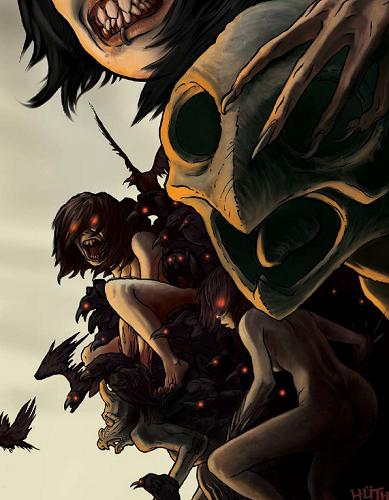
Strix
Witches that transform into birds. Started as a child-killing folklore creature, eventually gained vampiric traits. Can turn into ravens, owls, crows, or blackbirds, either with no change to pools or shifting once per scene to refresh all pools.
A strix can attack someone's shadow as an attack or Drain attack, effectively causing -1 to enemy Hit Thresholds in anything above Pitch Black conditions. The strix will resurrect the night after it's killed, or at the next new moon if it was burned to death. The only way to kill it for good is to find the egg in which it hides its soul and destroy it.
quote:
General Abilities: Aberrance 12, Hand-to-Hand 4, Health 5
Hit Threshold: 4 (human), 5 (bird)
Alertness Modifier: +1 (human), +3 (bird)
Stealth Modifier: +0 (human), +3 (bird)
Damage Modifier: -2 (fist, kick), -1 (peck, claw)
Free Powers: Darkvision, Drain, Hive Mind, Remote Drain, Shadow Attack, Soul Egg, Wings
Other Powers: Clairvoyance (through flocks of birds), Cloak of Darkness, Magic, Mesmerism, Necromancy, Send to Sleep, Summon Birds, Turn to Bird, Vampiric Speed
Banes: Sunlight (cannot change shape)
Blocks: Hawthorn, per vampires in campaign
Dreads: Garlic
Requirements: Drink blood, eat human flesh
Vorthr
Powerful undead assigned to guard something of great importance, such as a vampire lord's crypt. Can reflavor as a mummy, a golem, a hell hound, or something else, with a few alternate powers.
A vorthr can stretch its arms to make a Point-Blank attack from Close range. Varying by legend, it might only be vulnerable to bare-handed attacks, or you must have to behead it, leap between its body and head before it hits the ground, then burn the body and scatter the ashes at sea.
quote:
General Abilities: Aberrance 13, Hand-to-Hand 24, Health 17, Weapons 12
Hit Threshold: 6
Alertness Modifier: +1, +3 in barrow
Stealth Modifier: +0
Damage Modifier: +3 (sword), +2 (talons)
Armor -3 (thick flesh), all weapons do half damage, firearms do 1 damage, shotguns do 2 damage
Free Powers: Darkvision, Drain, Extensible Arms, Psychic Vampirism, Regeneration (all damage at start of next round while in barrow)
Other Powers: Cloak of Darkness, Extra Attacks (2 Aberrance each), Heat Drain, Magic, Spider Climb, Stifling Air, Strength, Tunneling, Turn to Mist
Banes: Bare-handed attacks, beheading (only at -11 health), own sword
Blocks: Per vampires in campaign
Compulsions: Guard site
Requirements: Return to barrow or guarded site
Zombie
Reanimated corpse with no vampiric powers. Handy as guards, could follow either the Romero style (infectious bite) or the Haitan style (laid to rest with salt).
Zombies can grip foes as a Hand-to-Hand attack, doing no damage but reducing the Hit Threshold of the zombie and its target. Athletics 5 to escape.
quote:
General Abilities: Aberrance 5, Hand-to-Hand 7, Health 7, Weapons 2
Hit Threshold: 3 (2 for slow zombies, 4 for fast zombies)
Alertness Modifier: -1
Damage Modifier: -1 (bite), +0 (improvised weapon), grab
Armor All weapons to half damage, firearms do 1 damage, shotguns do 2 damage
Free Powers: Infection (Health test equal to bite damage every 10 minute after bite, become a zombie on death)
Banes: Destruction of the brain (called shot at +2, must do at least 2 damage), salt
Compulsions: Eat brains, lie down and die upon tasting salt, move toward loud noises, obey master
Vampire Forms and Familiars
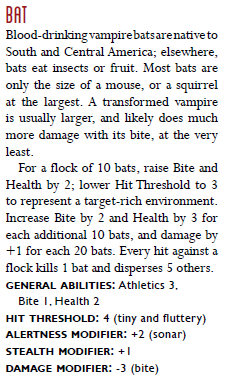
Vampires can turn into a bunch of animals, they're less exciting than the main monsters so I'm not gonna detail out every one. Bat, Cat, Flies, Owl, Rat, Serpent, Wolf. That about wraps it up for monster statblocks.
Next: Conspiracies.
VAMPIRES, PART 6
Original SA post
VAMPIRES, PART 6
Last part of the vampire chapter! The conspiracy is the greater enemy organization - it's something for the heroes to shoot at and unpack until the final battle. Uncovering the shape of the vampire conspiracy is the primary engagement of NBA's campaigns, and no two are alike.
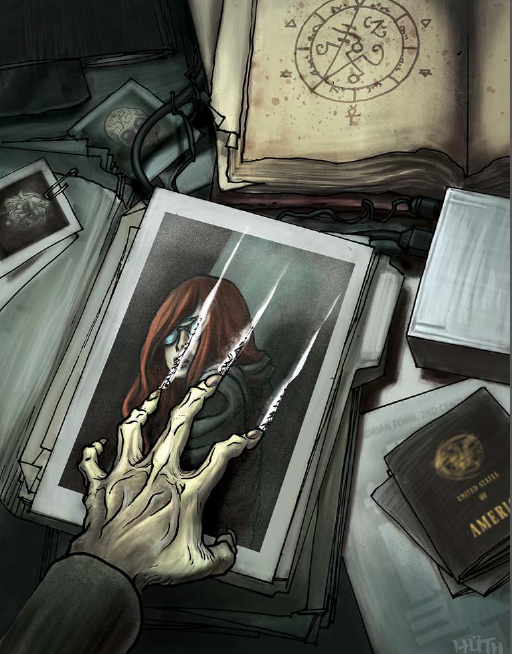
Conspiratorial Considerations
Vampire conspiracies can be as big or as small as the game requires - one vampire and a clan of pariahs, or a secret world government that rules nations across the globe from the shadows. When kicking things off, consider:
-
Longevity: How long have the vampires been around? Were they ancient Babylonian kings, or did they come from a UFO crash in 1988? The older the conspiracy is, the more powerful it's likely to be - an old but weak conspiracy requires a lot of internal strife.
-
Amplitude: How deep does the conspiracy go? Do they dominate the trade of Etruscan antiquities, or do they control entire governments? Bigger is scarier, but also can run into problems with suspending disbelief.
-
Magic: What kind of power do the vampires have access to? Do they have technology salvaged from Lemurian ruins, or the power to command other undead? The more larger-than-life the powers the conspiracy can bring to bear, the more exciting, but it can also kill the real-world tone of the spy bits of the game.
-
Intentions: What is the conspiracy after? Opening the gates to hell? Reducing humans to cattle? The book boils this down to three categories: Parallel State (use a public-facing organization such as a syndicate or military-industrial complex as a shell for their own goals), Replacement State (take a group of power and replace them with their own people), Anti-State (openly destroy the group in power without replacing it).
-
Allegiances: Who are their allies? The Soviets? The Nazis? This can deeply affect what kind of objectives the conspiracy is chasing, but be aware of the level of political intrigue your party is willing to put up with.
-
Exclusivity: Is this all the vampires? Are there other cells outside the conspiracy? Who else knows about them?
The Conspyramid
You've got your ideas, time to build the enemy conspiracy! This is done via building a chart called a Conspyramid.
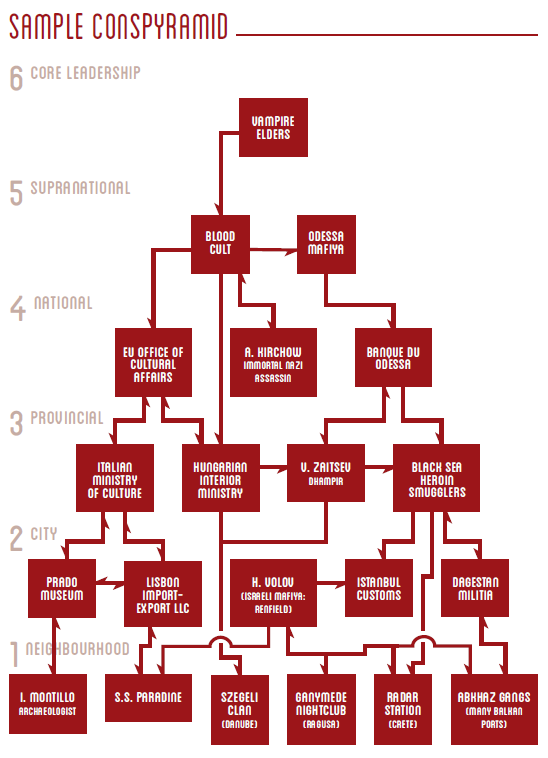
The Conspyramid is a chart of who's at what levels of power in the conspiracy, and how they connect together. There are six tiers:
-
Street-level power: Gangs, warehouses, police precincts, professors or scholars.
-
City-level power: Factory, labor union, military captains, hospitals, university departments, millionaires, legislators.
-
Provincial power: Merchant banks, industry-wide unions, TV stations, colonels, museums, airports, presidential aides.
-
National power: Corporations, TV networks, generals, cabinet department heads.
-
Supranational power: Cardinals, international crime lords, multinational corporations, government leaders.
-
Vampires: The top.
Of course, it doesn't need to look exactly like that, depending on the scale of your conspiracy. The main thing the Conspyramid provides is narrative structure - once you know the shape of the enemy forces, you have a sense of the overall arc of the game. Lines of control connecting nodes on the pyramid are leads that the agents can follow to uncover more about the conspiracy. The higher in the pyramid the agents are targeting their attacks, the more you need to start thinking of bringing the game towards a big finish.
It can be worth leaving some arms of the Conspyramid blank - then, you can retroactively fill them in to tailor the conspiracy towards the story as it unfolds.
Campaign Modes and Conspiracies
In Burn games, the conspiracy should include people the agent cares about. Uncovering the conspiracy should cause damage to your own loyalties. Make each node something that will cause one of the agents to recoil.
In Dust games, the default conspiracy is recently-established (in the last 70 years), moderate size, and has no extra magic powers beyond its vampires. If the conspiracy is larger, it's probably fractured into rival cells.
In Mirror games, the conspiracy necessarily includes upwards of half of the agents' former patrons. Conspiracies should be huge, and tangled in everything. The agents should wonder at every moment whether or not anyone could be one of Them.
In Stakes games, the conspiracy should primarily include the enemies of the forces that the agents fight for. Keep the enemy relatively pure evil, rather than murky and full of internal strife and moral decay.
Mechanics
The Conspyramid is a handy resource for balancing foes as the game moves on. For a given obstacle, the test Difficulty should be about equal to Conspyramid Level + 3. For a given foe, their abilities should be about equal to (Conspyramid Level + 1) x 2. This is a rough ad-hoc guideline more than anything, but the general idea is that the closer you get to the peak, the fiercer the opposition becomes.
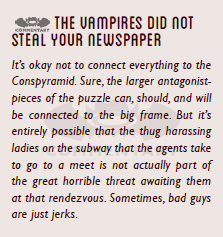
Conspiratorial Components
Any conspiracy needs, at a minimum, three things: Money, blood, and protection. The Conspryamid should include nodes that provide all of these.
Money
Banks (level 2-5) are an obvious node for funding, either from direct control or just by stealing from them. If not, maybe casinos (level 2-3) or drug cartels (level 1-4).
Blood
Human trafficking rings run between 200,000 and 700,000 people through Europe every two years. Slaves and sex workers are an easy blood source for vampires, due to being comparitively off the grid. If your vampires aren't into human trafficking, there are blood banks and medical charities, but they're under a lot more government scrutiny.
Protection
An obvious gimme is the police - at least one high police official in any city where the conspiracy operates is probably part of the conspyramid. They may even own a full police department (level 2-4). If not police, then security forces or intelligence agencies are good high-level picks.
Other
Further nodes will probably be more directly tied to the conspiracy's greater goals. Cults, masonic lodges, academic departments, auction houses, research facilities, political parties, shipping lines. Mix and match as sounds fin.
Alternate Conspiracy Structures
Maybe the vanilla Conspyramid is too straightforward for you! Here's some other ideas:
-
Distributed: Many non-communicating arms, one head. Plant info every 2-3 cells, the tiny clues eventually building towards the location of central leadership. Based on al-Quaeda.
-
Multicellular: There's no hierarchy. Cells operate independently towards a single ideological goal, only occasionally forming alliances. Could work for a setting where each vampire has their own local power base, this is a very hard conspiracy to totally take down. Inspired by the Russian mafiya.
-
Shell: Nodes on the conspiracy are hollow shells, which conspirators move freely between. Efficiency is dropped in favor of security and invisibility. Works best for vampires who can easily assume new identities or who work chiefly through human puppets. The agents must anticipate vampire movements and destroy the nodes they escape to. Inspired by BCCI.
-
Truncated: There are only a small handful of actual conspirators. Just a couple people, staying in constant motion, who the agents have to hunt down while dodging their hirelings and assassins. Inspired by the Treadstone conspiracy in the
Bourne
movies.
More on how to use this once we reach the GMing chapter. For now, we're finally done talking about the bad guys.
Next: Cities.
CITIES, PART 1
Original SA post
CITIES, PART 1
Enough vampires, more setting! Spy thrillers can wind up just about anywhere, but a whole lot of it will be in cities. You want your cities to feel cinematic and dynamic, full of crowded marketplaces and famous landmarks and awesome gunfight setpieces. This chapter is about making interesting cities.
One of the main things that will shift as you travel between countries is which organizations are locally active. You can be as realistic as you want here - either use real intelligence agencies, add fictional ones like IMG or SD-6, or revive extinct ones like SMERSH, depending on the tone you're going for. Do the same with criminal rings and terrorist groups, or even entire countries.
Like most of the setting fluff in this book, everything in this chapter is jumping-off points for your own worldbuilding, rather than hard and fast rules. The important thing is that the more acronyms you hear, the more it feels like a spy thriller.
I can't speak to the accuracy of any of the below, international intelligence isn't my strong point.
Backstage Europe
Not all the countries listed in this section are European - some of them are other countries with agencies potentially engaging in espionage in Europe.
Bulgaria
The First Directorate of the Committee for State Security (KDS) was in cahoots with the KGB during the cold war, famously attempting the assassination of Pope John Paul II in 1981. In the modern day, they're replaced by the National Intelligence Service (NIS), aiding the CIA in anti-terrorist organizations.
China
The Ministry for State Security, also known as the Guóanbù, is the main intelligence/security force for the Communist regime. They may be monitoring Chinese residents abroad in Europe, flooding the target area with hundreds of low-level temporary assets, then analyzing their data back in Beijing. China's famed cyberintelligence force works for the Military Intelligence Department (MID).
France
One of the most tangled intelligence apparati this side of America. The Direction Générale de la Sécurité Extérieure (DGSE) handles foreign intelligence, the Direction Centrale du Renseignement Intérieur (DCRI) handles domestic security, both do industrial espionage, the Direction du Renseignement Militaire (DRM) handles military intelligence, the Police Nationale does organized crime investigations, and Direction Nationale du Renseignement et des Enquêtes Douanières (DNRED) handles smuggling and cybercrime operations.
Germany
Bundesnachrichtendienst (BND) mainly handles external intelligence operations, but also takes on organized crime and WMD proliferation. The Bundesamt für Sicherheit in der Informationstechnik (BSI) covers government information security and also keeps an eye on the banking industry. The Bundesamt für Verfassungsschutz (BfV) performs counter-espionage and monitors extremist groups, and the Bundeskriminalmt (BKA) handles anti-mafia and international crime operations. Germany rigorously delimits its own intelligence agencies, due to the nation's past run-ins with totalitarianism.
Great Britain
MI5 is Britain's domestic intelligence and counter-espionage organization, supported by the secret intelligence service MI6, home of James Bond. Less well-known is the security intelligence group Defence Intelligence, and the cryptoanalysis group GCHQ. Counter Terrorism Command (SO15) fights terrorism in London, and was founded in the 19th century to combat Irish terrorists.
Israel
Mossad, Israel's external intelligence agency, has orchestrated assassinations, kidnappings, and sabotage of WMD components intended for Israel's enemies. It's on good terms with BND, MI6 and the CIA. Domestic intelligence is covered by Shin Bet (ISA), cyberwarfare is handled by Unit 8200.
Italy
The intelligence agencies in Italy reshuffled twice in recent history. Neo-fascists attempted a coup of the military intelligence service (SID) in 1970, and it was replaced with SISIMI. In 2007, massive internal corruption was revealed, and now external intelligence is covered by AISE, domestic security by AISI, and information security by DIS, each under parliamentary control. Mafia investigations fall to ROS, narcotics and financial crime are handled by Guardia di Finanza.
Poland
The SB security agency was eliminated after the cold war. The UOP was reshuffled in 2002 following corruption allegations. Now external intelligence is handled by the Intelligence Agency (AW), external intelligence by the Internal Security Agency (ABW), counter-intelligence by the SDK, and military intelligence by the SWW. Polish agencies have worked closely with the CIA and NSA since 1990.
Romania
Romania is a former COmmunist state, linked to US intelligence through the Foreign Intelligence Service (SID). Domestic intelligence is handled by the Romanian Intelligence Service (SRI), the successor to the Cold War era's feared Securitate.
Russia
The KGB split into two agencies after the fall of Communism - the Foreign Intelligence Service (SVR) and the Federal Security Service (FSB). Both are dwarved by the Main Intelligence Directorate (GRU), with six times the spy count of the SVR and control of a global SIGINT network. The GRU is the largest intelligence organization on the planet, carrying out assassinations and illegal operations both domestically and abroad.
Sweden
The Military Intelligence and Security Service (MUST) handles both domestic and foreign intelligence. Within MUST, the Office for Special Acquisition (KSI) handles espionage, working with foreign agencies. Journalests uncovered a secret agency called IB within the Swedish armed force, which was never dissolved.
Turkey
The once-military now-civilian Milli Istihbarat Teskilati (MIT) handles intelligence and security here, competing with the KDSM on terrorism operations. MIT used to recruit exclusively from the families of current MIT officers, but this is changing over time.
Ukraine
The Foreign Intelligence Service (SZRU is an awesome acronym) split off from the Security Service of Ukraine (SBU) in 2005. SBU has been criticized for a dozen reasons since Ukranian independence, and notably may have attempted to thrwart the Orange Revolution and return the country to Russia.
United States
Hoo boy. 16 major intelligence elements, almost 2000 independent contractors, $80 billion a year in spending, over 100,000 employees. The big players are the CIA and the NSA, but the CIA has been seen as increasingly obstructionist and incompetent and is getting worked around by the DIA. Other players: OTFI, the FBI, and the DSS, all active in the European theater.
The Vatican
The National Military Union (NZW) ran Vatigan intelligence until at least 1956, but the its successor, if any, remains a mystery. Some have speculated that it's an arm of the Sovreign Military Order of the Knights of Malta (SMOM), or Sodalitium Pianum, or Opens Dei, or the Congregation for the Defense of the Faith, or the Pontifical Russian College. Nobody actually knows.
Underground Europe
That covers the government forces, but what about the underside? Organized crime has thrived since the fall of the Societ Union, and terrorist groups interested in funding their attacks have plenty of oppotunities waiting for them in Europe. Sometimes the offician intelligence agencies are at odds with these underworld superpowers, sometimes they're working together behind the scenes.
Terrorist Groups
The big name right now is, of course, Al-Quaeda, but there's a lot of older groups still at large. ETA in Spain, PKK in Germany and Hezbollah are all active, and Russia has seen attacks from Riyadus-Salikhin as recently as 2011. GIA is still active in France, although with a much lower profile than back in the 90s.
The Russian Mafiya
Not an actual organization, but rather a few thousand independent groups that roughly share a past in the Societ prison system. The Communist Party made deals with the black market to keep the economy afloat, and a lot of bureaucrats kept their connections after the USSR fell. Now, 80% of Russian banks are mafiya-owned, and they use their huge piles of money to buy their way across Europe.
The various cells of the Russian mafiya only come together on an ad-hoc basis, otherwise operating independently. The biggest players are the Solntsevskaya Bratva, the Tamborskaya Bratva, the Podolskaya Bratva, the Izmailovskaya Bratva, and the Tverskaya Bratva, operating everywhere from Moscow to Mexico.
The Italian Mafia
A thirty-year anti-mafia campaign in Italy completely failed to stop the Sicilian Mafia from having hooks in Italian politics up through the nineties. In the modern world, they've largely been replaced by the 'Ndrangheta, controlling most of the cocain traffic in Europe, and recently also smuggling nuclear waste into third world countries.
Other Mafia
There are hundreds of other mafia groups in Europe. The Albanian Mafia moves heroin through the Balkans, the Nigerian Mafia controls African human traficking, the Bulgarian Mafia does the same for Eastern Europe. The Naša Stvar from Serbia does human traficking and arms dealing, the Israeli Mafia has a hold on diamond smuggling and Ecstasy. The network of competing criminal organizations is always evolving and impossible to pin down for long.
Other Criminal Organizations
The Clerkenwell Firm currently tops the East End gangs in London that started to emerge in the 1960s. Motorcycle gangs in Scandanavia serve as muscle for local drug lords. The Triads have been smuggling things in and out of Western Europe since the 19th century, most recently the 14K and Wo Shin Wo in Britain and France. The Yakuza launder money through Japan's heavy foreign investment in Europe, working out of London and Düsseldorf.
This started being about writing cities but turned into an entire update about European crime? Oh well. Next up is the actual citybuilding.
CITIES, PART 2
Original SA post
CITIES, PART 2
There's a lot of ways you can work cities into a game, either as window dressing, stops in the story, gunfight locations, or full-on living worlds knitted into the fabric of the adventure. NBA bakes it down to two general options: Quick and Dirty, or Low and Slow.
Quick and Dirty
There are two ways to do this. First is starting with the city - figure out what the city is like, then extrapolate from there what the vampires want there. Second is starting with the conspiracy - figure out what the vampires want, and design the city to accomodate it.
Vampires in the City
If you already know why the players are here, this is a no-brainer. If you're not sure, roll two dice and take the lower one - that's the level of the Conspyramid that's generally active here. In the last scene for the city's operation, plant a hook pointing to somewhere higher up in the pecking order. Find a node that fits the city, look where that node points, start writing clues.
Activity
What are the vampires here up to? If you don't already know, then pick one or roll a die:
-
Money: The vampires own something lucrative here. A drug ring, a casino, a bank, an art gallery.
-
Blood: The vampires run people through this city. Look into docks, red light districts, industrial slums.
-
Weirdness: Something magical or otherwise weird is special about this city. Ley line nexus, crashed UFO, viral research lab, cult.
OPFOR
Sketch out three layers of opposition forces: City boss, henchman, mooks. A quick six-scene skeleton can be extracted from this:
-
Hook scene to discover mooks.
-
Fight.
-
Surveilance or chase to track the henchman.
-
Fight.
-
Clue scene to find the city boss.
-
Fight.
The City Boss is the person who runs the conspiracy here. Who does she report to? What evil thing does she do? What are her plans? Don't detail it out too much, keep it vague so you can adjust on the fly.
The Henchman is the level boss, pick someone who'd be fun to fight. The City Boss's right hand, vampire Oddjob. Someone dangerous, whether or not he's supernatural. At Conspyramid levels 4 and up, there might be more than one of these.
The Mooks are the thugs, the muscle, the cultists. Either the party will discover them, or they'll discover the players, and then you have a pile of meat to work with.
The city around the vampires
For a one-off operation in a single city, Wikipedia and Google Maps can probably get you all the info you need (the book suggests picking up a copy of Lonely Planet Western/Central Europe , though). You don't need to be an expert, but if you want a bit more, Google the city along with words like UFO, cult, gang, terrorism, mafia, spy, or vampire. You might find something fun.
Population
Get it off Wikipedia. This will give you a good idea of how big and crowded the city will feel.
Conflict
What conflict epitomizes the city? Is it in the middle of an election? Are the police corrupt? Is there an active terrorist campaign? Google News might have something for you to build on.
Backdrops
Look up neat landmarks in the city. Look up photos and see what catches your eye. Use these landmarks. Possibly blow them up.
Three Hooks
Look back at what you've written up so far, then look at what vampires are up to, and mix them up to create three story hooks. Some possibilities:
-
Conflict at backdrop
-
Vampire activity moving into backdrop
-
Vampire activity stoking conflict for gain of money or power
-
Vampire city boss killing or suborning lead agitator in conflict
-
Defector from one side of the conflict threatens the vampires somehow
-
Someone important (to the players, to the city) vanished from backdrop
-
There is a powerful thing in the museum, or a flash drive with the plans, or a memoir that can break this whole thing wide open
-
Foreign visitor or local journalist (involved in conflict?) accidentally stumbles over vampire activity
-
Something from the city’s history turns up unexpectedly and both sides of the conflict (and the vampires) scramble to control or claim it
Low and Slow
Cities really integral to the campaign may require a more methodical touch. Better for cities that you know really well, or are extra interested in, or that are especially significant to your story. A Low and Slow city can support multiple scenarios without even going out into the country.
Lay of the Land
How is the city laid out? Are there clearly-delineated neighborhoods? Make sure you really understand the geography of the city before you get started.
Gateways
Where do people enter and exit? What kinds of locations draw new people? When someone enters the city, remember these locations.
Marketplaces
Where do the agents go to get what they need? Where do undercover deals go down? Where to vampires go to get things they need? This goes for sex, drugs, guns, information, anything the party needs, figure out where they'll want to go to get it.
Home Turf
Some part of the city will have to function has home base for the agents. What's the neighborhood bar/bath-house/moque like? What kinds of people are around? Where do the agents' Solaces live? Give it some flavor.
Factions
For a Quick and Dirty city, Agents VS Vampires is probably enough. For a Low and Slow cities, you'll be spending a lot of time there, so make it more complicated. Start with the vampire conspiracy - which Conspyramid Nodes are local? Restrict it to four levels of the pyramid at a maximum. Then, complicate matters - which henchmen have big aspirations? Which boss has plans they haven't told the leadership aboit? When too many conspirators gather in one place, at least one of them should be conspiring aginst the others.
Other Conspiracies
Add three more players in the city. Rule of Four, the book says: Players can't keep track of more than four details at a time. Any 'independent' faction needs to have at least one relationship with another faction, even if that means 'kill on sight'. They may or may not know about the vampires. Possibilities include:
-
Rival vampire group
-
Another occult group: Werewolf serial killers, covens, UFO church
-
A single powerful entity with local assets
-
Anti-vampire conspiracy
-
Multinational crime group
-
Major intelligence network
-
Terrorist cell
Stories
Make sure the collection of factions gives you an interesting set-up - if you have four factions, have two as enemies of the party, one as a clear villains, and one potential ally, and you've opened a nice variety of possible approaches for the party. Figure out the goals of each faction, and how their actions are going to collide.
Seeds
Story seeds drawn out of the city's history that can produce at least one full session worth of scenes. They come from two main sources!
First, physical locations: Evocative locations as hooks to build scenes around. Car chase down the Spanish Steps, lightning storms playing around the Sagrada Familia. The relevant questions are "What did the vampires do here?" and "What happens to the agents here?"
Second, unusual events: Things that happened in the city's past, either historically or in rumor. A seige by Napoleon's troops, an outbreak of the Black Death, a rash of UFO sightings. The relevant questions for this type: "What if it was vampires?" "What did the vampires gain or lose by it?" "What does it make the vampires do today?"
Next: Sample cities!
CITIES, PART 3
Original SA post
CITIES, PART 3
The next section is four sample cities - quick and dirty writeups for Bucharest, London and Tunis, then one low and slow writeup for Marseille. With no further ado!
Bucharest
Capital of Romania, formerly known as the Paris of the Balkans before it was devastated in WWII and brutalized by the Communist regime. Population: 1.9 million - a bit larger than Philhadelphia.
Conflict
Bucharest has seen a long series of riots and protests for everything from power cutoffs to disputed elections to football matches to LGBT rights.
Backdrops
-
Curtea Veche: The "Old Court" where the ruins of Vlad Tepes's palace from 1459 can be found. Urban Legend claims the whole district is lined with underground dungeons and hidden passages.
-
Palace of the Parliament: Second-largest building in the world, after the Pentagon (Wikipedia tells me this isn't true - the Palace is 830,000m², the Pentagon is 610,000m², and the new Century Global Center in Chengdu clocks in at 1,760,000m². Neither of them even makes the top ten). It was left unfinished after the Revolution, and underneath it is a nuclear survival bunker.
-
University Square: A remnant of the 19th century glory days. Bucharest National Theatre, Museum of Bucharest, Coltea Hospital. Intellectual heart of the city.
Three Hooks
-
Five earthquakes have hit the Vrancea district since 1802 - one in 1940 damaged Vlad Tepes's grave. Are vampires behind them somehow?
-
Nicolae Ceausescu and his wife were buried in pseudonymous graves after the 1989 revolution - their graves were identified in 1990. 20 years later, the bodies were exhumed for DNA tests - what happened to the test results?
-
250 kilos over nuclear material have been confiscated by the Romanian security police since 1989, including 32 kg of "red mercury", desired by nuclear terrorists, techno-alchemists and vampires. The agents are fed a lead on the red mercury's current whereabouts - by who? Why?
London
Captital of England, dominated by the Thames River. The West End is where the elite have gathered for centuries. Population: 8 million - similar to New York City.
Conflict
One of the espionage capitals of the world - Aleksander Litvinenko was poisoned here in 2006. Massive protest movements, anti-police brutality marches, terrorism. Most dramatic recent terror plot on the city was the 7/7 bombings of 2005.
Backdrops
-
30 St. Mary Axe: 40-story weird-shaped skyscraper visible from most of East End. Primarily occupied by insurance firm Swiss Re.
-
British Museum: Rosetta Stone, Elgin Marbles, 140 different mummies. Over 3 km of galleries.
-
London Eye: 135-meter Ferris wheel above the south bank of the Thames at Lambeth.
Three Hooks
-
April 16, 1922: Threee men on Coventry Street reported being attacked by an invisible vampire. Related to the vampire haunting reported in Highgate Cemetery? Most sightings between 1963 and 1974, but there was also one in 2007.
-
Stoker wrote that Dracula purchased an estate in Purfleet, east of London. Real-estate records from the 1880s have surfaced, but those who handle it die in mysterious circumstances. A modern vampire riding the story, or is there a nugget of fact in Stoker's novel?
-
Tabloits report weresolf sightnings on Underground lines near Hyde Park. Plotting reports on the map, the center is the Russian Embassy - is the creature shadowing or serving a Russian diplomat?
Tunis
Capital of Tunisia, connected by causeway to the Mediterranean. Population: 728,000 - same size as Charlotte, North Carolina.
Conflict
In 2010, protest movements unseated the dictator Zine el Abidine Ben Ali. Elections in 2011 installed an Islamist government, but supporters of the old regime are still waiting, keeping a low profile.
Backdrops
-
Bardo Museum: Housed in a former royal palace. Specializes in Roman mosaics and Carthaginian idols. Galleries open and close unexpectedly (why?).
-
Carthage: Ruins of an ancient city northeast of Tunis, interspersed with hotels and luxury housing. 20,000 infant sacrifices Moloch lie in a mass grave.
-
The Medina: Medieval center of Tunis, home to 15,000 people. Mazes of crooked alleys, dominated by Zitouna Mosque and the National Library.
Three Hooks
-
In the Bardo Museum, there are funerary masks the Carthaginians used to repel predatory spirits from the dead. Do they also work on vampires? Possible connection to Alien Stones.
-
The Palestine Liberation Organization was based in Tulis from 1982 to 1991. Leads the agents investigate from here could lead to modern Palestine and Israel, or to Soviet support for terror networks.
-
Tunisia's State Security Devision, Mukhabarat, sell government secrets in exchange for ptoection while foreign agencies try to get their own pawns into the Interior Ministry. It's the turmoil after a revolution - a prime space for secrets about vampiric conspiracies to surface unexpectedly.
Marseille: Low and Slow
Time for a more in-depth city outline! Marseille was chosen for two reasons: 1971 American crime thriller The French Connection , and obscure 1974 Michael Caine thriller The Destructors. It's a city with legendary gangs and a massive smuggling port, and we're gonna turn it into a hub of vampire chaos.
The writeup here assumes Linea Dracula for the vampiric conspiracy, but could be easily tweaked.
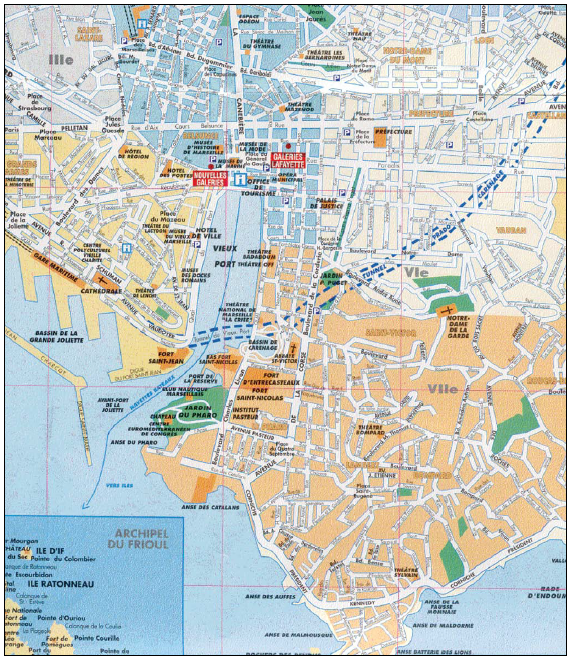
Lay of the Land
Third-largest city in France, about the size of San Francisco. Oldest city in France, founded by the Greeks in 600 BC as a trading post in Gaul. A quarter of Marseille's population is Muslim, largely North African immigrants. The north party of the city leans industrial or Muslim, the south leans commercial or French, but there's plenty of overlap between the two.
Gateways
The main route into Marseille is the Gare Saint-Charles train station, linking to Paris in three hours - this is the most likely entrance for vampires, symbolically, since they originate from deeper in Europe. Strangers and other influences come from across the sea - a ferry connects Marseille to Corsica, Sardinia, Algeria and Tunisia through the Gare Maritime. The original port is now for fishing traffic and tourists, the new post-war port expanded north into a modern shipyard and container port.
Markets
The tourist crowds are the Old Port are cover for agents and food for vampires. The nightclubs attract predators and pray, German techno and Moroccan rai flodding the streets at night. The city shops at the Centre Bourse, or on the less high-class Canebière ("Hemp Street"), although in recent times the hemp traffic has moved out to Clos le Rose, where hashis and cannabis gangs engage in turf wars. Everything else is sold in the Cours Julien street market. Information can be found at gang watering hole La Mistral, neutral tur ffor Corsican and Italian mafia.
The Vampires
The guy running things in Marseille is a Linea Dracula vampire named Radu the Bloody. His main muscle is the Dagestany Bratva, mostly Russians from the Caucasian enclave of Dagestan. His consigliere Enzo Corvino is loyal to John Dracula's line, his bookkeeper Shimon Kurusets is loyal to Vlad's line, Radu charts an uneven course between the two factions. Mafiya warehouses in the city store feral vampires. Radu's four brigadiers, all Renfields, run his criminal operations for him. Kurusets controls the local Georgian mafiya, run by Tanel Onyani, handling human trafficking and heroin trade.
Radu's plan is to kill or take over the Marseille underworld power structure. Turn troublesome outsiders over to French law enforcers he controls to build credibility. Then, direct Dracula capital into unions and port facilities, until he controls the main port between Europe and the Mediterranean. In the meantime, he has to keep Vlad and John off his neck, while Corvina and Kurusets constantly plot to destroy each other's networks. A war is brewing.
The Lamia
In ancient times, a Persephone cult thrived in Marseille. When the Catholics took over, Persephone became St. Mary Magdalene. Marseille's oldest church, the Basilica of St. Victor, venerates the mysterious Black Madonna on Candlemas. All of these are actually touching on the same ancient Lamia living in Marseille - the North Africans call her Aisha Qandesha.
Aisha took root in La Panier, north of the Old Port. Napoleon's General Jean-Baptiste Kléber was assassinated in 1800, but Aisha resurrected him as her warden. Her other chief servitor is a Renfield archivist named Marco Sfalgi, who knows about every supernatural deal that goes down in the city. Aisha keeps him immortal as payment for his services.
What Aisha wants is to get Radu out of Marseille, but also to restore Marseille to its former glory. Kléber wants power, Sfalgi just wants to be in the winning side.
The Spies
L’Entreprise des Travaux Ruraux ("Rural Work Enterprise"), a.k.a TR Group, is a secret French intelligence apparat that rounds up agents of both Britain and Germany, as well as Communists and Resistance fighters. During World War II, TR Group worked with Nazis for their own purposes. After the war, TR Group worked with the terrorist OAS until the de Gaulle coup in 1958. During the Cold War, it cultivated allies on all sides, including Italy's P2 Lodge of Masonic conspirators. P2's man in marseille is Lorca Vitale, who attempted to take over the city through the Camorra and Genoese mafia in the 90s.The Italians were knocked out by the Russians and French, and now Vitale relies on TR Group support.
The TR Group wants to learn more about occult secrets, and use those connections to gain power in France, and also in wider Europe and North Africa.
The Terrorists
Al-Quaeda in the Islamic Maghreb (AQIM) thought this was going to be an easy one - the city almost voted in the xenophobic and quasi-facist Front Nationale, and the Muslim immigrants are poorer and more radicalized than the rest of the population. But Marseille is a bomb that refuses to explode - it had no rioting outbreak in 2005, the Gaullist mayor remains committed to pro-immigration policies, and the Muslim leaders denounced the burning of the Or Aviv synagogue in 2002. On the other hand, the hashish flow will fund al-Quaeda operations in France once AQIM takes it away from the Georgian mob.
AQIM's goal is to carry out spectacular of terror and awaken a jihad in France. More immediately, their sights are set on the hashish trade, which will open up financing and new recruiting streams.
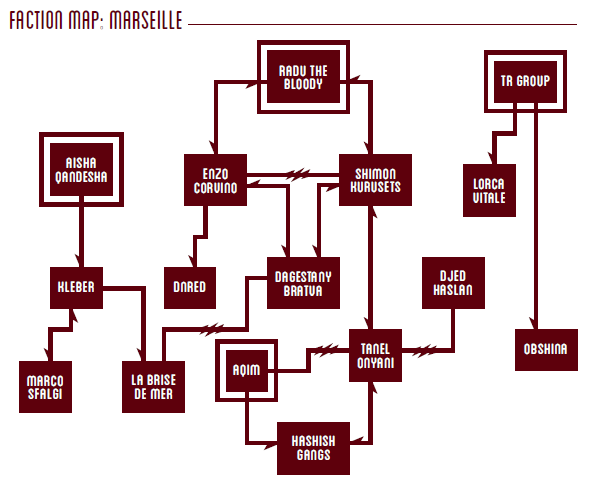
Seeds
-
Poet
Arthur Rimbaud
was unstable, brilliantly creative from a young age, neglected his family, and died early from an unknown disease. He gave up poetry to move to Ethiopia and run guns, then died in Marseille in 1891. Was he involved with Lamia? Was he seeking a cure for their attention in Ethiopia in the form of the Ark of the Covenant?
-
16th-century Marseille is where we got modern Tarot. Legendary Marseille ganster Jacke "The Fool" Imbert was shot 22 times and survived in 1977 on Candlemas, then rose to become Marseille's godfather until his 2004 arrest.
-
René d’Anjou, 15th-century Count of Provence, may have been chief of the Prieuré de Sion. How is Marseille connected to the Holy Grail?
-
Chateau d'If, the prison that fictionally held the Count of Monte Cristo and factually held centuries of political prisoners, is a kilometer off the Marseille shoreline.
-
Kléber was only one of many mummies hiding in the Basilica of St. Victor crypts. As recently of the 17th century, women and female animals were barred from the crypt for fear of being blinded by it.
-
Marseille's Musée d’Archéologie Méditerranéenne includes many Egyptian mummies, a mummified crocodile, and a mysterious Celto-Ligurian idol depicting a two-faced god.
-
The French national anthem, "Lar Marseillaise", includes a verse calling for struggle against
sang impur
- "impure blood."
-
October 9, 1934: Macedonian terrorist Vlado Chernozemski assassinates King Alexander I of Yugoslavia in his motorcade in Marseille. The first assassination ever captured on film - but then again, vampires don't appear on camera, do they?
-
The Great Plague of 1720 killed 100,000 people in Marseille and the surrounding countryside. Herald of the arrival of a pestilent vampire?
Next: GM Section.
STORIES, PART 1
Original SA post
STORIES, PART 1
NBA is a vampire spy thriller. We've covered spies, and we've covered vampires, so now it's time to cover the thriller part!
The Thriller in Play
A thriller is, broadly and not always accurately, a mystery in which the reader always knows the answer. Puzzles and hidden villains can help, sure, but they're not necessary to make it work. The backbone of a thriller is a series of increasingly exciting intellectual or explosive challenges.
In Night's Black Agents, you have two main ways of framing operations. Mystery:
-
Which of the delegates to the trade conference is a vampire?
-
Who is behind the assassination?
-
How are the stolen paintings being moved out of Italy?
-
What does the Tverskaya Bratva want in Lyon's hospitals?
And Thriller:
-
Kill the vampire at the trade conference.
-
An assassin is stalking your allies.
-
If you steal these paintings first, the vampires can't.
-
Bust up the Tverskaya Bratva apparat in Lyon.
However you want to do it, the key insight for telling thriller stories is this:
quote:
In the thriller, the reward for danger is information; having information points you into danger. When the hero rests, add more danger.
Rhythm and Improvisation
The above cycle is the heartbeat of NBA. Unlike most GUMSHOE games, action doesn't proceed from clue scene to clue scene - enemy action can throw you off the rails into action sequences, and even when it doesn't, the flow is more often several independent smaller investigations, targeted against different enemy forces, followed by action taken to deal with those forces using the information you just got.
Running NBA is a matter of careful balancing of pacing. If players get access to information you were counting on them getting later, they can leapfrog over entire scenes. If they do this, let them - if you haven't planned far ahead enough to keep things moving, interrupt them with a fight scene or other diversion. Have several scenes in mind, don't get hung up on the order they come in.
Awakening the Players
Sometimes a party will get paralyzed, either when there's too many available choices, or when there aren't any risk-free choices. Let the discussion continue as long as they're having fun, but if the group seems frustrated, guide them gently towards wrapping things up. Don't push towards one specific choice, but help them eliminate some. Use their high ability pools, Drives, and MOS to guide them towards something they're good at. Remind them that the only way forwards in spy work is gathering intel. Offer them a Surveillance or Interpersonal scene, and drop some intel in their lap that points them in a direction they're well equipped to follow up on.
Reward intelligent play extravagantly. Don't punish players for jumping ahead, don't punish them for failing to plan out every facet of an operation in painstaking detail. Encourage them to leave open space in their plans for Preparedness stunts. Do everything you can to keep things moving fast. Once the agents have a hypothesis, get them out there to test it. All of this is most important early in the game, when the players haven't yet internalized the game's logic.
Operations on the Fly
It's entirely possible to run NBA games with no operational planning at all. Keep in mind who the vampires are, what they're up to, and why. Whenever the agents go sniffing around somewhere, let them stumble upon part of the backstory. Instead of anticipating player action, just wait for them to act, and build your scenes about whatever they do.
The next few pages
There's a whole page in here that boils down to "be flexible," it's good advice but you've heard it all before. Keep notes, plan a few sessions ahead, don't fall in love with your plans and be ready to throw them out if necessary, if the players want to do cool shit, let them. Know when to lead the players and when to follow them.
The Operation
An Operation is the main dividing unit of agent activity - there's an objective, the party figures out how to do it, the party does it, the situation changes. There are two main parts to it - the Spine, a barebones list of the minimum elements that the operation needs to be a finished story, and the Skeleton, the surrounding pile of scenes and challenges that turn the Spine into a full adventure. Spine is story, Skeleton is gameplay.
Core Clues
Most (not all - this is a thriller, so there's diversions) scenes have at least one crucial piece of info that points towards some truth of the opposition plot, a Core Clue. Don't set these up so they can only be acquired in one specific order if you can avoid it, because your players are always going to circumvent it. The Spine outlines one way to get through the operation, but it shouldn't be the only way.
Core Clues should always be available not only from using the planned investigative ability, but also to players who come up with other clever ways of getting them. If the players skip a scene, try to find ways to insert any important Core Clues from that scene into later scenes. Try drawing out the operation as scenes connected by arrows - the arrows are clues, and a good adventure has multiple arrows from and to each scene.
Leveraged Clues
Sidebar! This is a special kind of two-part clue, where information is used to make an interrogation subject crack. First, the agents need to gather a clue. Second, the agents get someone connected to it, and use an Interpersonal ability to extract info from them. Since they have the clue, they can mention it to the subject, and unlock new information. Basically how most investigations work in the Ace Attorney games.
Floating Core Clues
These things are a tool to control pacing of the adventure. Basically, you have two (or more) clusters of scenes, one for early game and another for mid/late game. Then, you come up with one clue that will lead the agents to the second cluster of scenes, but you don't tie it to any specific scene. Whenever you feel like the party is ready to move on to the next stage of the adventure, you insert the floating clue into the next scene, and then they can move on regardless of how many scenes are left.
Floating clues are a way to act as an editor, more or less. If the team is breezing through scenes and having fun, leave it until the end of the cluster. If the team is getting bogged down and the players are getting frustrated, throw it in early and keep the game moving.
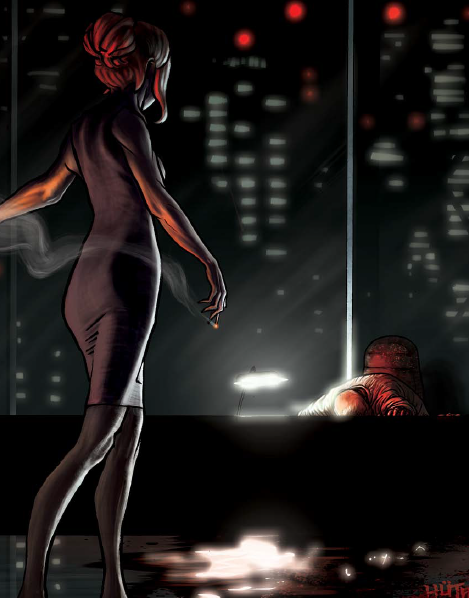
The Thriller Skeleton
This section outlines a general structure for most thriller stories. By no means hard and fast rules, but it's a handy way to help you plan out a new game. It goes: Hook, Curtain, Wakeup, Stall, First Reveal, Blowback, Twist, Relief, Final Reveal, Setup, Confrontation.
The Hook
A problem occurs that kicks off the adventure. Start of the story. Use a Backdrop, a fight scene is encouraged.
-
The agents follow up a clue from a previous operation and insert themselves into an ongoing situation.
-
The agents proceed to investigate the next item on their adversary map.
-
The agents receive or develop a piece of intel that indicates vampire activity.
-
The vampires threaten an asset of the agents, or make some other move that draws their attention.
The Curtain
The agents investigate the enemy, but encounter a veil of innocence. The opposition begins to push back. Put an infiltration or chase here.
-
The agents pick a side and begin pushing.
-
The agents cast a broader net looking for connections.
-
Their suspect asks them for help against the vampires.
-
The agents infiltrate the suspect organization.
-
The authorities notice weird goings-on and start interfering.
The Wakeup
The first moment of supernatural horror - either a vampire attack, or the aftermath of one. If you haven't done a fight scene yet, here's the spot for it.
-
The situation escalates bloodily.
-
The agents discover something horrible.
-
The agents’ source turns up dead, turned, or otherwise informatively creepy.
-
The infiltrated agent discovers something horrible and must be exfiltrated while keeping her cover intact.
-
The vampires attack.
The Stall
Optional scene - a line of inquiry goes cold. Only throw this in if the agents have multiple open lines of investigation.
-
Political pressure clamps down on the conflict.
-
The subject of the agents' investigation disappears or turns up dead.
-
The agents' informant disappears or turns up dead.
-
The infiltrated agent harvests nothing but "chicken feed" and "chaff."
-
The vampires roll up their operation and pull out of the city.
The First Reveal
The agents learn the nature of the true opposition. Follows from Wakeup, good spot for investigative scenes or surveillance.
-
The escalated situation makes someone nervous, who makes a mistake or seeks out the agents to switch sides.
-
The horrible sight links to another event, perhaps in another city; the agents investigate it.
-
The agents dig into their source's background or recent movements.
-
The infiltrated agent develops her sources.
-
Analyzing the vampire attack indicates something about the vampires.
The Blowback
Floating element, can happen multiple times. The bad guys hit back, reacting to the investigation with direct action against the agents.
-
The other side threatens or kidnaps someone the agents care about.
-
The investigation leads to an attack or assassination attempt.
-
The other side informs on the agents to the authorities.
-
Something from the Vampyramid.
-
Thriller chase; the agents are running from the vampires or the authorities.
The Twist
Further investigation turns an assumption on its head. Turn the chessboard around, lose some red herrings, the game starts moving towards the climax.
-
The agents switch sides, or start pressuring their erstwhile allies into riskier moves; setting up a possible Yojimbo option.
-
The scope expands: the vampire conspiracy goes deeper in time, or wider in space, than the agents understood.
-
Someone they now suspect has previously made contact with the agents’ allies.
-
The agents start developing a strike on the vampires based on this new revelation.
-
The vampire asset within the authorities reveals his existence.
The Relief
Something good happens for once. The agents uncover the key to victory, or get help from the outside.
-
The agents break into their increasingly distracted and overstretched enemy's headquarters and dig up intel on their channel to the vampires.
-
Another enemy of the vampires offers to help the agents with intel or muscle.
-
A Network contact fills the agents in on a key piece of their old agency's history; a flipped asset begins cooperating.
-
The vampires overplay their hand, possibly killing someone the agents had wrongly fixed on.
-
The agents can hack into the authorities' database now that they know who they’re looking for dirt on.
The Final Reveal
The agents finally know everything that's going on. It's worse than they thought, and it's probably about to get even worse.
-
Both sides of the situation had vampiric influence.
-
The vampires prove to have some horrible defense, or an extra monster or ability previously unsuspected; the agents escape from this fight with their lives, barely.
-
The evidence for the Final Reveal comes from three or four separate assets, interrogated, sweated, bribed, or coerced during the scenario.
-
If nothing from the Vampyramid has happened yet, something from the Vampyramid happens.
-
The infiltrated agent shows signs of vampire contamination (
Mirror
).
-
The authorities are hot on the agents' trail; the agents need to keep moving while planning their counterstrike.
The Setup
Optional - the agents do what they have to do to get ready for the final battle. If this happens, it's probably the players' idea, not yours.
-
The agents have to socially engineer a final bloody showdown.
-
The agents scramble to accumulate enough mistletoe, Dragon's Breath rounds, or other arcane gear to blow through the new defense.
-
The agents case, drill, and otherwise plan an assault on the vampires' base.
-
The infiltrated agent sets in motion her plan to disrupt the opposition.
-
The agents flip one of the vampires key assets in the police force.
The Confrontation
All in, guns blazing, against the forces of evil. The end of it should point to at least two possible next operations.
-
Final bloody showdown turns into vampiric ambush.
-
The vampires pull out their horrible defense before it can be trapped and destroyed; the agents are left in possession of the field.
-
Major assault on the vampire base, possibly attracting more official attention in the form of cop cars and Heat.
-
The agents ambush a vampire asset, planning a snatch-and-grab followed by holy-waterboarding.
-
The vampires try to extract their agent from the police headquarters; the agents stop the attempt.
Next: Active and Reacive Operations, another pyramid.
STORIES, PART 2
Original SA post
STORIES, PART 2
Active Operations
There are two kinds of operations: Active and Reactive. In Active ops, the agents have knowledge about the vampire conspiracy, and take action to thwart it.
Leads for an Active Operation are generally of the form of "something is going on here, and you have to stop it". What is the conspiracy doing in this city? What are the side effects? Who wants it stopped? Once they know where the problem is, the rest is up to them.
There are nine basic kinds of active missions:
-
Destroy: Physically, mentally, morally or socially annihilate the target.
-
Flip: Convert an enemy asset to the agent side. Give them a conspiracy handler who needs to be taken out of the picture.
-
Heist: Provide target, provide security, provide someone else who also wants the thing.
-
Hit: Somebody has to die. Provide target and security, provide a weakness in one or both.
-
Hunt: Find somebody - a potential ally or a vampire conspirator. Who else is hunting the target?
-
Rescue: Get somebody away from the conspiracy. Like Heist, but the target is a person.
-
Sneak: Get into a place, to get intel, plant bugs, or set up a Heist or Flip. Could be physical or social infiltration. Or both.
-
Trace: Find something that's been missing for a long time. Set up a trail of clues by working backwards from its location.
-
Uncover: Solve a mystery - what the conspiracy is up to, who killed the asset, which company is in league with vampires. Pure GUMSHOE territory.
Reactive Operations
In the other kind of operation, the ball is in the Director's court - the vampires take action, the agents react. Leads are similar to Active Operations - when the vampires do something dramatic, it sends ripples through the city, which the agents can pick up on.
Reactive Missions have similar mission types, but in reverse. Some examples:
-
Counter-Destroy: Vampires plan to destroy the local human trafficking network and replace it with their own. The agents can either stop them and destroy the network themselves, or stop them and have some unsavory types owe them favors.
-
Counter-Flip: Vampires are trying to flip the prefect of police. Agents need to stop them, kill him after he flips, or re-flip him as a double agent.
-
Counter-Heist: Vampires want to steal an idol of Zalmoxis from a museum to channel its eldritch powers. The agenst must destroy it, heist it first, or use it as bait.
-
Counter-Hit: The vampires want to kill the archbishop to protect thier secrets. The agents need to keep him alive.
-
Counter-Hunt: The vampires are hunting someone who escaped with a flash drive full of secrets. The agents might want to get to the flash drive first, or might want to rescue and flip the guy carrying it.
-
Counter-Rescue: Vampires planning to rescue a Renfield from a prison facility. The agents hit them either on the way in or the way out.
-
Counter-Sneak: Vampires want to sneak a lamia into the Davos summit. Agents need to disrupt the sneak without blowing their own cover, or flip an asset at the summit, or sneak in their own agent.
-
Counter-Trace: The vampires are tracing a shipment of precursors for an advanced vampire serum. The agents want to find it first, eliminate the conspiracy investigators, or muddy the trail until it can't be found.
-
Counter-Uncover: Rare. Maybe the vampires want to bring Heat against the agents, maybe they want to expose unsavory MI6 work as a diversion.
So, you've heard of the Conspyramid, now get ready for...
The Vampyramid
The Conspyramid was a table of how a conspiracy is shaped. The Vampyramid is different - it outlines how the conspiracy responds to threats. The enemy starts with the lower levels, and the more chaos the agents cause, the higher up it goes.
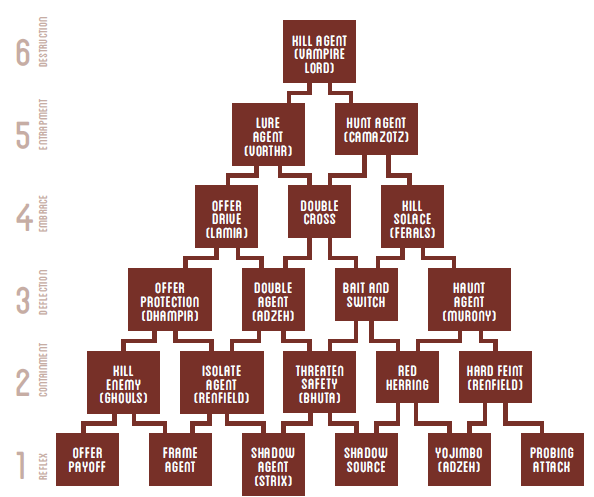
Each line upwards is a logical escalation from the box below to the box above. We've got six rows of enemy action:
Row One: Reflex
-
Offer Payoff: An apparently-unconnected node offers a handsome payoff to just walk away. In a
Burn
game, they may hint that the enemy knows about one of their sources of stability.
-
Frame Agent: An agent is framed for a crime, raising Heat. They may offer to reduce Heat if the agent walks away.
-
Shadow Agent: Enemies try to follow the agent and learn their patterns. Vampires can use animal familiars for this, making it harder to detect.
-
Shadow Source: The conspiracy visibly stalks a Source of Stability for the agent. May drain points from a contact's pool.
-
Yojimbo: The conspiracy sends an unaffiliated attacker after the agent - a contract killer, a gang working on a bad tipoff, a possessed secret policeman. Goal isn't necessarily to kill - they want to see how the agents fight, and get them entangled with other forces.
-
Probing Attack: Street-level soldiers ambush the target. Same general objectives as Yojimbo.
Row Two: Containment
-
Kill an enemy of the agents. Could be a murderous bribe, a frame job, or a way to stir up vendettas between groups.
-
Isolate Agent: The conspiracy kills of members of the agent's network until they refuse to risk any others, or otherwise separates them from their assets. If the man running the isolation mission is taken out, the attack stops.
-
Threaten Safety: Either a raid of a place of safety or a subtle threat on a place of safety (such as buying the neighboring property).
-
Red Herring: Plant evidence leading to someone else as the mastermind. If the agents fall for the plant, it should lead them to clues pointing back towards the real conspiracy, but give the vampires time to take more nefarious action.
-
Hard Feint: Strike at the agents to provoke a response, potentially raising Heat, while the conspiracy takes action elsewhere.
Row Three: Deflection
-
Offer Protection: Offer to reduce an agent's Heat or stop attacking them.
-
Double Agent: Plant an asset in the agent's inner circle, someone who has a lot of conspiracy intel to share but is reporting the agent's activity back to the vampires.
-
Bait and Switch: Leave a trail of false intel, pushing the agents to overextend themselves on a wild goose chase. Possibly combine with an ambush or false arrest.
-
Haunt Agent: Use all available supernatural tricks to drive the agent to retirement or insanity.
Row Four: Embrace
-
Offer Drive: Offer to fulfill an agent's Drive to flip them. In a
Mirror
game, even refusal might net nice rewards for the agent, just to make their teammates doubt their loyalties.
-
Double Cross: Pop the double agent from row three to betray the agents.
-
Kill Solace: Find an agent's Solace and eliminate them. Preferable in front of the agent.
Row Five: Entrapment
-
Lure Agent: Expose a valuable target, and load it up with muscle. A risky move, but the vampires are desperate by row five.
-
Hunt Agent: Hunt down the agents. Kill them, drain them, turn them. Hit when Heat is high and resources are low.
Row Six: Destruction
-
Kill Agent: Right before the agents are planning their final attack, hit them with everything at the vampires' disposal. All or nothing.
The Campaign Story
While there are lots of stories to tell in this game, there's a general assumed default campaign structure: Agents uncover vampires. Agents hunt vampires. Vampires hunt agents. Agents destroy vampires.
In broad strokes, a campaign is split into three arcs:
Opening
Players are learning the ropes of the game, making their first adversary maps, getting comfortable in their roles. Be nice to them, remind them about tag-team benefits and MOS. However much you hold their hands, though, have one harrowing scene to amp up the terror of the vampire enemy.
Begin with an introductory operation where the players learn that vampires are real. Make it clear that the agents are dead if they don't figure out what's going on, and fast. Threat established, lasts through two levels of the Conspyramid, begin outlining the vampire rules of the setting.
Midgame
The players have started to internalize the game rules, and are more likely to take risks. You can let them go unsupervised more now, and they'll start to surprise you. Throw in new elements now: Other supernatural forces, rival conspiracies, whatever works. Toss in one new element at the start of midgame and another at the end.
Get a higher-level villain into the mix, start making things personal. The enemy takes more direct action against the agents, action rises, operations get big. Whatever anti-vampire measures the agents have started to get used to, the vampires start to take their own countermeasures against. Runs through another two levels of the Conspyramid, personal arcs are now fully intertwined with the campaign arc.
In Dust games, the agents should have a full network of contacts to call in for favors by now. In Burn games, Stability should be starting to fray by now. In Mirror games, have at least one major NPC betrayal before midgame ends.
Endgame
Eventually, the agents will start resolving to wipe out the conspiracy once and for all. Dangle a chance to end everything in front of them, but only at great risk. Often, endgame starts around when the villain from midgame is taken out.
Every operation starting now should have a looming sense of doom around it - the conspiracy is everywhere, vampire attacks are constant. In Burn games, contacts are dying or running for the hills. In Mirror games, your allies are selling you out to save themselves.
If the agents don't quite have enough intel, this is a time for a turncoat from Conspyramid level 5. Keep tension high. Plot a big, high-action final adventure, leave a trail of clues leading to it, let the dominoes fall.
Next: Three alternate play styles.
STORIES, PART 3
Original SA post
STORIES, PART 3
Let's talk three alternate modes for NBA.
Martini, Straight Up
Maybe you don't like vampires or the supernatural! Maybe you want less Buffy and more James Bond. This mode has you covered!
Investigative Ability Changes
Instead of ridiculous vampire-slaying super-agents, the party is now spies, specializing in information gathering. Instead of rogue agents, you work for a government intelligence agency.
The abilities Art History, Astronomy, Chemistry, Diagnosis and Foresnic Pathology are no longer available - to do those things, you'll need to use Network to recruit an expert, or Interpersonal abilities to schmooze one. Occult Studies and Vampirology are gone. Several other abilities get absorbed into other abilities. Archaeology now falls under History, Human Terrain, or Urban Survival. Architecture now falls under Urban Survival. Flirting falls under Flattery, Photography falls under Electronic Surveillance and Data Recovery.
Since the ability pool just shrunk, Build points are reduced accordingly - 16 for 5+ players, 25 for 2 players.
Bureaucracy
This ability existed as an investigative ability in vanilla NBA, but now it's a General ability. In addition to its other uses, you use Bureaucracy to try and get your agency to do things for you - authorize rescue of a captured asset, lower Heat, retask satellites, release classified files. You have powerful allies, but making them do you favors isn't easy.
Something you have clearance for is Difficulty 3. If you have to pull strings to get it done, Difficulty 5. Something you have no business asking for, Difficulty 7. +1 difficulty for working across agencies, +2 for requesting things from other governments. At that point, you're probably better off using Network to build contacts within those agencies.
In Burn games, success by a margin of 0-1 means that to get your favor, you have to do a favor, and it won't be something you like. In Dust games, all Bureaucracy difficulties are 1 higher. In Mirror games, the agency tracks Trust with each agent, and can spend that Trust to harm the agents if it double-crosses them.
Bureaucracy of 8+ grants the cherry Friends Upstairs . This gives anyone trying to use Bureaucracy to hurt you +1 to their roll Difficulties - it's the bureaucratic equivalent of Hard to Hit.
The Dunwich Sanction
Vampires are no longer the bad guys - now you're up against the fraying edges of reality itself. That's right, it's Cthulhu time!
This mode is a crossover between Night's Black Agents and another GUMSHOE game, Trail of Cthulhu . It can be set up a few ways - maybe you're part of a large, ignorant government agency, maybe you're part of a small conspiracy that knows The Truth. Maybe it's more like vanilla NBA, where you're burned operatives who uncover horrible knowledge.
ToC's sanity rules are added to the game, along with new abilities - Cthulhu Mythos, Frince Science, Geology, Physica, Theology. If the agents are members of a government agency that combats the eldritch gods, combine with the above Bureaucracy rules for Martini, Straight Up. The rules of the game are still generally NBA, not ToC, and vampires might even still exist - but if they do, they're servitors of Mordiggian, Nyarlathotep, Hastur, or one of their friends.
Special Assets
Inspired by the Necroscope book series, which pits psychics against Soviet-bloc vampires. This game mode gives the agents a new weapon in the war against vampires - psychic powers. Agents could be a member of an official government black program, or it could be a rogue, independent operation.
The new paranormal powers are General abilities, and are built as normal, with the exception that the first point in each one costs 5 build points. Paranormal abilities are used as normal, but every time you use them, you must spend at least 2 points on the usage. If you don't have enough points left, you can spend from Stability, but those points don't add to the roll. Paranormal abilities can't be used in combat. After using a paranormal ability, make a Difficulty 5 Health test. If you fail, you lose 2 Health and become Hurt for the rest of the scene.
Necrophony
The ability to speak with the dead. Conversation lasts until the end of the scene or until the medium uses any other ability.
Base difficulty for any Necrophony check is 8, or higher if the entity isn't willing to communicate. However, lots of things can tilt the tables in your favor; -1 at night, -2 in a formal seance, -3 if you have their physical remains, -4 if any spirit will do instead of a specific individual.
If instead of just talking to the spirit, the medium is possessed by the spirit, other agents can use Interpersonal skills on it. Depending on the nature of the communication, a further Necrophony test must be made to break the contact. Vampires may be able to sense usage of this power, or resist if the deceased was one of their minions.
Remote Viewing
Militarized clairvoyance, the ability to see unknown things at a distance. You can use RV to see inside a locked building or sealed vault, but you need the coordinates.
The more specific the coordinates, the better the image. An RV session takes up to six hours. Difficutly is based not on distance, but on how much information you're trying to get. There are six stages of remote viewing:
-
Stage 1: Perception of general nature of site. Difficulty 4.
-
Stage 2: Basic sense perception - taste, temperature, sound, color. Difficulty 6.
-
Stage 3: Dimensional perception - height, length, angle, curvature. Difficulty 8.
-
Stage 4: Complex and abstract information - Checmical composition, dollar value, mechanical intentions. Difficulty 10.
-
Stage 5: Interrogation - Director answers any one questiona bout the target for 1 point of RV. Difficulty 12.
-
Stage 6: Full 3D imaging - agent could draw or render the site in detail. Two questions for 1 RV point. Difficulty 15.
Other Powers
The above two are all that the NBA book lists, but there's a lot of other GUMSHOE products with powers that can be lifted. Sci-fi game Ashen Stars offers Dreamsight and Pathway Amplification. Psychological horror game Fear Itself offers Aura Sight and Premonitions. Gritty supers game Mutant City Blues offers Memory Alteration and Psionic Blast. Trail of Cthulhi offers Hypnosis and Idosyncratic Magic. The list goes on, but they should all be tweaked to use this paranormal power system.
Next: Sample adventure!
(S)ENTRIES, PART 1
Original SA post
(S)ENTRIES, PART 1
We've reached the end of the book, so it's time for a sample operation! If you might play this game later, and your GM seems inclined to use sample scenarios, maybe skip the next couple updates.
Eyes Only Briefing
A quick summary of the operation, intended for the Director. In this case:
-
Canadian Air Force general Malcom Lennart found out about vampires.
-
A conspiracy paymaster sends Georg Rudek to hire the party to steal his laptop, and Anton Dedopovic to pay off the party and secure the laptop for the vampires.
-
Anton Dedopovic has a worsening kidney disease and has found out about the vampiric nature of the conspiracy. He's planning to double-cross the vampires, take the laptop for himself, and trade it for vampiric immortality.
-
The agents track either Anton or the paymaster to Belgrade.
-
The paymaster may be Belgrade gang boss Danilo Brigovic, or someone higher up.
The Spine
The basic flow of the operation goes like this: The agents meet Rudek in Dubrovnik, Croatia, where he answers some questions and getse them into Bosnia. There, they heist the laptop from SATO HQ in Sarajevo, then escape into the Serbian Zone. Anton meets up with them, and drives to his Double Cross at the cemetery in Gostilj. Regardless of Anton's fate , the agents turn up additional clues when policing the scene . They either track the paymaster or track Anton , the trail leads to Belgrade and a Payoff .
The Job
The opening hook is Rudek offering the job. He's a fixer well known to and trusted by at least one of the agents, althuogh he has a shady background in Balkcan intelligence.
Meeting Rudek
Rudek meets the party in a chain hotel room in Dubrovnik, Croatia, wiring necessary funds to the agents in advance. If they're suspicious, they can arrive early and scout, but the situation isn't very sinister.
Rudek lays out the objective, starting with a photo of Lennart, which Military Science recognizes as a Canadian Air Force general. Rudek suspects that he's been looking into purchasing records or shifty political deals, but is holding the evidence close to him. The laptop never leaves his side. Objective: Secure the laptop, ensure no backup exists for it (this is obviously because the vampires are doing a cover-up, but what's Rudek's justification for this objective?). Reward: 100,000 euros, half now and half on delivery.
Once the party secures the laptop, they're to rendezvous with Anton Dedopovic on the Serbian side of the partition line. Rudek gives them a flash drive with a basic dossier on Lennart, satellite photos of Camp Butmir, GPS coordinates for the Dedopovic rendezvous, and a Belgrade phone number to call when the job is done. If the agents agree, Rudek eletronically transfers funds to whatever account they specify - a 1-point Accounting spend or 2-point Criminology spend recognizes the bank as owned by the Russian mafiya.
Asking Questions
The players will probably want more info than that. Either Rudek provides it freely, or they'll have to dig it up on their own. Some topics:
Brigadier-General Lennart
Military Science will yield Lennart's background - if not available, spends of Bureaucracy, Network, or Digital Intrusion (Difficulty 5) will also work. Lennart is a logistics expert in and liason with the USAF. The only red flag in his file is a sudden transfer to Sarajevo before he finished his NATO tour in Naples. It might have been to stymie an investigation in Europe, or it might have been something he did to get access to records of Bosnia and Kosovo missions. Which it was is up to the Director and the further conspiracies of the campaign.
File doesn't indicate specialized computer training, so it's unlikely that there are any hidden backups of his data online (Investigative use of Digital Intrusion will yield this, plus the fact that hiding backups online would be an even bigger security breach than taking his laptop home every night). No obvious hooks to pressure Lennart are found - he doesn't drink, he has a modest retirement plan, he votes Liberal, and his long-term girlfriend in Alberta is similarly clean.
Anton Dedopovic
Anton is an asshole. He's a killer and rapist working for the Serbian mafia. His main interests are human trafficking and heroin, but he's useful as a cut-out for operators in former Yugoslavia. Tradecraft and Streetwise get all this info, but for a 1-point spend of Tradecraft or Criminology, you can find out that he's been spotted in Switzerland several times, and rumor is that he's trying to set up a heroin ring there through a private hospital. The truth is that he's trying to find a cure for his disease.
The Rendezvous
Rudek's GPS coordinates lead to an Orthodox cemetary east of Gostilij. If the agents want to scout it out, Rudek would warn that they lose two days and risk running into a roadblock. Tradecraft tells that entering the Serbian zone is likely to alert Dedopovic. If they insist on it regardless, give them a roadblock that they can spend Military Science, Intimidation or Cover to get past, but doing so will absolutely report them to Dedopovic.
Dedopovic's sniper Vladek is staking out the cemetery, but he has orders to not make contact with the agents. Noticing him is a Difficulty 6 Surveillance test, catching him is a Surveillance contest.
The Lift
One way or another, the party eventually heads to Sarajevo. Rudek arranged rooms at a hotel, but the agents can also use Network (Difficulty 4) to get a safe house in the area. Time to steal a laptop.
Heisting the Laptop
This should be pretty easy, not actually being the heart of the operation. It's fine if it turns out a bit anti-climactic.
The Target
Lennart lives in the Sarajevo suburb of Ilidza, and has one local woman who cooks and cleans for him. She doesn't live on the premises, but comes in while he's out. Security is good but not amazing - Difficulty 4 Infiltration, failure notifying both the NATO base and the police. His office is in Camp Butmir, which has a constant presence of uniformed personnel from a dozen different nations at all times. Getting on the base isn't hard - 1-point Forgery or Difficulty 3 Cover will get you credentials, Difficulty 4 Disguise or 2-point Military Science or Intimidation will also get you in.
Lennart's office is watched by his adjutant, Captain Sebring, who knows exactly who is or isn't supposed to be in the office. Lennart keeps his laptop secured in the office during work hours, and then takes it with him when he goes home.
Lennart's Schedule
-
0600
: Wake up, exercise, shower.
-
0645
: Staff car arives to pick him up.
-
0700
: Arrives at office at Camp Butmir.
-
1100
: Lunch brought to his office. Lennart generally works alone, attending meetings or briefings as briefly and sparsely as possible.
-
1800
: Staff car arrives to take Lennart home.
-
1830
: Stops for dinner at a restaurant or arrives home.
-
2000
: Arrives at home from restaurant, works or reads.
-
2300
: Lights out.
The Boost
The players will come up with a plan to secure the laptop. Let it work. In playtest, agents bugged the office with Infiltration and Electronic Surveillance, identified the laptop model with Data Recovery, bought the same model, duplicated Lennart's with Conceal, and made a switch during his final day on the base, so that he wouldn't notice the switch until he had already left the country. Alternate possibilities:
-
Steal or switch the laptop at night (Surveillance to avoid military and police security, Infiltration, Filch)
-
Steal or switch the laptop from the office while Lennart is out (Infiltration, Filch, Military Science, Disguise, Cover)
-
Hitting the staff car during transit and stealing the laptop directly (Driving, Hand-to-Hand, Disguise, Shooting or Explosive Devices)
-
Hack the laptop, download the files, then wipe the hard drive (Digital Intrusion, Infiltration, Electronic Surveillance)
-
Poisoning Sebring and pretending to be Lennart's temporary adjutant (Pharmacy, Infiltration, Filch, Disguise, Military Science)
-
Poisoning Lennart, stealing the ambulance, and pretend to be EMTs (Pharmacy, Infiltration, Filch, Disguise, Diagnosis, Driving)
The Escape
If the agents go in hard, there will be a chase. Use Thriller Chase Rules as usual, crossing the border into the Serbian zone gives the agents a 2-point Driving refresh, as Sarajevo police have to request clearance for pursuit. If they went quiet, they can cross the border with ease, steal a car, and make it to the rendezvous, where everything will no doubt go as planned.
Next: Nothing goes as planned.
(S)ENTRIES, PART 2
Original SA post
(S)ENTRIES, PART 2
The Meet
So, your party now has the general's laptop. The meeting with Anton will happen at the cemetery - a spend of Research or Data Recovery will note that, in addition to the road approaching it from the north, there's a trail out to the back, leading along the mountain face towards the Serbian border.
A black Jeep is parked near a crossroads in the middle of the cemetery, headlights aimed down the north road. At least three figures are visible, two with assault rifles. Spoiler alert: Anton isn't planning on paying anybody.
The Double Cross
The players hand over the laptop, in exchange for a briefcase containing payment. Inside the briefcase is newspaper cut to look like packets of money. When they're busy with the briefcase, Vladek snipes the most threatening agent, the thugs riddle the others with bullets, and Anton goes rogue, trading the briefcase for his immortality.
Or at least, that's Anton's plan.
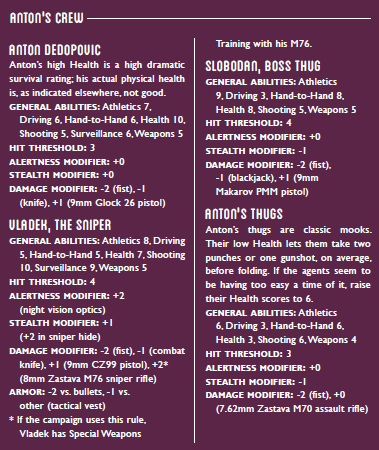
How it Goes Down
The agent riding shotgun gets a Difficulty 6 Sense Trouble test to spot Vladek's scope. If they fail, the ambush will surprise the party. If they turn and run, Vladek shoots out their tires (Hit Threshold 5 with sniping), and the ambush springs early. Slobodan and his thugs get in the jeep for a car chase, while Anton and Vladek head for the Serbian back roads. If an agent has split off to enter through the hills, it's Difficulty 4 Infiltration to sneak up from the east, or Difficulty 6 from the west (since they have to get past Vladek). Failing gets you shot at and springs the ambush early.
If the agents reach the crossroads without triggering a car chase or gunfight, they'll see Anton, Slobodan, and their goons - 1-point Diagnosis spend identifies Anton as an unhealthy man. Interpersonal skills note his fixation on the laptop (if it's visible) but nothing else. Anton and his men will try to recover the laptop at all costs; however, if all the thugs die or Vladek pulls out, he flees to his car (which has run-flat tires) to make his escape.
Tracking Vladek through the hills will be very hard. Sense Trouble Difficulty 5, or worse without night-vision equipment. It'll take him four rounds to escape the cemetery and seek cover in Gostilj.
The End?
How things go from here depends on several things, but the biggest factor is Anton's fate.
Anton is Dead
If the players killed Anton, they may be willing to just call it a day here. Proceed to "Policing the Scene" and show them something weird, or play to their Drives. Alternately, if they still have the laptop, they can investigate its contents, which will immediately alert the vampire conspiracy, marking them for death.
Anton is Alive, Agents have laptop
The agents can investigate laptop as bove, or hunt down the other half of their pay. Anton will invariably come after them with a bigger gang of shootier thugs, until the agents are seriously wondering what the hell is in this laptop. Investigation from here may uncover Anton's kidney disease (membranous glomerulonephritis), along with his vampire obsession.
Anton is Alive, Anton has Laptop
Either as above, or the agents let it go. If they do the latter, word gets around that some puffy-faced Serbian gunsel got the better of them, and Rudek swings back with word on Anton's whereabouts in Belgrade - it's bad for his business to let this kind of thing stand. In reality, the conspiracy's plan is to send the agents in to soften up Anton, then send in a vampire to kill all the survivors and reclaim the laptop for themseslves.
Policing the Scene
After the fight, agents have a while to check the graveyard for clues, if they're so inclined. There are three possible clues of weirdness afoot:
Wild Roses
If the Jeep is still around, it has a big pile of wild roses in the back, as does Anton's BMW. If the cars are both gone, Notice spots two wild rose branches in the road. Outdoor Survival identifies them as wild, not grafts or cultivars. Vampirology, or a 1-point spend of Occult Studies, reveals that wild roses laid across an opening prevent a vampire from using it.
If your campaign's vampires aren't blocked by wild roses, either swap them out for something else, or just use the roses anyway. Anton was misled.
Dying Words
Leave one thug alive enough to choke out some hints. Intimidation or Reassurance will both work - ravings leading to the trail are free, further ravings cost spends.
Possible ravings:
-
"Anton’s dying, but he says he’s gonna live forever."
-
"Trade it for eternal life, for the blood."
-
"Roses keep them away. Can’t cross."
-
"Eyes burning. Can’t look away. They’re the devil." (Substitute similarly outré and evocative raving tailored to your campaign’s vampires.)
Renfield Option
If you want to be really overt with your weird shit this early, throw in a Renfield - he could be watching from the hills to take the laptop when the timing is right, or he could be tied up in the mauloseum, surrounded by wild roses.
Whatever you do with a Renfield, the important thing is for him to do something overtly weird - using a combat power during a fight, or talking clearly despite a severed throat. He can throw in a final threat that alludes to the conspiracy's wider existence, if you want.
The Trail
The agents survived the double cross, and now it's time to hunt down whoever hired Anton and Rudek. After all, since Anton went rogue, this paymaster is the one who owes them their fee.
Tracking the Paymaster
The identity of the paymaster actually isn't specified in here - they're whoever you need them to be as a hook into the rest of your campaign. So, some of the details in this section are blurry. Still, there are several routes to track this guy:
Phone Number
The number Rudek gave them at the beginning doesn't show up on a normal search, but a Difficulty 5 Digital Intrusion test identifies it as the number of a Serbian bomb shelter. It's more or less perfectly secure, but Difficulty 7 Digital Intrusion will get all the phone numbers that called that number in the last month - Traffic Analysis on that data points to Danilo Brigovic of the Naša Stvar.
Physically locating the phone is just as hard. You can penetrate a Serbian police station (Difficulty 6 Infiltration or Difficulty 5 Disguise and a 1-point spend of Cop Talk). You can search the tunnels underneath Belgrade (Difficulty 4 Infiltration and 2-point Architecture spend), but there may be a pack of ghouls patrolling the tunnels. If you do find it, tapping it (Electronic Surveillance) leads to a Serbian police sergeant in Brigovic's pocket.
Bank Account
You can trace the funds you got through the Russian mafiya bank, but this is as hard as it is dangerous. Difficulty 6 Digital Intrusion points to a Vienna bank, another one points from there to a London shell corporation, and a third one points to an Isle of Man dummy company. That and a 2-point Accounting spend will point the agents to a Level 3 node in your Conspyramid. Any failure will bring down a Russian mob hit, along with vampiric forces.
Rudek
Rudek is hiding in Beirut, and by the time the agents find him, it's probably too late. When the conspiracy finds out about Lennart's laptop being stolen, the agents access any database indicated in Lennart's files, Anton tries to shake down the vampires for immortality, or the agents contact Rudek after the mission, the wheels start turning. 12 hours later, Rudek is killed.
A dead Rudek still provides clues. Notice might pick up ballistic or fiber evidence which Criminology could pin to a specific assassin. Occult Studies might find unnaturaly elements of the scene of the crime. Traffic Analysis might pull more leads off his phone or computer, or if his home was burned down, Data Recovery or Chemistry might restore his notes.
If things went just right, Rudek might still be alive by the time the agents reach him. What he knows or doesn't know depends on you - maybe he points them to a lower node on the Conspyramid, like Brigovic, or maybe he can point them straight to the paymaster. If the latter, the agents should have to earn that lead by fighting off the supernatural hit team that arrives to kill Rudek.
In a Mirror game, the vampires leave Rudek alive, and he points them towards the paymaster, but his lead is a death trap.
Naša Stvar
If the agents get pointed towards the Naša Stvar, it's just a matter of shooting their way up the food chain. Streetwise finds a Naša Stvar ring in Serbia or Montenegro, Intimidation works after a gunfight, and follow the chain - minimum one such scene to reach Brigovic, or two if he's the paymaster.
Danilo Brigovic is a mafioso in Belgrade, behind a cigarette smuggling business; a 1-point spend of Streetwise or Criminology fingers him as a person of interest in a number of missing person cases, 2 points in Criminology identifies him as a weapon smuggler protected by the Serbian government. He pays into the vampire conspiracy for protection or other services, probably hitting a level 3 node. He's either the money man who arranged Lennart's laptop theft, or he's an intermediary for someone higher. He could be a Renfield or dhampir, or a conspiracy node himself.
He probably commands some supernatural muscle, and is well armed even aside from that. If attacked at his villa or cigarette warehouse, all his thugs have night vision optics, body armor, tear gas, flash-bang grenades, and top-of-the-line guns. He might keep a pack of ghouls under his warehouse. He's most vulnerable on his barge, the Red Eagle (Belgrade has a number of barges that double as casinos, nightclubs or bars). There, his men only pack pistols or SMGs, and he can only be accompanied by a handful of goons. His vampiric muscle may not be able to cross running water to reach the boat, too... then again, it won't be easy to get back off of the barge through a ring of Serbian Gendarmerie patrol boats.
Rather than going in guns blazing, the agents could go quiet, present their claim, and warn Brigovic about Anton. If they do this, he'll pay the rest of their fee in cash, and get them on a plane out of Serbia (if they don't leave, he can bring Heat 5 on top of them). Once the agents have left, Brigovic informs the vampires where they went.
Tracking Anton
If the agents try to follow Anton, the trail begins with the Naša Stvar. Once they find him, following him to the paymaster is a matter of good tradecraft. Of course, this is only an option if he's still alive.
Difficulty 4 Surveillance to track Anton once he's been found, but he's recruited a new gang of thugs as muscle. He has contacts in Internal Affairs, so any police or Gendarmerie contact will warn Anton of the party's approach.
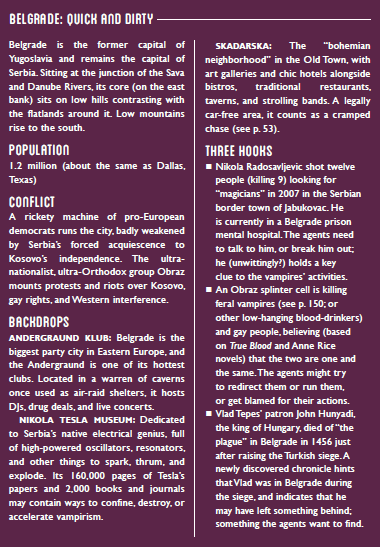
The Payoff
The agents finally find the paymaster. The obvious and dramatic reveal is that the paymaster is a vampire, a lamia, or something else supernatural and powerful. Or, they could be another Renfield or human, with connections leading deeper into the shadows.
Regardless of the paymaster's identity, they travel with a Renfield or two and a retinue of bodyguards. That, or they're a powerful vampire, confident in their ability to kill anything or anyone who crosses their path.
The Leads
After clashing with the paymaster, there's still Lennart's laptop - a perfect tool for providing leads to elsewhere in your campaign's structure. A 1-point spend of Traffic Analysis, Human Terrain, or Criminology sketches out a chunk of adversary map for the players, plus an explanation of how Lennart found this out.
Some possibilities of what they might find in the laptop:
-
Evidence of diverted blood supplies from NATO military medical stocks.
-
Evidence of secret flights out of NATO air bases in Italy or the Balkans.
-
Evidence of financial corruption or human trafficking involvement in NATO member governments.
-
Evidence of diverted arms stocks from "phantom missions" in Afghanistan or Libya.
-
Evidence of a secret death squad operating out of NATO bases.
-
Evidence from Soviet or Nazi or al-Qaeda files held by NATO intelligence-sharing archives.
And that about wraps up Night's Black Agents! Next, I'll be covering huge NBA campaign module The Dracula Dossier .